The Best Time to Visit the Vatican
With priceless works of art, the Sistine Chapel, and incredible Papal history, the Vatican Museums attract over 6 million visitors a year. That can mean up to 30,000 people visiting the Vatican on any given day. That’s why planning when to visit can make the difference between feeling like part of the crowd, or having a once in a lifetime experience. After being inside the Vatican on hundreds of occasions, I can say that the best time to visit the Vatican is on Tuesday, Thursday or Friday in the early afternoon.
Of course, every day has its pros and cons and just because you are coming to Rome during a busier season does not mean you will have a bad experience. The most important thing is to be able to pick as strategic a time as your travel schedule will allow. Here are some tips on choosing the best time to visit.

Low Tourist Season
The low season officially starts on the 1st of November with the high season starting the week before Easter. The only exception to this is Christmas time where high season returns from the 22nd of December to the 6th of January. If you can visit the Vatican during the months of November, January, February or March (depending on when Easter falls), you will find that there are generally fewer people inside.
If you visit during June, July, or August, know that some of the more famous rooms will be so full it will be difficult to move. This will slow down your visit and while you should still make time to see the top attractions, you will also enjoy a break from the crowds if you seek out quieter sections of the museums.
Best Days of the Week to Visit
The quietest days to visit the Vatican during the week are Tuesdays, Thursdays, and Fridays. The Pope gives his Papal blessing every Wednesday which draws a huge crowd. After the blessing, many people choose to visit the museums because they are already in Vatican City. Then, because the Vatican is closed on Sundays (with the exception of the last Sunday of the month where the Vatican is open for free) this makes for a backlog of tourists on Saturdays and Mondays.
That means that midweek, apart from Wednesday, offers the days with a relatively fewer number of people. These may also be the days that it is easier to buy skip the line tickets because these tend to sell out in advance.
A note of advice about the weather: if there is rain in the forecast, most people also save their Vatican visits for the day that they expect to be wet. You can expect a longer wait if the weather is going to be soggy. Avoid this by going the day before the rain forecast and then visiting some of Rome’s smaller museums or covered markets on a stormy day. You will have the places almost to yourself.
Best Time of Day to Visit
The quietest time of the day to visit the Vatican is after 2 pm. This is due to the exceptionally common idea that most people get: believing that if they get to the Vatican early, they will be the first ones there and sneak in past the crowds. The problem is that when a vast majority of people have the same, it creates a traffic jam and the mornings are actually the busiest time to be inside the Vatican. The crowds die down throughout the day so get an early lunch and enter around 2 pm. The last entrance is at 4 pm which is when the museums get less and less crowded, with the last exit at 6 pm. Entering at 2 pm will still give you a full four hours inside and you will be able to move and see things much faster because the large tour groups will have already moved through.
Days to Avoid
It has always been said that the busiest day of the year to visit the Vatican is the 16th of August. This is due to the fact that the Vatican closes on the 14th and 15th of August every year for the feast of St Peter and St Paul. The 27th of December is not too far behind in terms of crowds due to the Vatican being closed on Christmas Day and St Stephens day (25 and 26 of December, respectively). Here is more information on the opening hours and days of the Vatican .
The Vatican Museums are open for free on the last Sunday of the month. Which makes this Sunday the busiest of that month. It also means that the last Saturday and the following Monday are much quieter. Many tourists think they have been clever going for free, where it is often worth paying the entrance fee for a much more comfortable experience on the day on either side of the free entry day.
How to Skip the Crowds
The Vatican has previously announced plans to limit the number of visitors to improve safety conditions (and the general experience), but this has yet to happen. In fact, in 2019 the crowds were the biggest ever. That’s why it is always a good idea to buy a skip the line ticket to avoid waiting outside for hours. Or, if you can afford to splurge on a tour, take one that gets you inside before the doors open to the general public.
Whenever you go, you will have an amazing experience, but planning ahead and picking the right time can ensure that you avoid as many crowds as possible so you can focus on the artwork and incredible cultural heritage.
- Post author: Jimmy Kennedy
- Post published: November 8, 2019
- Post category: Insider Tips
You Might Also Like

What to Bring to the Vatican

Bernini’s Scala Regia at the Vatican

The 10 Best Things to See in the Vatican
- HelpTourists in Paris
- HelpTourists in London
- HelpTourists in Lisbon

- The most beautiful
- Rome districts
- Parks & Garden
- For couples
- Useful Information
- Everyday life in Rome
- Saving Tips
- Sightseeing
- Architecture
- Holiday Preparation
- Arrival by plane
- Arrival by train
- Underground
- Restaurants
- Coffee shops
- Malls & Stores
- Guided Tours & Walking Tours
- Segway Tours
- New Year’s Eve
- Concerts & Festivals
- Exhibitions
Visit the Vatican in Rome: Best time & Entry to the Vatican in Rome
A visit to the Vatican is a must do for many tourists in Rome. All important tips and information that you need to visit the Vatican are summarized on this page. The Vatican is very popular. You should therefore book your tickets in advance and carefully read my tips on “When is the best time to visit the Vatican”!
The Vatican in Rome: Important information for visiting the Vatican
General information about the vatican in rome.
The Vatican is in the middle of Rome, only separated from the historic city center by the Tiber . The Vatican City is the smallest recognized state in the world with a size of 0,44 square meters . It is the center of the Roman Catholic church, seat of the Pope , but also a cultural, artistic and touristic hub in the heart of Rome.
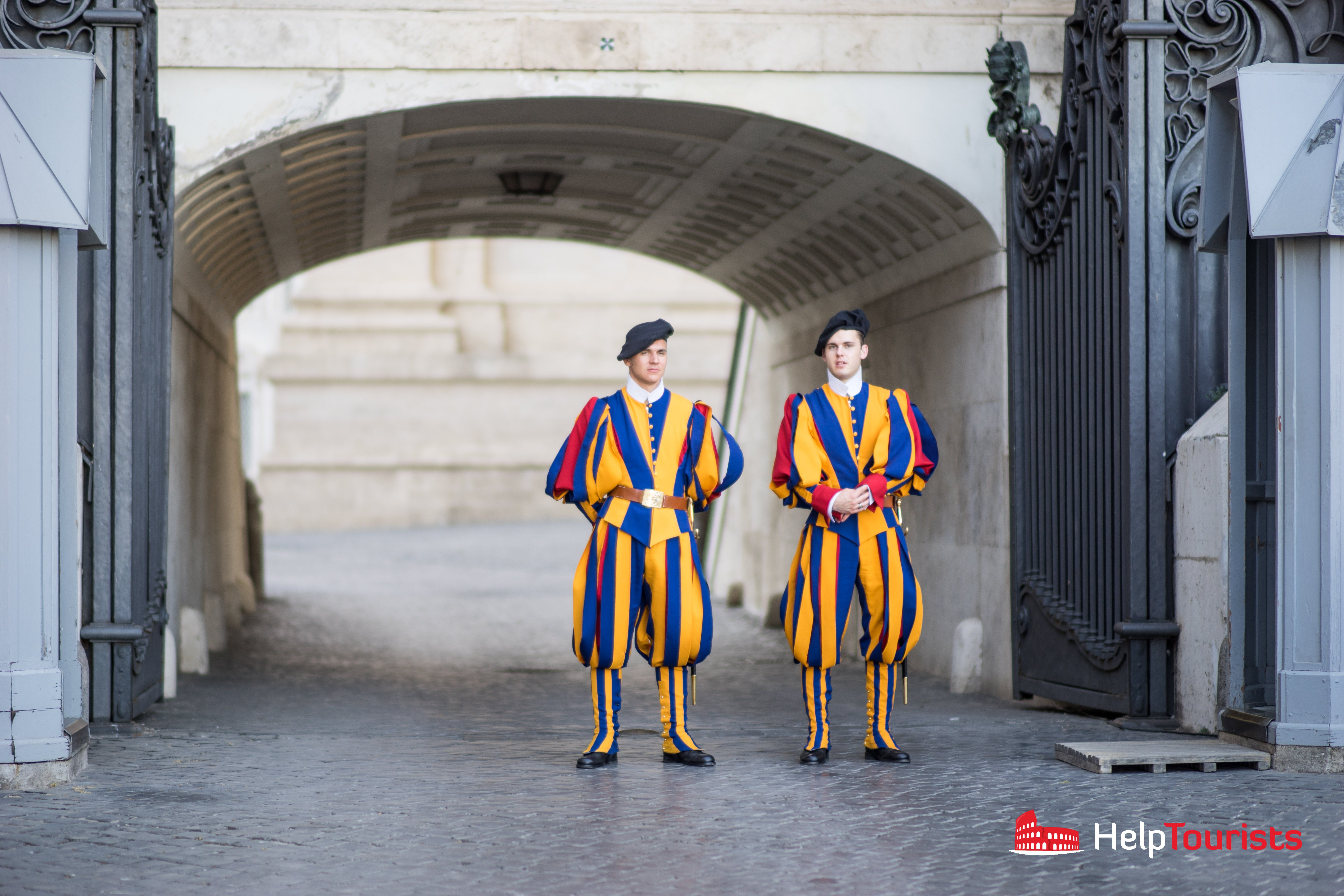
More than 5 million visitors come to the Vatican, St. Peter’s Basilica , the Sistine Chapel and the Vatican Museums every year. For many visitors the Vatican embodies the highlight of their trip to Rome.
Why the Vatican is so interesting for visitors
The Vatican is of interest to Rome visitors in two regards: They can marvel at St. Peter’s Basilica and its huge square, and on the other side visit the Vatican Museums with the Sistine Chapel.
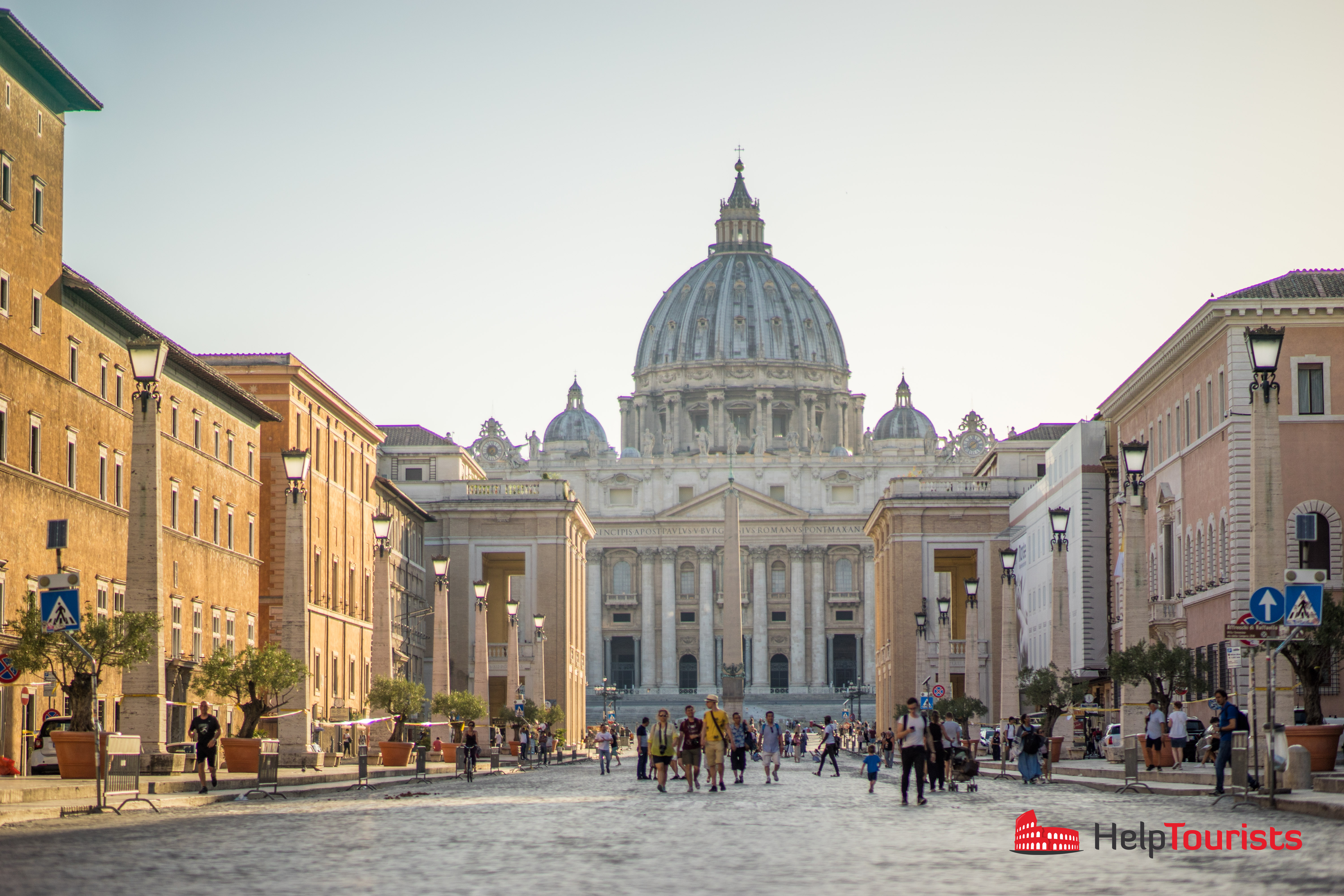
The Sistine Chapel houses world famous works of art. One artistic highlight is the “Creation of Adam”, an extract of the ceiling fresco made by painter Michelangelo, which depicts how God calls Adam into life with his pointed finger.
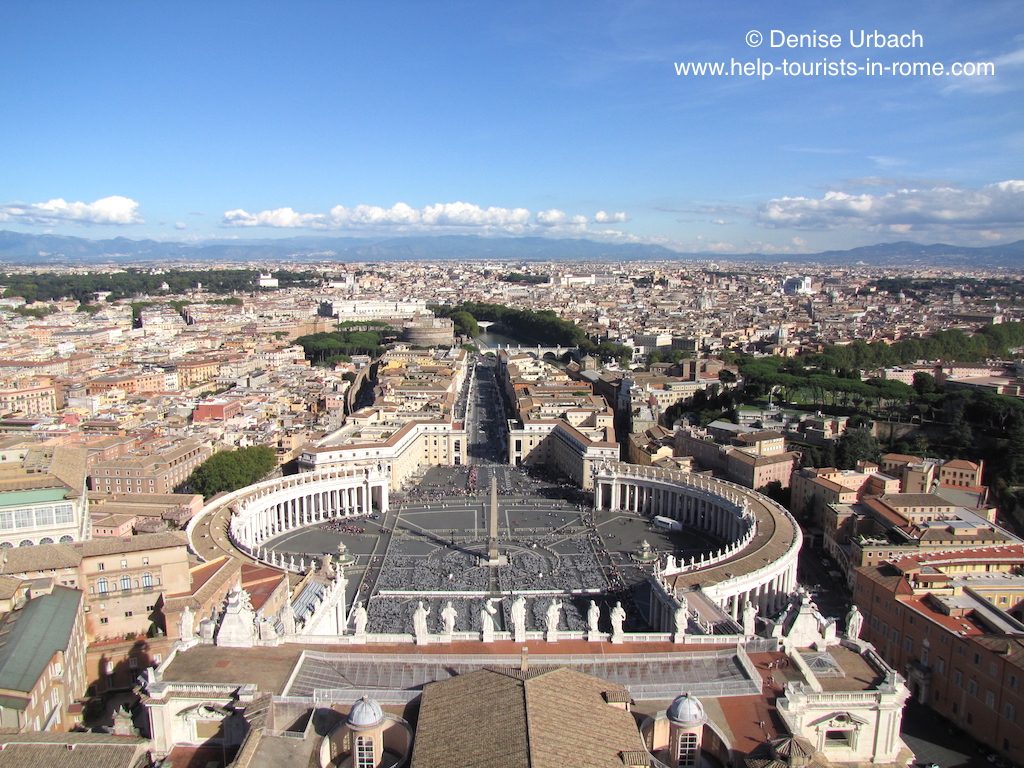
Furthermore, a visit to the dome of St. Peter’s Basilica is highly recommended when you come to the Vatican!
Vatican tickets without queuing up
There is always a rush in the Vatican. You can save a lot of time and book fast track tickets, Vatican tickets or private tours in advance online on GetYourGuide!
Best time to visit the Vatican in Rome
Best season to visit the vatican.
It’s not easy to say what the best season is to visit the Vatican. The last time I was in Rome was in August. Despite my fear of endless queues, it did not take very long to enter the Vatican after all.
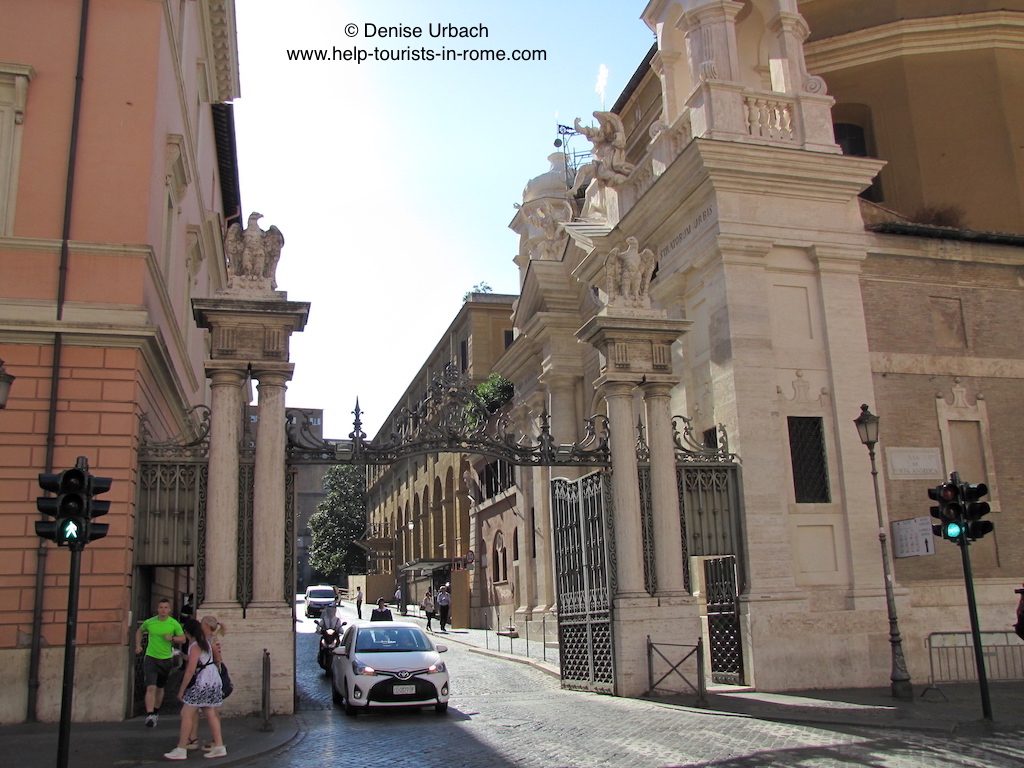
I can highly recommend a visit to the Vatican in the winter . The waiting time is rather short from November to February, except during Christmas and New Year’s Day – these are peak times in the Vatican.
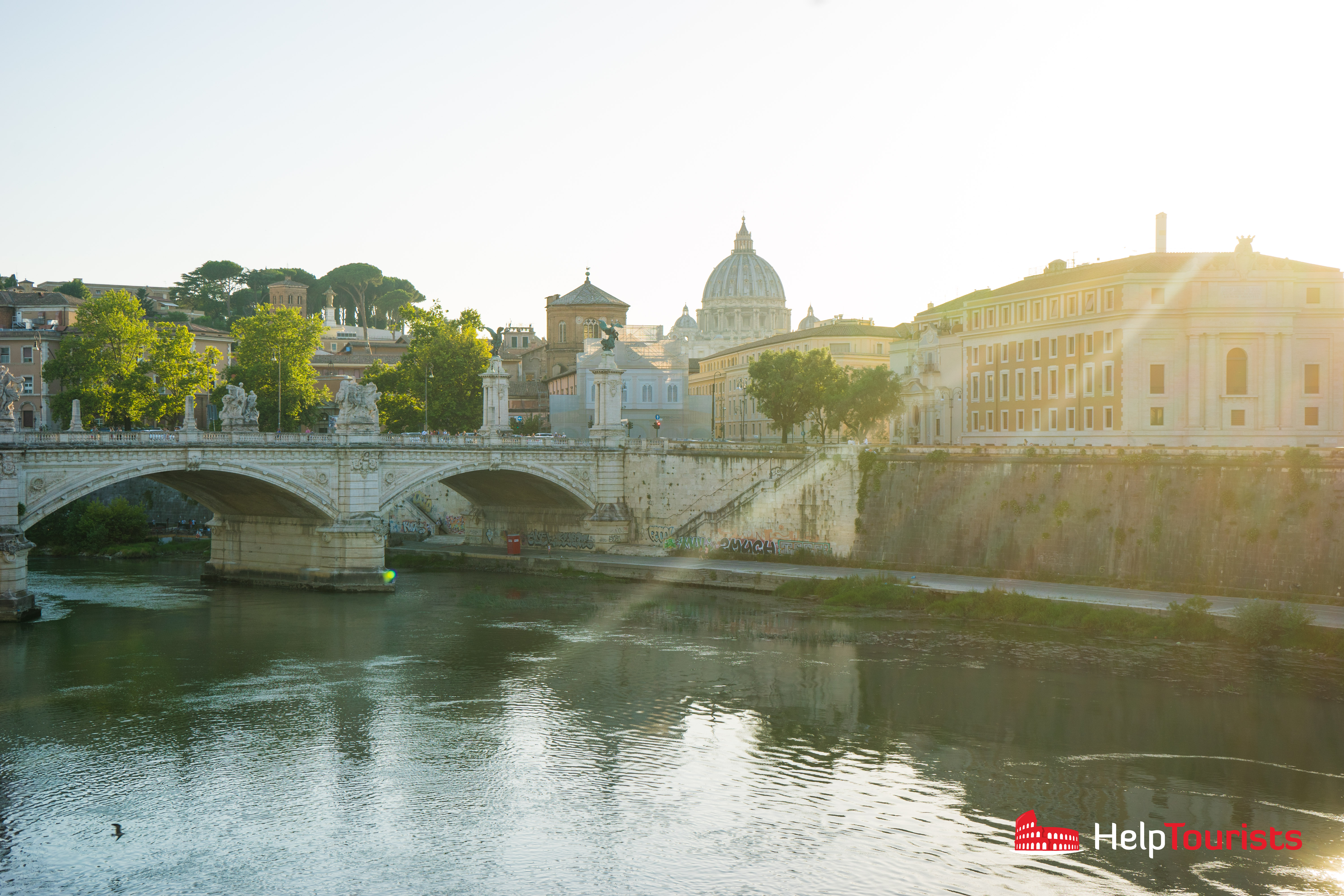
In the summer the Vatican is so congested that you don’t have time to look at all the details in St. Peter’s Basilica or the Sistine Chapel. You are pretty much carried along by the crowd and stopping is not really tolerated.
Best day to visit the Vatican in Rome
It’s best to visit the Vatican during the week because weekends are generally very busy. A good day to visit the Vatican is Friday . If you come to Rome in the summer you should use this day as the museums are open late from 7 to 11 pm . But keep in mind to register beforehand, regardless of the season!
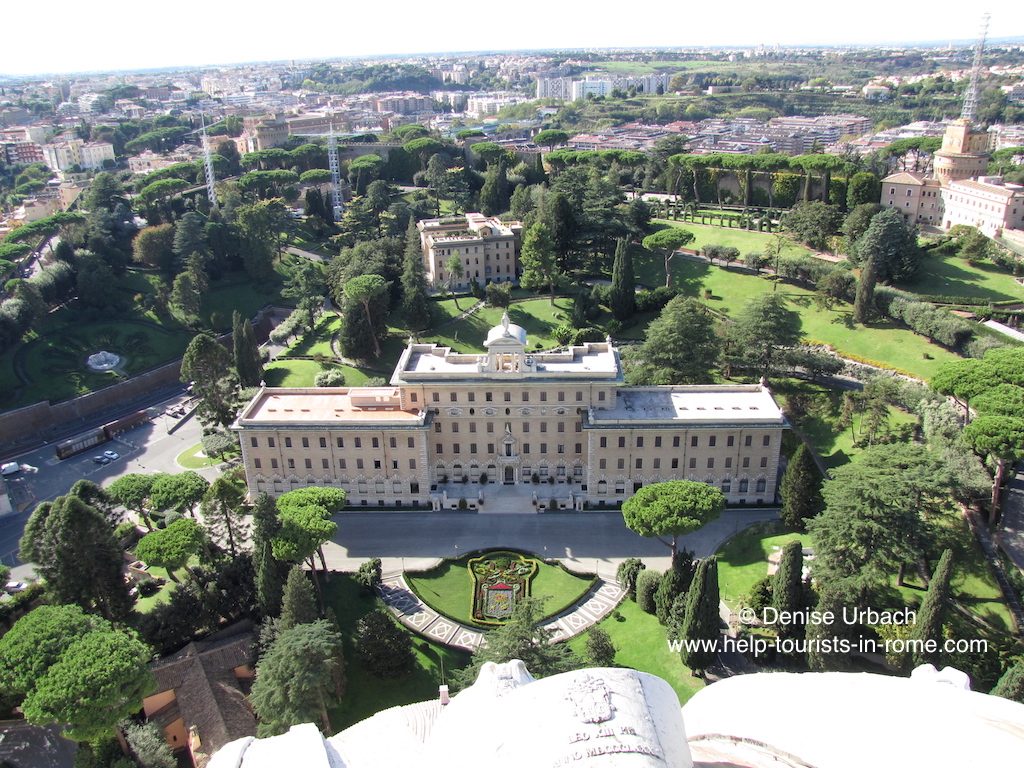
Wednesday is a rather bad day to visit the Vatican. If the Pope is in Rome, a general audience is held on Wednesdays at 10:30 am. This event attracts many believers.
Best daytime to visit the Vatican in Rome
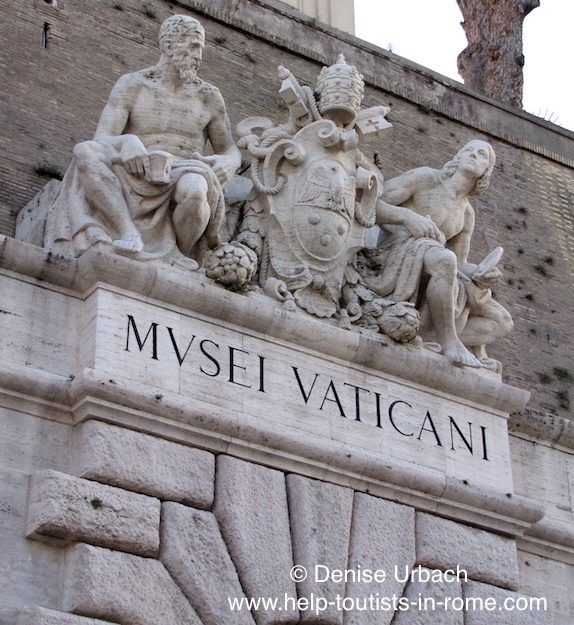
Duration of a visit in the Vatican in Rome
The visit duration in the Vatican depends on different factors. It may be more lengthy on busy days. Then, it also depends on your interests. Someone who inspects every detail will spend of course more time in the Vatican than someone who just wants to walk through St. Peter’s Basilica or the Vatican Museums and stop every now and then.

I think that a visit to the Vatican Museums and the Sistine Chapel will take 3 to 4 hours. Expect about one hour for St. Peter’s Basilica.
Dress code for St. Peter’s Basilica and the Vatican Museums in Rome
If you visit St. Peter’s Basilica and the Sistine Chapel in Rome, you should cover your shoulders and knees. This is the dress code if you don’t want to get rejected at the entrance. In addition, you should take off any cap before entering the Vatican Museums and St. Peter’s Basilica like you would in any other church.
St. Peter’s Basilica in the Vatican in Rome
St. Peter’s Basilica is the most important church in the Catholic Church and second to the Notre-Dame de la Paix basilica on the Ivory Coast in Africa in terms of size. St. Peter’s Basilica which embodies the center of the independent state of the Vatican City was built in the 15th century and consecrated after 150 years of construction. Today it is home to famous works of art such as the Pietà by Michelangelo, the Baldachin by Bernini, and one of the largest self-supporting domes in the world. St. Peter’s Basilica offers space for 20000 people.
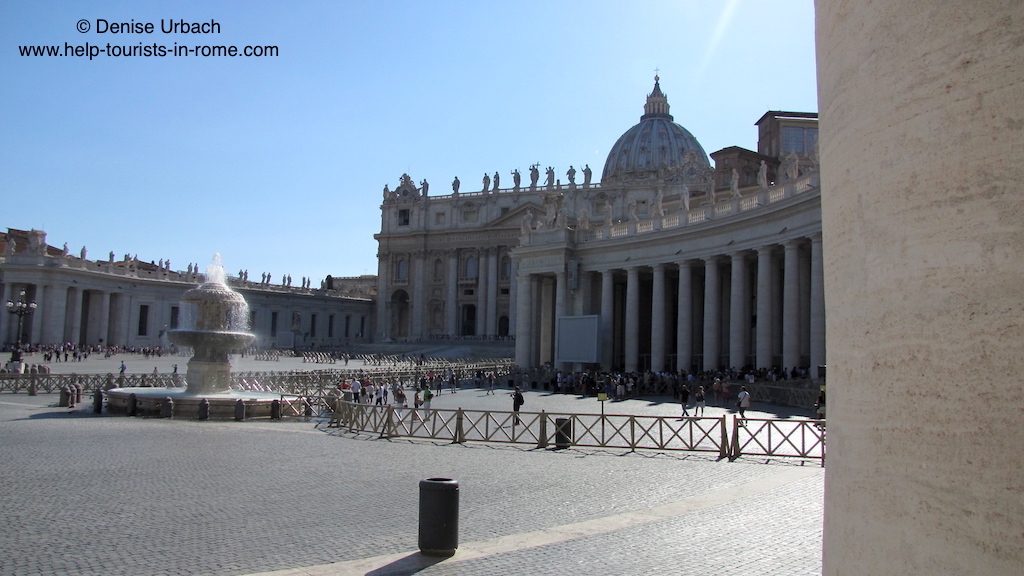
You should plan about an hour to visit St. Peter’s Basilica. It is best to visit the dome first because it will give you direct access to the basilica without waiting.
Vatican grottoes and the Vatican Necropolis
Underneath St. Peter’s Basilica are the Vatican grottoes and the Vatican Necropolis. Some popes are buried in the grottoes, but also men who played an important role in the Vatican. The Vatican Necropolis is an ancient Roman burial site where the tomb of apostle Peter is supposed to be found. The gravesite has been accessible again since the 1950s. To visit the Necropolis you need to book as soon as possible because entry is limited to 250 persons per day only. Visitors to the Necropolis must be at least 15 years of age.
St. Peter’s Basilica’s dome
Another highlight of St. Peter’s Basilica is the dome . It is accessible for visitors and offers a great view over the Vatican and Rome. Light conditions are especially good in the afternoon to watch over the city. You should plan at least one hour in the queue to visit the dome.
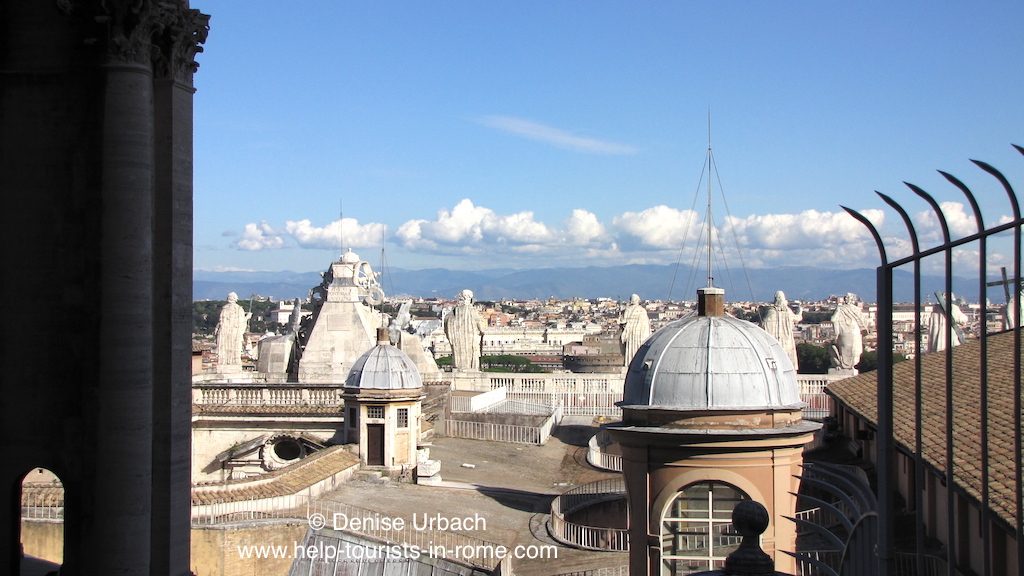
The waiting time depends on the weekday and daytime. Perhaps you are lucky and can avoid long queues. There are 551 stairs to climb by foot. With the elevator it’s only 320. For the way down you can either use the elevator or the stairs which are usually less busy.
Entry fees for St. Peter’s Basilica in Rome
Entry to St. Peter’s Basilica is free like in all other churches in Rome. If you want to climb the dome, it’s 7 euro with the elevator and 5 euro by foot. Entry to the Vatican grottoes is free. The Vatican Necropolis offers tours for 13 euro per person for a duration of 1.5 hour.
Opening hours of St. Peter’s Basilica in Rome
- St. Peter’s Basilica is open from April to September from 7 am to 7 pm, and from October to March from 7 am to 6:30 pm.
- The dome is accessible from April to September from 8 am to 8 pm, and from October to March from 8 am to 5 pm. Access is not allowed during ceremonies.
How to get to St. Peter’s Basilica in Rome
You can reach St. Peter’s Basilica via metro line A at “Lepanto” or “Ottaviano”, or by using the tramway 19 at “Piazza Risorgimento”.
The Vatican Museums in Rome
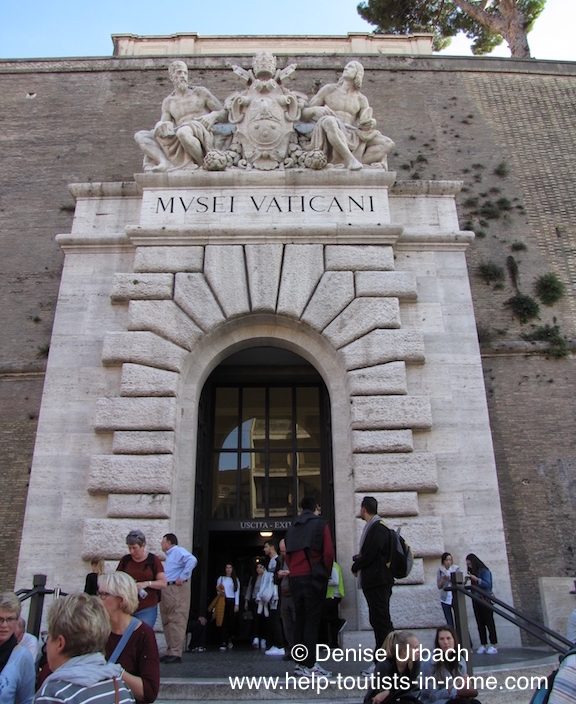
Opening hours & entry to the Vatican Museums and Sistine Chapel
Monday through Saturday from 9 am to 6 pm. However, last entry is at 4 pm. The museums are closed on Sundays, but open for free from 9 am to 12 pm on every last Sunday of a month .
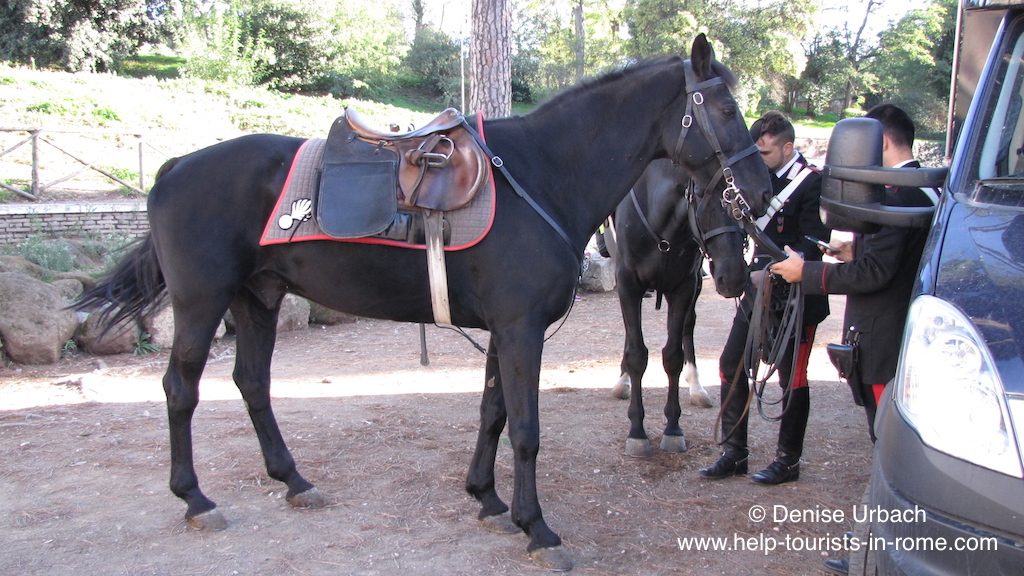
Many visitors are ready to wait for hours to get into the Vatican Museums. On days with high demand the queue may take up to 3 hours. Especially on Monday it can be very busy because it is the resting day for many museums in Rome. Wednesday is also very crowded because of the Pope’s audience. Saturday is another busy day. The best days to visit the Vatican and the Vatican Museums are Tuesday, Thursday and Friday . The museums are closed on Sundays, except on every first Sunday of a month: opening times are then from 9 am to 2 pm and entry is free.
Entry fees to the Vatican Museums in Rome
The entry fee for adults is 16 euro. Children between 6 and 18 years pay 8 euro and children under 6 years have free entry.
Vatican Museums in Rome without queuing up
To avoid long waiting lines, it is worth booking your tickets in advance. For a surcharge of 4 euro, you can buy tickets on the website of the Vatican Museums. Entry to the Vatican Museums is also included in the OMNIA pass as well as the Rome City pass by Turbopass.
How to get to the Vatican Museums in Rome
You can reach the Vatican Museums via metro line A at “Ottaviano” or by using the tramway to “Piazza Risorgimento”.
If you enjoyed this article, subscribe now to receive more just like it.

2 Reader Comments
Comments RSS Feed
Very helpful. Thank you!
Would like to visit Rome in November
Leave a Reply Cancel reply
Your email address will not be published. Required fields are marked *
Hi, I’m Denise, welcome to HelpTourists Rome!

Sightseeing Activities in Rome
Click on the button to load the content from getyourguide.com.
Load content
Best hotel room offers
Click on the button to load the content from booking.com.
OTHER CATEGORIES

Transportation
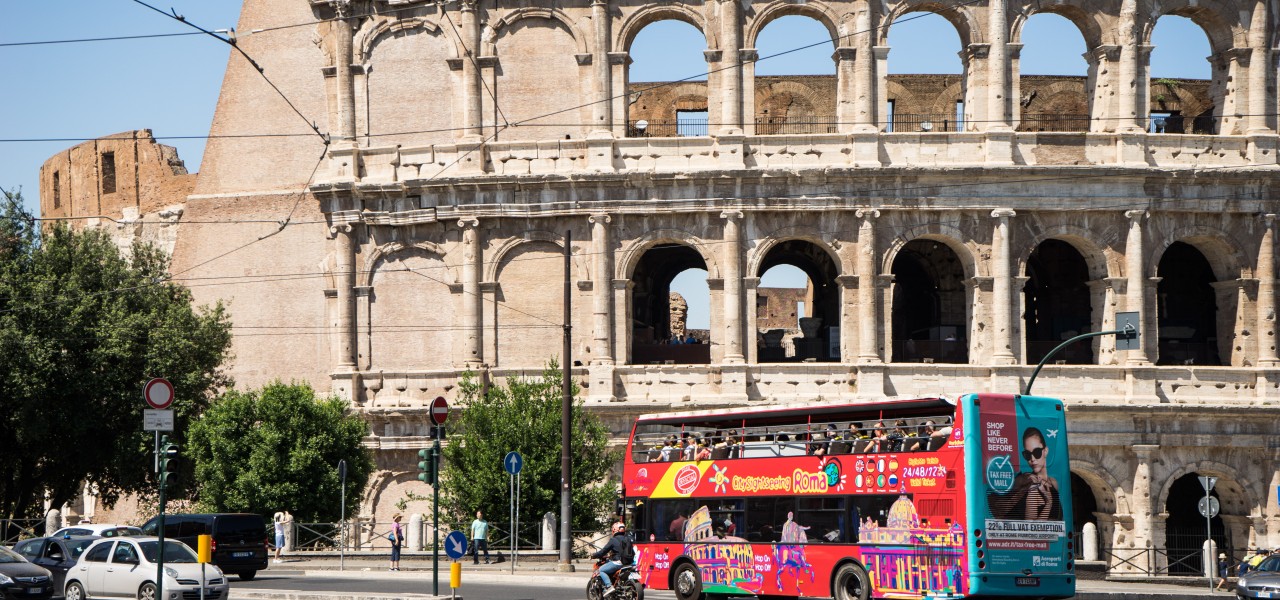
- Data Protection
- Cookie Preference

How to Buy Pantheon Tickets in Rome

How to skip the line at St Peter’s Basilica

How to skip the line at the Borghese Gallery

How to skip the line at the Colosseum – 2024

How to skip the lines at the Pantheon

How to skip the lines at the Vatican – 2024

Should I get a Roma Pass?

The best time of day to visit the Colosseum

The best time of day to visit the Vatican Museums | Opening hours 2024

The cheapest way to skip the lines at the Vatican | 2024

What are the official websites to buy tickets for Rome’s major attractions?

Vatican and Sistine Chapel tickets

How to get past Colosseum ticket buying problems – 2024

How do I travel to Rome from Fiumicino airport? 2024

How do I get into Rome from Ciampino Airport? 2024

How do I book train tickets around Italy?

Hop-on-hop off bus tours

August 15th is Ferragosto, a national holiday, and many things in Rome are shut

How do I buy a slice of pizza in Rome?

How do I buy cigarettes in Rome?

How do I mail a letter in Rome?

How do you use the bidet when on vacation in Rome?

How much cash to bring with you to Italy

How to buy vape supplies, e-cigarettes and juice in Rome

How to cross the street in Rome (and live to tell the tale!)

How to get English-speaking medical treatment in Rome

How to order a coffee in Rome

How to visit Rome with children

How to visit Rome’s Olympic Stadium

How to visit the mosque in Rome

The difference between St. Peter’s Basilica, the Sistine Chapel, and the Vatican

The difference between the Colosseum, Roman Forum, and Palatine Hill

What is the dress code in Rome?

What kind of electrical adapter do I need to bring to Italy?
What should I see if I have only one day in Rome?

Where are the best views of Rome?

Where can I buy a used bike in Rome?

Where can I find a wifi cafe in Rome to work in? 2024

Where can I run in Rome?

Where’s the bathroom in Rome?

12 reasons you shouldn’t drive a car in Rome

Avoid common problems with Rome’s public transport

Can I travel to Rome at the moment?

- Can I use Uber or Lyft in Rome? 2024

Getting to and from Rome Ciampino airport at night

How do I get to and from Fiumicino Airport (FCO) at night?

How to buy a ticket for Rome’s public transport system using an app

How to get from Rome’s Civitavecchia port into the city

- How to not get pickpocketed

How to use Rome’s public transportation network – with map – 2024

Rome’s “secret” train that gets you across the city in 20 minutes – for only 1 euro

Scooter sharing: renting an electric scooter in Rome
The best way to get from the airports into Rome (and back again)

Aperitivo: Rome’s low-cost drink and food extravaganza

Become a Spritz Specialist and a Pasta Pundit

Beer in Rome

Do I need to tip in Rome?

Food tour in the heart of Rome

Hooch and History: the Tipsy Tour of Rome

How to avoid being ripped off at a tourist trap restaurant in Italy

How to cook perfect pasta

How to eat gluten free in Rome

How to eat vegan and vegetarian in Rome

How to use an Italian stovetop coffee pot

Pasta and Tiramisu class

The truth about sandwiches in Rome

What to order in a restaurant in Rome

What’s the difference between a Ristorante, an Osteria, and a Trattoria?

Why you never need to buy water in Rome
- Where to stay in Rome

Colosseum Arena tour with Forum and Palatine Hill

How to visit the Coppedè Quarter in Rome

Off the beaten track to see the beaten track: Via Flaminia Antica

Orientation tour: self-guided piazza walk

Rome Vacation Tips Eternal City Night Walk

Rome Vacation Tips guided walk of the Baroque City

Rome Vacation Tips tour of the Colosseum, Forum, and Palatine Hill

Rome Vacation Tips VIP Vatican Tour

Self-guided walking tour around the ancient city

Terrifying ghost tour of haunted Rome

The Popes, Domes, and Tombs Tour of St Peter’s

Where can I see Caravaggios for free in Rome?

Basilica di San Clemente: the most interesting historical site in Rome

Guided Modern Architecture Tour Of Rome

Guided Street Art Tour in Rome

Rome’s other “Jewish ghetto”

San Lorenzo in Miranda – a church in a temple

The optical illusion of St Peter’s Basilica from Via Niccolò Piccolomini

Villa Torlonia: ersatz architecture and Mussolini’s home in Rome

Where can I see street art in Rome?

Can I splash in the fountains in Rome?

How to avoid the African bracelet scam

How to get a Covid test in Rome with English language certificate – 2024 update

Special rules for visiting the Vatican during the coronavirus pandemic

What to do in Rome in an emergency

What’s with all the trash in Rome?

Why do shopkeepers in Rome never seem to have any change?
- Book train tickets around Italy
- Day trip to Tuscany
- Day trip to Pompeii
- Things to do in Florence
- Things to do in Milan
- Things to do in Naples
- Things to do in Tivoli
- Things to do in Venice
- How to Vacation in Dublin
- How to vacation in Istanbul
The Vatican Museums get notoriously crowded, especially during high season in Rome.
Unlike other attractions in Rome, the Vatican does not impose a maximum number of visitors at any one time, so the many miles of museum corridors can sometimes become extremely packed – sometimes to a scary degree.
Not just that but the experience many have of the Sistine Chapel can be ruined by the swollen crowds of people shuffling along craning their necks up to the ceiling while guards hiss at them to shut up or stop taking photographs.
We therefore recommend that you time your visit so you can avoid such concerns, and have as peaceful and undisturbed view of the museums as possible

Vatican museums key info
Opening hours
Monday – Saturday: 9 am – 6 pm (last entrance at 4 pm) Sunday: closed (except the last Sunday of every month when the museums are free)
Museum closed on the following days In addition to most Sundays, 1 January, 11 February 19 March, 22 April, 1 May, 29 June, 14 and 15 August, 1 November, 25 and 26 December See the best time to visit the Vatican Museums >
Nearest metro: Ottaviano (Linea A)
If you’re in a hurry:
Our top tip for the best time to visit the Vatican is the 7.30 am VIP entrance ticket . An unmissable opportunity to see the museums and the Sistine Chapel with no crowds.
What’s the best time of day to visit the Vatican?
The best time of day to visit the Vatican is as early as possible . See Vatican opening hours in “key info” on this page.
Visiting the Vatican early in the morning gives you the chance to view the marvels of ancient and Renaissance Rome – and the peerless Sistine – without being shoved and crowded.
If you want a regular Vatican ticket (also available with audio guide ) then when you book your Vatican ticket you will be offered a choice of time slots. Choose the earliest one possible – 9am is the official opening time.
But better still, choose the 7.30 am VIP entrance ticket . This special ticket gives you access to the place before the crowds: you have the halls and rooms almost completely to yourself – including a once-in-a-lifetime chance to view Sistine Chapel with no crowds shoving you, or guards telling you to be quiet. Unmissable.
We also suggest, if you can’t find a time and date early enough, that you still consider visiting despite the crowds, by taking one of our VIP Guided Tours with a hand-picked tour partner who will help you negotiate the halls without stress.
How long should I allow for a Vatican Museum visit?
Whichever time you choose, allow around 3 hours minimum for your visit. There are cafes inside the museums for a drink and a sandwich if you get tired. Add another hour if you want to visit St Peter’s too.
Note that because it is a religious institution the Vatican is closed most Sundays, and on other holy days (full list in “Key info” on this page). It’s free on the last Sunday of the month – but we recommend avoiding it then as it becomes even more crowded.
- Basic skip-the-lines Vatican ticket
- Papal audience (Wednesdays) + St Peters guided tour
- ‘Omnia’ Vatican and Rome entrance and travel card
- Vatican and Sistine Chapel group guided short tour (2 hours)
- Vatican and Sistine Chapel group guided tour (3 hours)
Now make sure you don’t miss out: plan your visit in advance:
| Plan your vacation
| emergency.
Read this now >
| Book your hotel
| popular articles.
- How to use Rome’s public transportation network – with map – 2024
- How to skip the lines at the Vatican – 2024
- How to skip the line at the Colosseum – 2024
| Recent articles

Related posts

This website uses cookies to ensure you get the best experience on our website.

Photo credit: AFP
Tickets in advance!
Because of ticket supply problems following the end of Covid restrictions, it is strongly advised that you buy tickets and tours in advance to visit attractions in Rome.
Buy your tickets now to avoid disappointment.
Accessibility Links

Best time to see the Vatican
Plan a visit to the world’s smallest nation, home to artistic wonders – and the pope.

E nveloped by the Eternal City of Rome , the Vatican is the world’s smallest state. Measuring just 0.17 square miles, it bursts with cultural treasures that bely its tiny size. There’s an embarrassment of artistic masterpieces on show in the museums here, including works by Raphael and Leonardo da Vinci. Providing reason alone to visit are Michelangelo’s frescoes on the ceiling of the Sistine Chapel , showing scenes from the Old Testament. And there’s the extraordinary St Peter’s Square, flanked by colonnades and overlooked by the domed St Peter’s Basilica . Follow our tips to make the most of your visit — and, who knows, maybe you’ll bump into the Pope, the Vatican’s most famous resident.
Main photo: Swiss Guard in the Vatican (Alamy)

As the most popular tourist site in Rome, there’s never really a quiet time to visit the Vatican. To bypass the heaviest crowds, avoid weekends and school holidays and choose the winter months over summer (though do stay away over Christmas). Unless you’re here to see the Pope, steer clear of Wednesdays, when he gives a papal audience. Tour buses tend to descend in the mornings, so pick an afternoon for an independent visit. A great option if you’re here between April and October is to book a guided after-hours tour — it’s more expensive than visiting during the day, but tickets are limited and thinner crowds are therefore guaranteed.
It’s deliberately poorly advertised, but the Vatican Museums also welcome locals — Roman residents like to visit on uncrowded Friday evenings, when live music, drinks and nibbles accompany the stunning artworks. Between May and October (except August when it’s high season) the most popular galleries in the Museums — the Raphael Rooms and the Sistine Chapel — open for limited numbers who pre-book entry tickets. These nights are also the only time you can get into the normally shut St Pius V rooms — filled with medieval and Renaissance ceramics and miniature mosaics — unless you take a private tour. Looking for a freebie? The museums are closed on Sundays, but the last Sunday of every month from 9am to 12.30pm has free entrance.

What to see
The Vatican Museums hold many famed masterpieces, but is viewing them really that great when you’re doing so over someone else’s shoulder? Crowds huddle around the likes of the Laocoön and Belvedere Torso in the Museo Pio Clementino — in the process abandoning less-lauded, but equally spectacular exhibits such as the 5th-century BC Attic vases (Achilles and Ajax playing dice, Oedipus solving the riddle of the Sphinx). The famous Raphael Rooms are usually such a scrum that it’s hard to do them justice: skip them for the quieter Pinacoteca, home to Raphael’s magisterial last painting, The Transfiguration , along with Caravaggio’s startling Deposition , Giovanni Bellini’s unusual Pietà and Leonardo’s St Jerome . There’s so much good stuff to see, you won’t be sorry you missed the so-called headliners.
Advertisement
Everyone can descend into St Peter’s Sacred Grottoes to visit the tombs of the popes, but few realise there’s yet another exclusive layer under the Grottoes. The Scavi is a pristine collection of pagan and Christian tombs dating back to the second century, full of colourful frescoes and mosaics, including one of the very earliest depictions of Jesus. But for preservation purposes, only 250 people a day can visit, so you have to plan ahead. Contact the Scavi Office as soon as you know your travel dates.
Which tour to book
Most people think they need to splash out for a good tour of St Peter’s and the Vatican — but the best one is, in fact, free. On weekdays from mid October to late May, the highly knowledgeable (and highly entertaining) student priests of the Pontifical North American College run free guided tours in English (the exception is certain holy days and school breaks). You don’t even have to book: just turn up at the information office on the left of the basilica a few minutes before the 2.15pm start time and look out for the young priest with an American accent.

How to beat the queues
Every day up to 25,000 people descend on St Peter’s Basilica, the epic Renaissance centre of Catholicism, and the masterpiece-packed galleries of the neighbouring Vatican Museums. Since they’ve all read the same guidebooks, most arrive early in the morning to tackle the galleries first, hence the queues snaking round the block. Don’t join them — instead, go straight to St Peter’s, and the ticket counter on the right side of the façade. You’re going to begin your visit with the church’s must-visit dome. By afternoon it’ll be heaving, but at the 8am opening time you’ll have it all to yourself. Afterwards, follow the exit signs, which lead to a well-earned cappuccino at the secret rooftop café. From here, you can exit straight down into the nave to visit the basilica, beating the crowds at the entrance. After lunch, visit Vatican Museums around 2pm — by the time you reach the iconic Sistine Chapel, close to the 6pm closing time, it’ll be relatively empty. Don’t forget the strict dress code either: men must wear long trousers and women must not have either bare shoulders or skirts shorter than knee length.
It’s a 20-minute hike from the Vatican Museums exit back to St Peter’s — unless you know about an exclusive short cut. In the far right corner of the Sistine Chapel, a door marked “tour groups only” leads directly to the basilica. Depending on how busy the guards are (they spend much of their time scolding: “No photos! No photos!”), chances are they’ll miss you if you tag along behind one of many tour groups — look attentive, as if you belong.
Where to eat
Tourist traps encircle Vatican City, some charging the earth for a panini. But you don’t have to schlep halfway across the city to find good food. Guidebooks will say the Museums’ self-service restaurant is the best local option, but wander a little way and you’ll do far better outside. A ten-minute walk from the Museums’ entrance, you can try some of Rome’s most delicious pizza al taglio (tray-baked and sold by the slice) at the Bonci Pizzarium. Or, for a proper, sit-down, non-rip-off pasta lunch, try Osteria delle Commari , on a side street north of the Museums, where only those in the know venture.
Best hotels in Rome
The best luxury hotels in Rome
Best luxury villas in Italy
Sign up for the Times Travel Newsletter here .
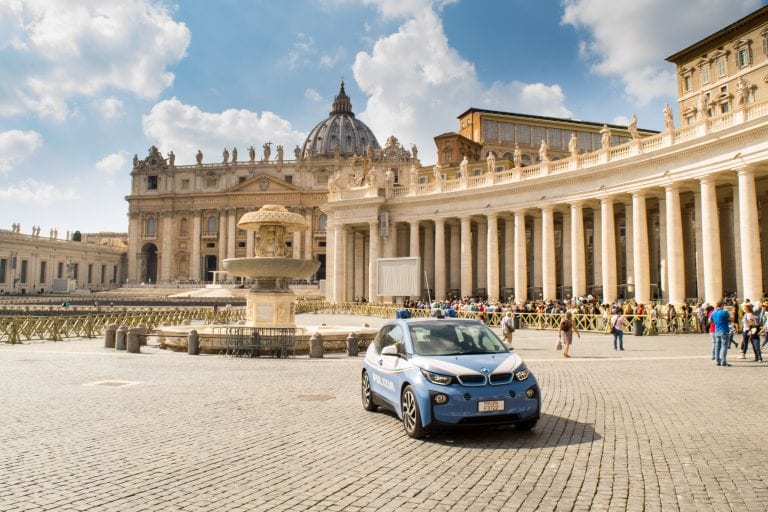
The Ultimate Guide to Visiting the Vatican: Tips, Tricks + FAQ!
Planning a trip to Vatican City and not quite sure where to start? Home to several incredible sights, a strict dress code, some of the most famous works of art on the planet, and enormous crowds, visiting the Vatican for the first time can be a bit overwhelming.
In other words, visiting the Vatican packs quite the punch considering that Vatican City is the smallest country in the world!
Here’s everything you need to know about visiting the Vatican, from the best way to enjoy the museums to when to go to exactly what to wear.
Table of Contents
What to See When Visiting the Vatican
Important tips for visiting the vatican museums, should you take a vatican museums tour, all about visiting st. peter’s basilica, how to get to vatican city, faq about visiting vatican city.
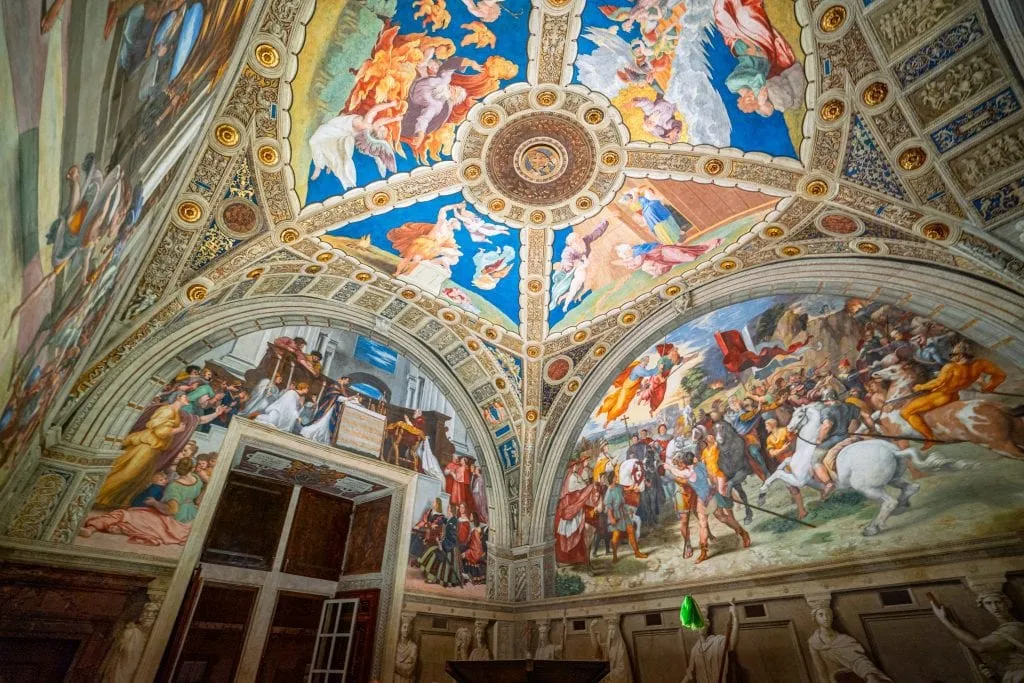
Some links in this post may be affiliate links. If you make a purchase through one of these links, we may earn a small commission at no extra cost to you. Please see our disclosure policy for more detail.
When visitors talk about visiting the Vatican, they’re most commonly referring to visiting the Vatican Museums and St. Peter’s Basilica, but visiting Vatican City can easily extend beyond those popular sights.
Here are the parts of Vatican City to consider when planning your visit, from the incredibly popular to the fairly niche.
St. Peter’s Square
St. Peter’s Square is the easiest part of the Vatican to visit–you can simply walk in and admire the beautiful oval square and exterior of St. Peter’s Basilica without any advance planning.
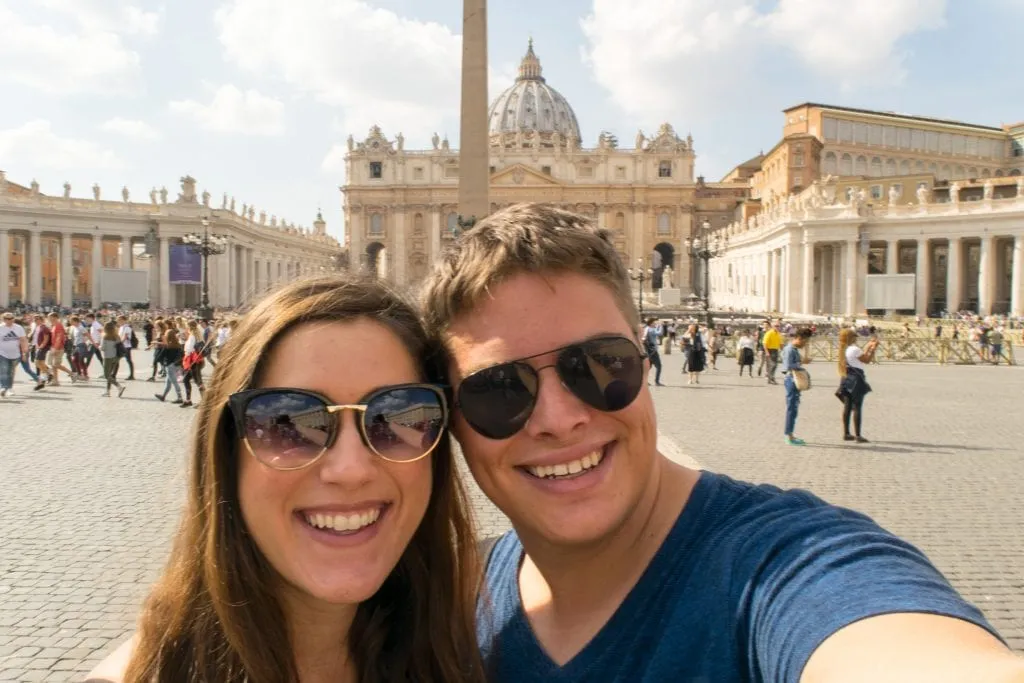
The Vatican Museums
The Vatican Museums are home to some of the most incredible works of art in the entire world, including Raphael’s most famous frescoes and the Sistine Chapel.
You will need a ticket or tour to visit, and when people talk about how long the lines are to get into the Vatican, they’re most commonly referring to the lines for the museums–we’ll cover more on that in the next section of this Vatican City blog post.
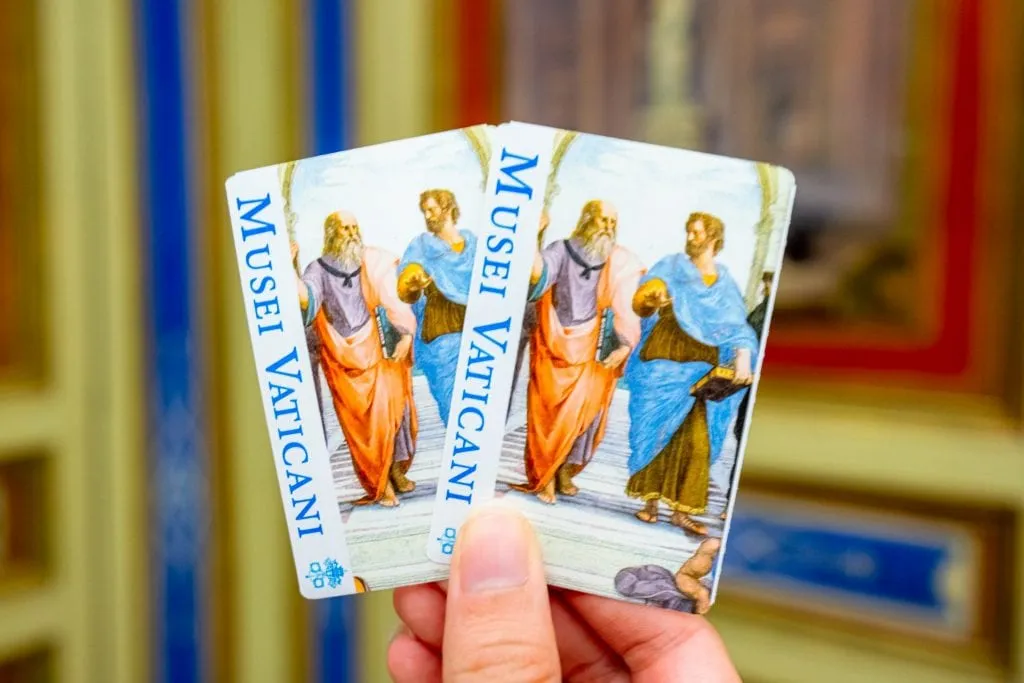
The Sistine Chapel
The Sistine Chapel, with its magnificent ceiling painted by Michelangelo, is one of the most well-known houses of worship on the planet.
It is accessed through the Vatican Museums and cannot be visited separately.
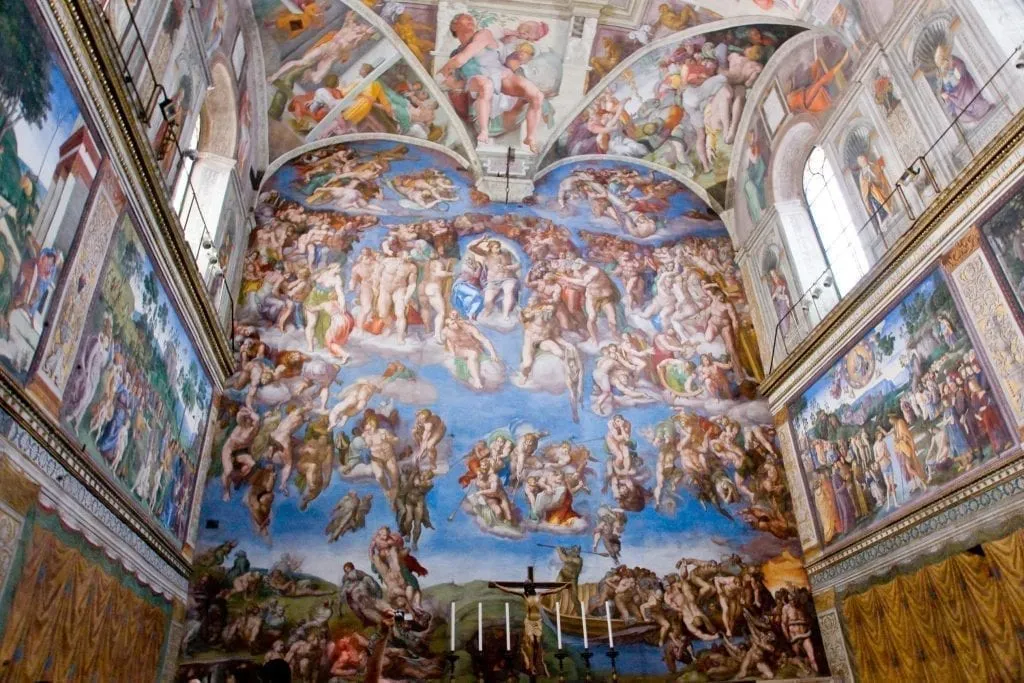
St. Peter’s Basilica
St. Peter’s Basilica is the largest church on the planet, and a masterpiece of Renaissance architecture (Michelangelo and Bernini both contributed to its design).
It is free to visit, but you will need to pass through a security checkpoint to enter, and the lines for that can get very long.
You can also visit the dome of St. Peter’s Basilica (unlike visiting the basilica itself, climbing the dome does require a ticket–more on that below), and from there you can admire incredible views of St. Peter’s Square.
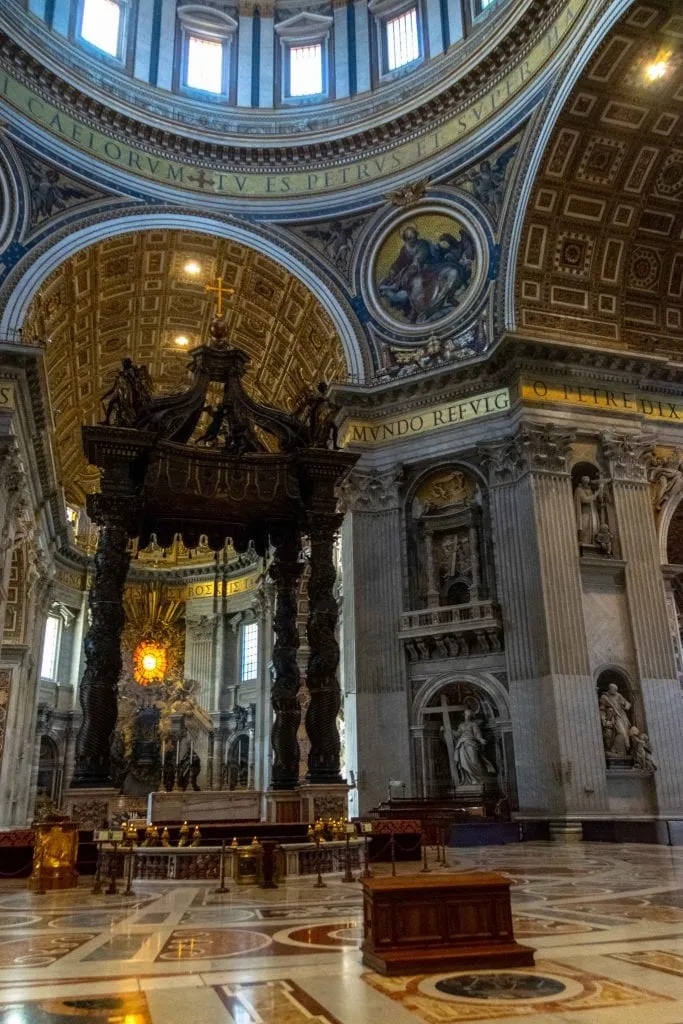
Vatican Necropolis
The Vatican Necropolis (or “scavi”) lies below St. Peter’s Basilica–and even below the “grotto” area that is also under St. Peter’s Basilica.
This area was a cemetery dating back to the first century, and, most importantly to Christian history, it is the presumed resting place of St. Peter himself.
Tours are required and absolutely must be booked in advance. If you’d like to tour directly with the Vatican, there are directions for how to email them (yep, it’s done by email!) here .
Alternatively, this well-reviewed tour will allow you to visit the Vatican Necropolis and is much more straightforward to arrange.
Check availability and book your Vatican Necropolis tour today!
The Vatican Gardens
The Vatican Gardens are beautiful and exclusive–only a handful of reservations are accepted per day (so like the Necropolis, you absolutely must plan ahead), and therefore they are never crowded.
Like the Vatican Necropolis, the Vatican Gardens must be visited as part of a tour like this .
Book your Vatican Gardens tour today!
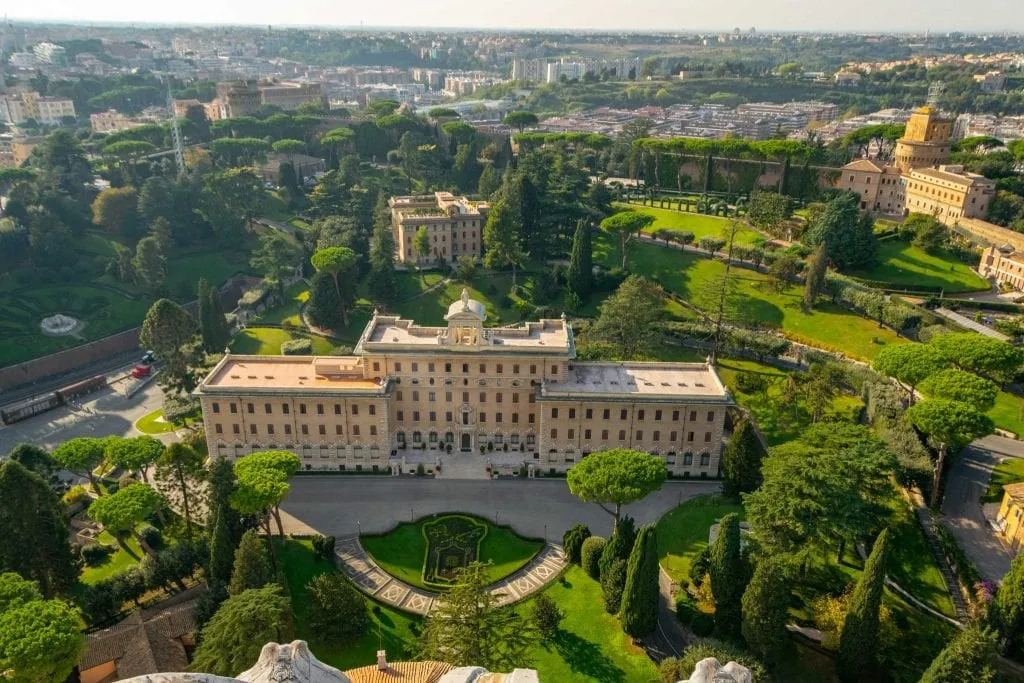
Papal Audience
When the Pope is at home in Vatican City, he gives an audience each Wednesday morning in St. Peter’s Square that is open to anyone who would like to join.
Tickets are free but must be booked in advance .
The Vatican Museums house the largest private art collection in the world–and despite the enormous amount of art and historical artifacts displayed, only the tiniest sliver of the complete collection is on display to the public!
Beautiful, overwhelming, and one of the most highly sought-after art museums in the world, visiting the Vatican Museums can be a bit of an intense experience.
Here’s what to know before you go.
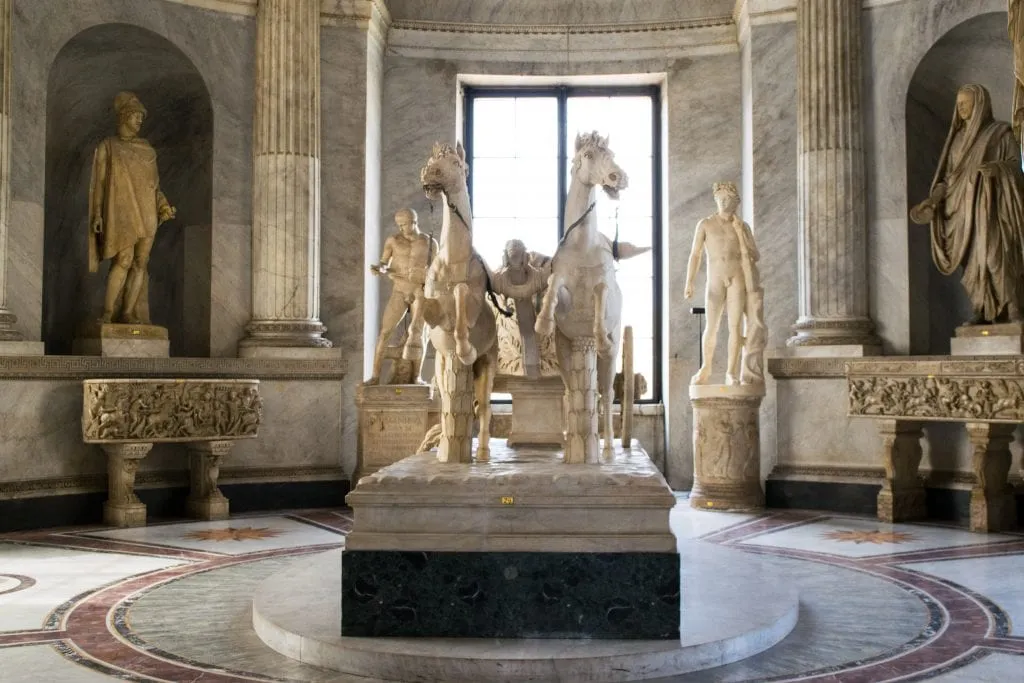
Don’t rush to the Sistine Chapel.
I know on our first visit to the Vatican Museums, we were highly anticipating the Sistine Chapel and always hoping it was coming up soon… but it’s one of the last things you see, so be sure to appreciate everything along the way!
Plan to spend at least two hours in the museums.
Three is even better, but it is hard to visit the Vatican Museums in less than two hours without simply making a beeline for the Sistine Chapel and not paying attention to much else.
Once you add in time to get there, security checks, potentially waiting in line, and maybe visiting St. Peter’s Basilica and St. Peter’s Square, it’s best to consider visiting the Vatican at least a half-day commitment if you’re going to be touring the museums.
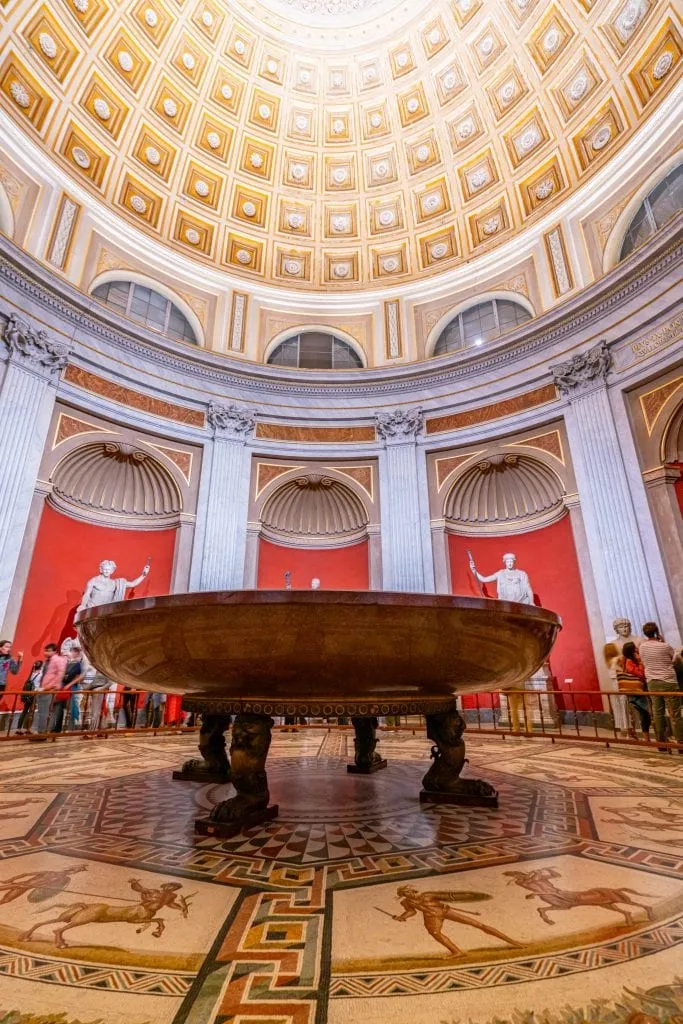
Strongly consider booking a guided tour.
Guided tours add so much context to a Vatican Museums visit, and offer the opportunity to learn so much about the history of the art in the museums. They also make visiting the Vatican far less stressful from start to finish.
We’ve visited the Vatican Museums both independently and with a guided tour, and after experiencing both, strongly recommend a tour.
This is the tour we took and loved, and this is another great option .
Book your Vatican Museums tour today!
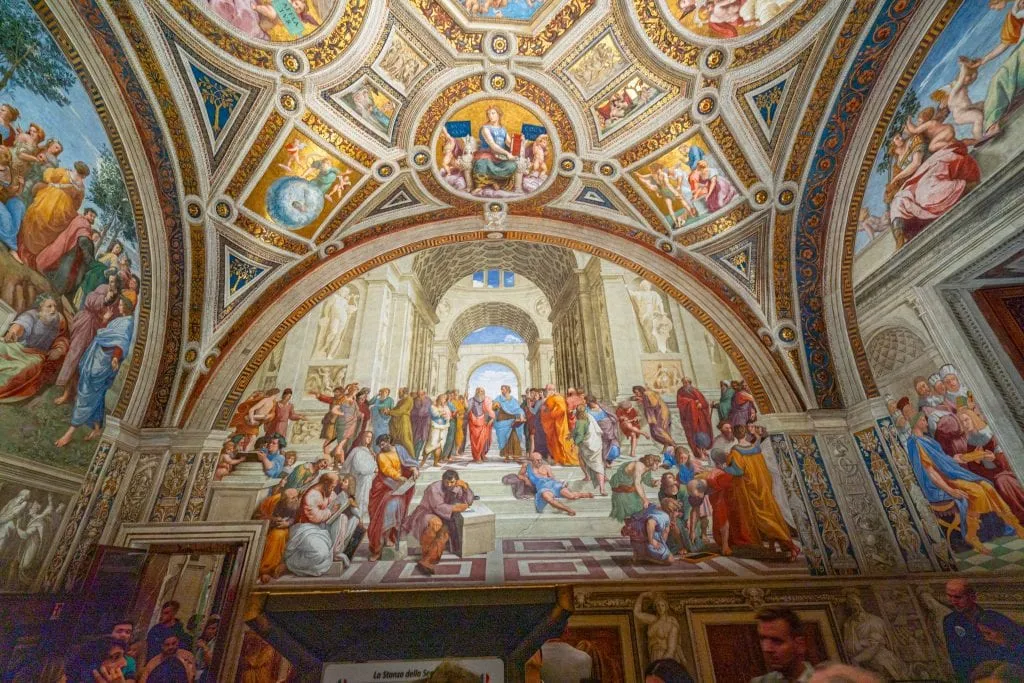
… and at the very least, absolutely book skip-the-line tickets.
Absolutely don’t want to take a Vatican Museums tour, or just don’t have the budget for it?
That’s completely understandable. In that case, we recommend booking skip-the-line tickets (ideally these early-access ones , but skip-the-line tickets for the normal operating hours are very helpful as well).
I’m not exaggerating when I say that the lines to access the Vatican Museums are the worst we have ever seen at any museum in the world.
During one of our longer trips to Rome, we stayed just beyond the Vatican Museums for a solid month and walked past the line for the museums almost every day–and as mid-October turned into mid-November, the lines remained incredibly overwhelming.
Grab your first-access skip-the-line tickets or general admission skip-the-line tickets for the Vatican Museums now!
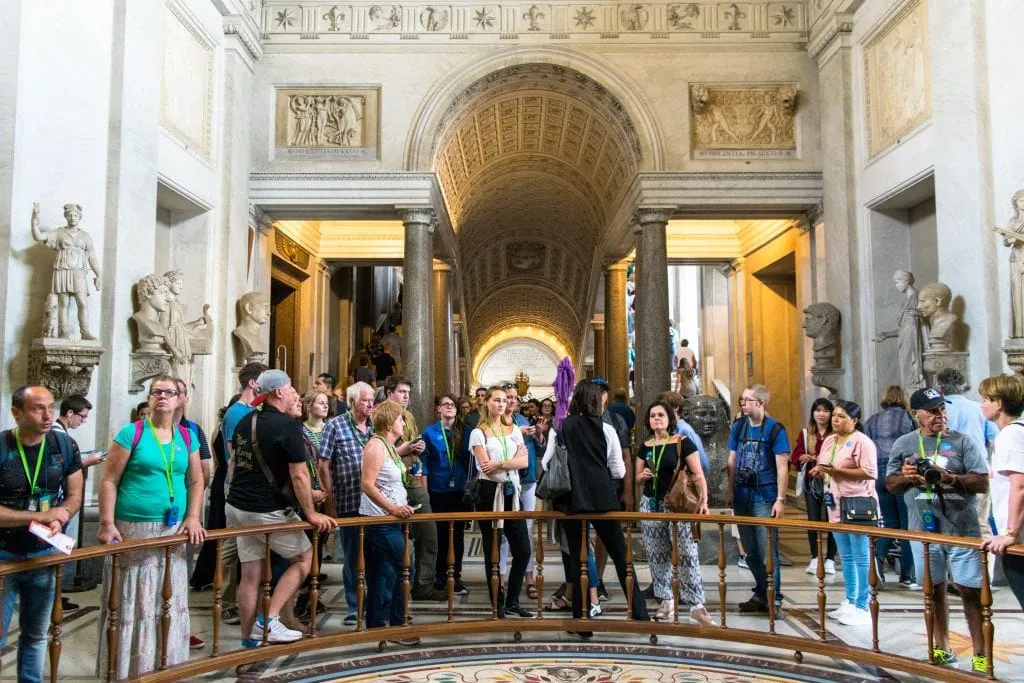
Keep in mind alternative hours.
The typical opening hours for the Vatican Museums are Monday – Saturday from 9:00 AM to 6:00 PM (with the last entry at 4:00 PM).
However, there are a few ways to access the Vatican Museums outside these hours if you’d like to mix up your visit!
Early Morning VIP Entry
With early-morning entry, either via pre-booked tickets for an independent visit or via a tour, you can enter the Vatican Museums as early as 7:30 AM, therefore avoiding the worst of the crowds (and during warm weather, the worst of the heat).
This incredibly popular tour a tried-and-true early morning option for touring the Vatican Museums!
Book your first-access Vatican Museums tour or skip-the-line tickets today!
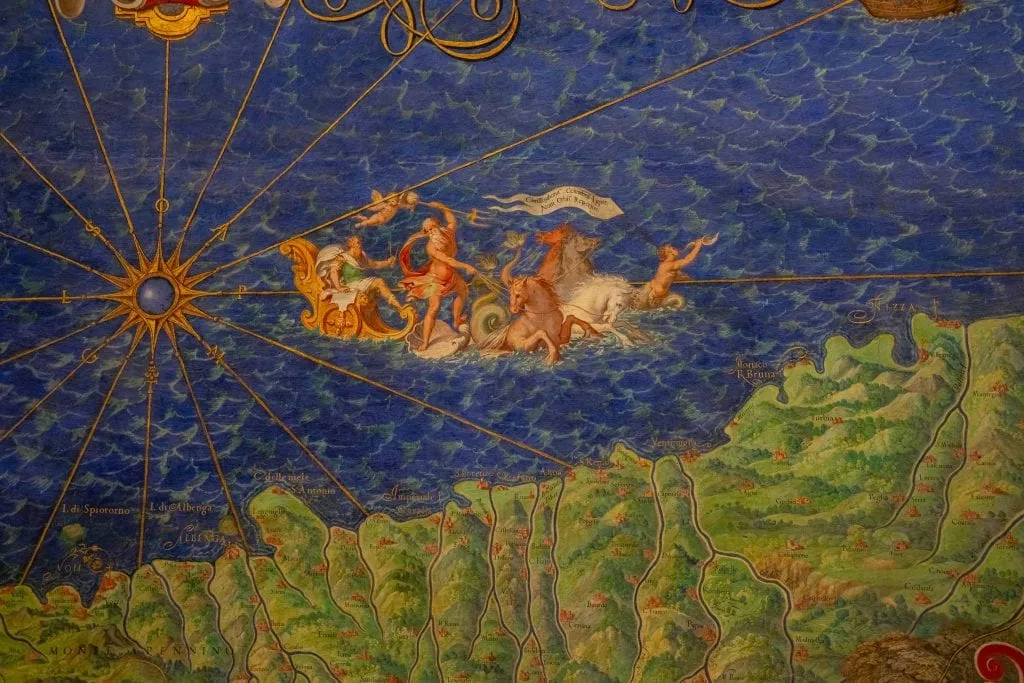
Friday Nights Between April and October
For seven months out of the year, the Vatican Museums are open on Friday nights until 11:00 PM (last entry at 9:30 PM), and we can personally attest that visiting the Vatican Museums at night is an incredible experience (and far less crowded than general entry hours).
We took this amazing tour on a Friday night and loved it!
Book the Friday night Vatican Museums tour we loved today!
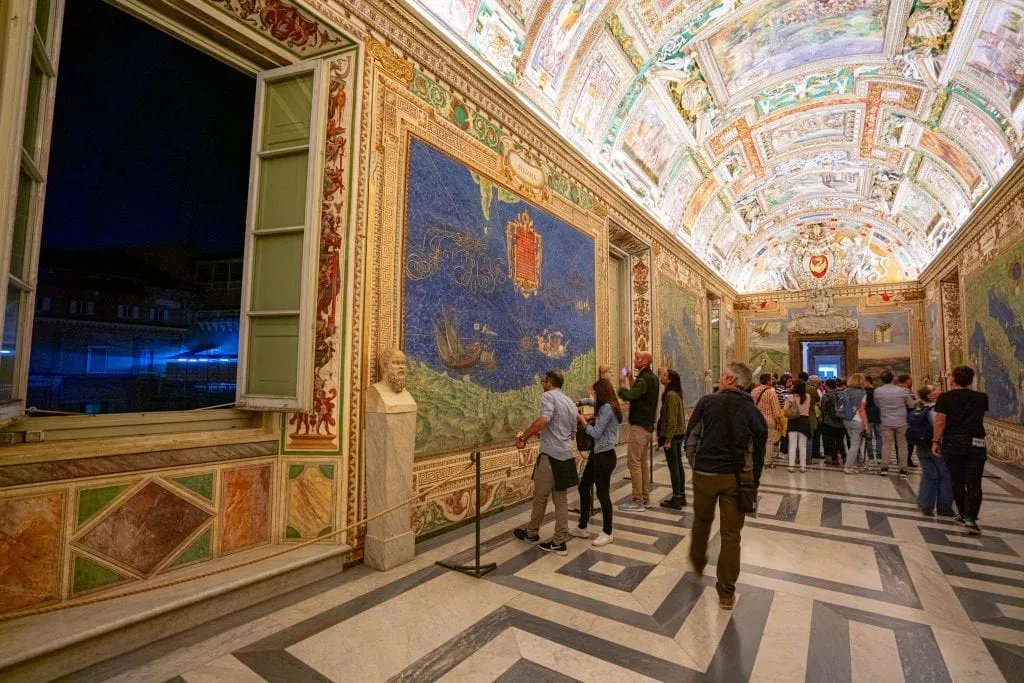
Last Sunday of the Month
The Vatican Museums are typically (and unsurprisingly) closed on Sundays, but on the last Sunday of the month, the museums are open until 2:00 PM (last entry at 12:30 PM).
Like many free museum days around the world, the general rule of thumb with visiting the Vatican Museums on a free Sunday is that it’s a great option for those on a strict budget, and a terrible one for those who want to avoid extremely heavy crowds.
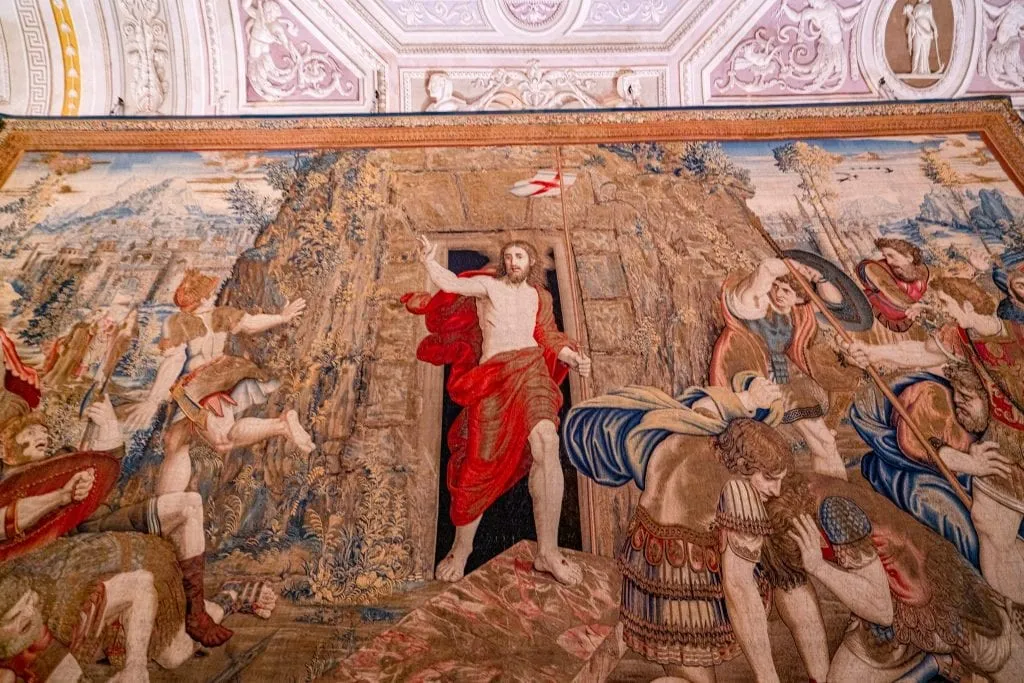
Make sure to follow the dress code!
There is a dress code for visiting the Vatican Museums. Essentially, no shorts, no bare shoulders, no cleavage, and no hats.
In our experience, this is most strongly enforced in the Sistine Chapel, but as a gesture of respect and to avoid the risk of being denied entry, you should absolutely follow the Vatican Museums’ dress code.
We recommend light, loose clothing that will allow you to stay both covered and cool, because the museums can get very warm.
With limited exceptions, there is no air-conditioning in the museums.
Only a few rooms are air-conditioned, so as you can imagine, during Rome’s hot summer months it can be a bit blistering inside the Vatican Museums.
Avoiding the heat (which is, of course, made even worse due to the heavy crowds that are normally visiting the Vatican) is another good reason to book an early morning or Friday night Vatican tour–not only will there be fewer crowds, the museums will be much cooler!
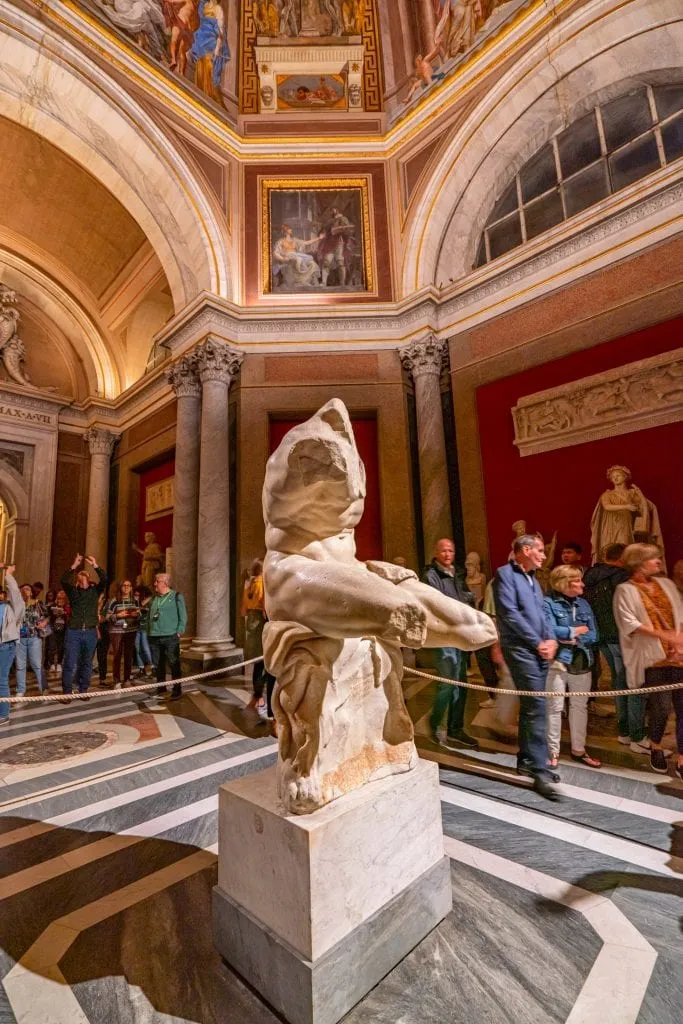
Don’t take photos in the Sistine Chapel.
Despite this being obviously and clearly banned, complete with repeated announcements every few minutes from the security officers and strict enforcement, you’ll still see people trying to snap photos of the Sistine Chapel. Don’t be one of them!
The photos of the Sistine Chapel I’ve used in this Vatican blog post are stock photos for that reason.
Don’t plan to eat at the Vatican Museums if possible.
There is a cafeteria inside the museums selling basic meals and snacks if you get hungry, but with so much incredible food to eat in Rome, it’s best to plan your meals for before or after your Vatican Museums visit if at all possible.
You won’t see the famous spiral staircase isn’t until the very end of your visit.
It’s one of the absolute last things you’ll see in the Vatican Museums–even after the Sistine Chapel–so don’t expect to see it early on!
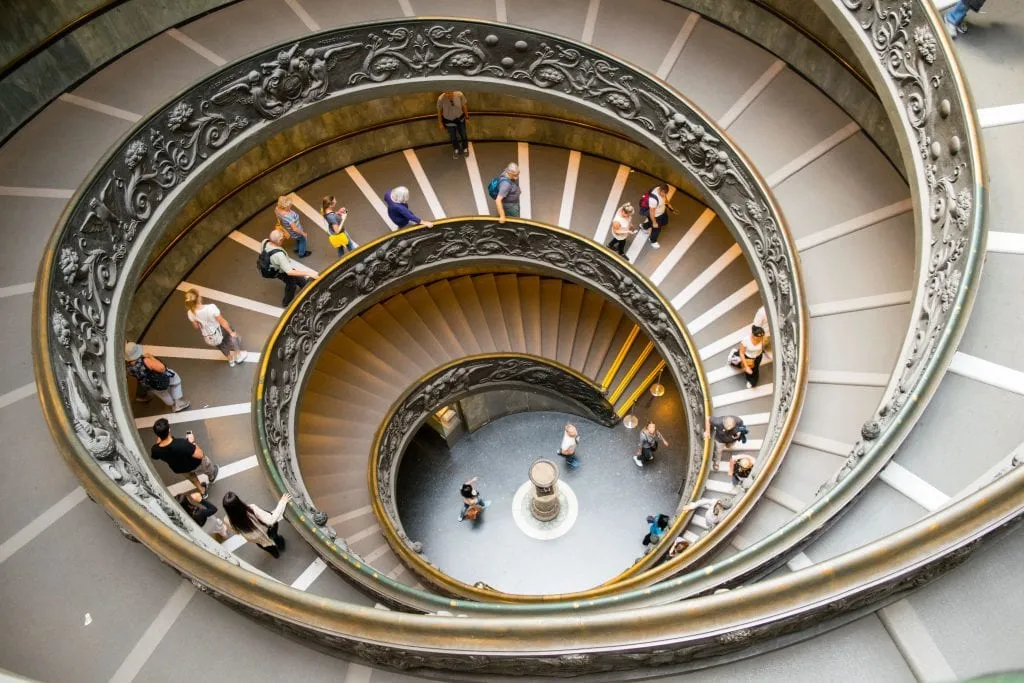
Yes, absolutely!
We think the Vatican Museums are one of the best places to splurge on a tour in Rome–even more than at the Colosseum.
The context gained is incredible, and having a tour guide also makes visiting the enormous museums much less stressful and overwhelming.
We’ve visited the Vatican both independently and with a tour, and absolutely preferred our visit with a tour.
We took this Friday evening tour and loved it, but this tour is another phenomenal option.
Shop excellent, well-reviewed Vatican Museums tours today!
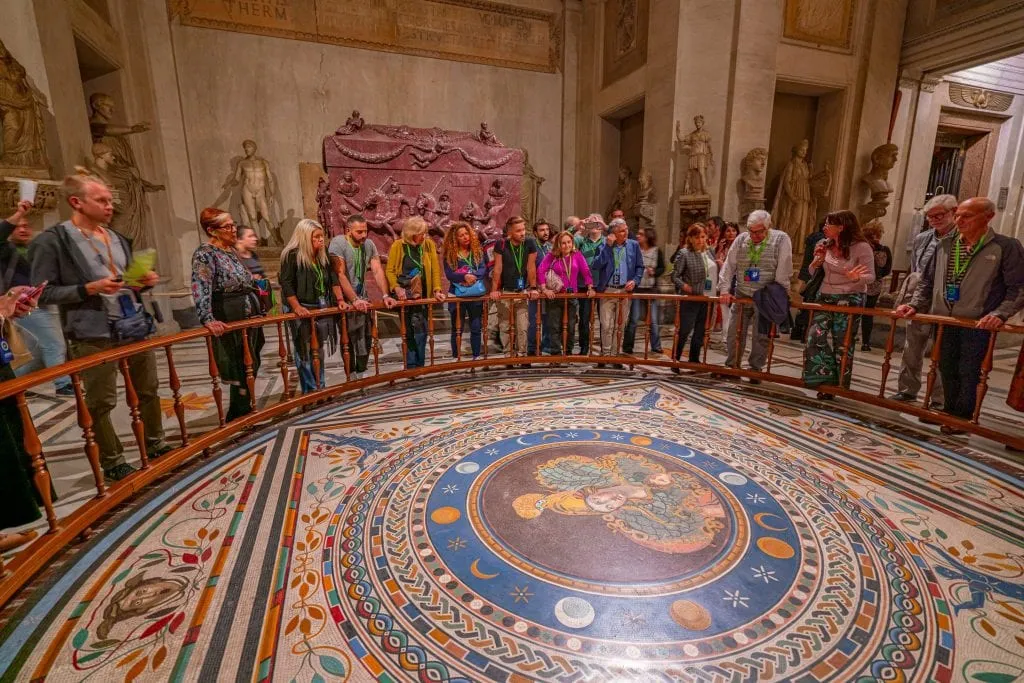
Sprawling and stunning, St. Peter’s Basilica is the largest church in the world and an absolute must-see sight when visiting the Vatican.
St. Peter’s Basilica is free to enter.
You do not need a ticket to enter St. Peter’s Basilica–it is completely free to visit!
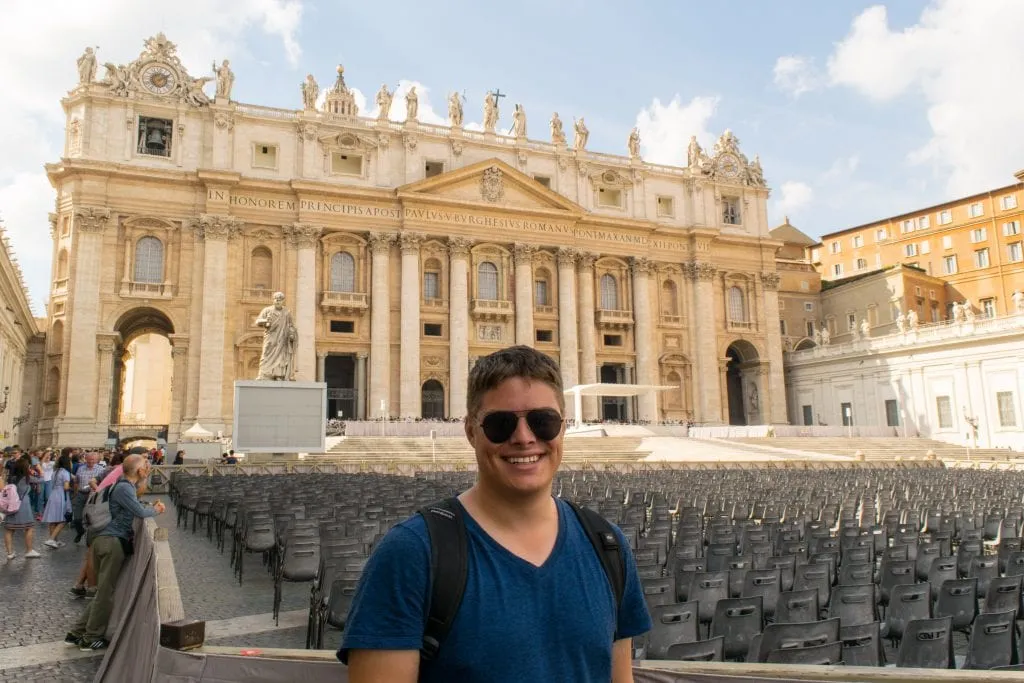
… but you do have to go through a security line first.
This line follows the curve of St. Peter’s Square and tends to grow throughout the day, and is in place for security. You’ll pass through a metal detector and have your bags checked when you reach the front.
The line can get excruciatingly long–if you’re not visiting St. Peter’s Basilica as part of a longer tour, we recommend arriving either very early in the morning (it opens at 7:00 AM every day except Wednesday) or in the early evening–the crowds often start to die off a couple hours before closing (6:00 PM or 7:00 PM depending on the time of year).
You should absolutely visit the dome.
The view overlooking St. Peter’s Square from the cupola is one of our favorite views in all of Rome–and the views of the interior of St. Peter’s Basilica from above are pretty phenomenal, too.
We absolutely recommend climbing the dome when visiting St. Peter’s Basilica unless 1) you have difficulty climbing large amounts of stairs (you must climb a minimum of 320 steps to access the dome), or 2) you’re uncomfortable in tight spaces–there are some very closed-in areas on the way up.
You can buy tickets inside St. Peter’s Basilica, and they’re currently 10 Euro for a ticket that involves a partial elevator ride, or 8 Euro if you’re willing to climb all 551 steps (the elevator ticket lets you bypass 200 or so steps).
The biggest benefit to the cheaper ticket, though, is not the lower price but the fact that it normally has a much shorter line than the elevator option!
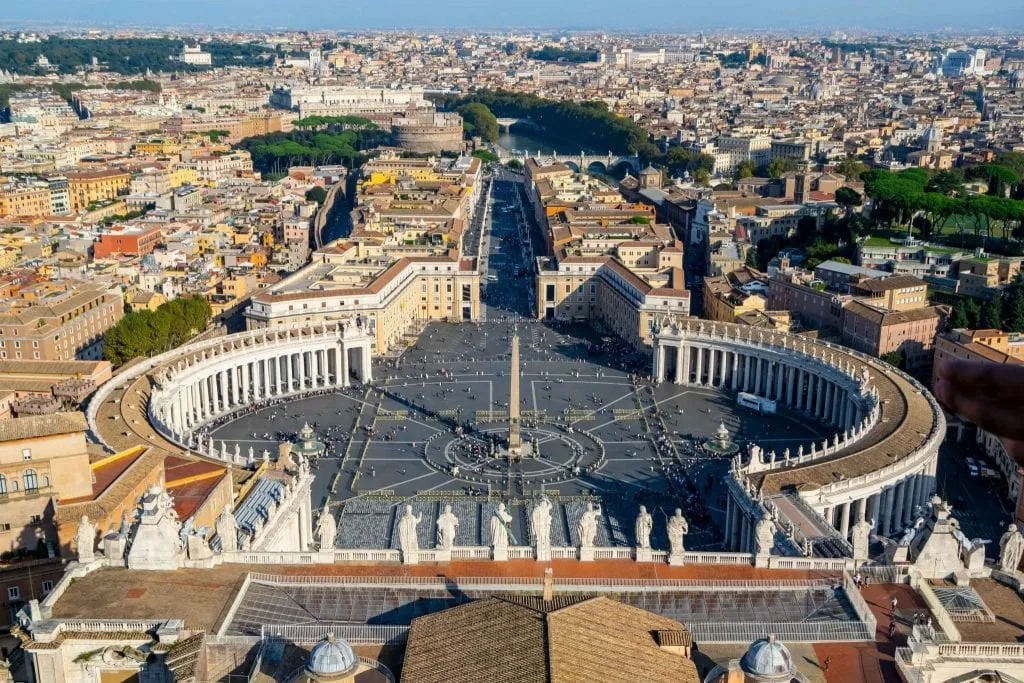
Vatican City is located in the heart of Rome and is easily accessed by either foot, metro, or bus.
Keep in mind that unless you’re on a special tour that gives you a workaround (more on that in the FAQ section), it’s a 15-minute walk around the edge of the Vatican from St. Peter’s Square to the entrance to the Vatican Museums.
St. Peter’s Square is closer to Centro Storico, so if you’re approaching by foot, you’ll likely come across it first.
We absolutely love walking through Rome, and one of our favorite walks winds from Centro Storico all the way to St. Peter’s Square–in other words, the Vatican is absolutely accessible by foot!
For example, St. Peter’s Square is a 35-minute walk from the Trevi Fountain and a 25-minute walk from the Pantheon.
Those times might sound long, but in addition to all the general beauty of Centro Storico, you’ll find some interesting highlights along the way such as Piazza Navona and Castel Sant’Angelo.
From St. Peter’s Square, it’s another 15 minutes by foot to the entrance to the Vatican Museums.
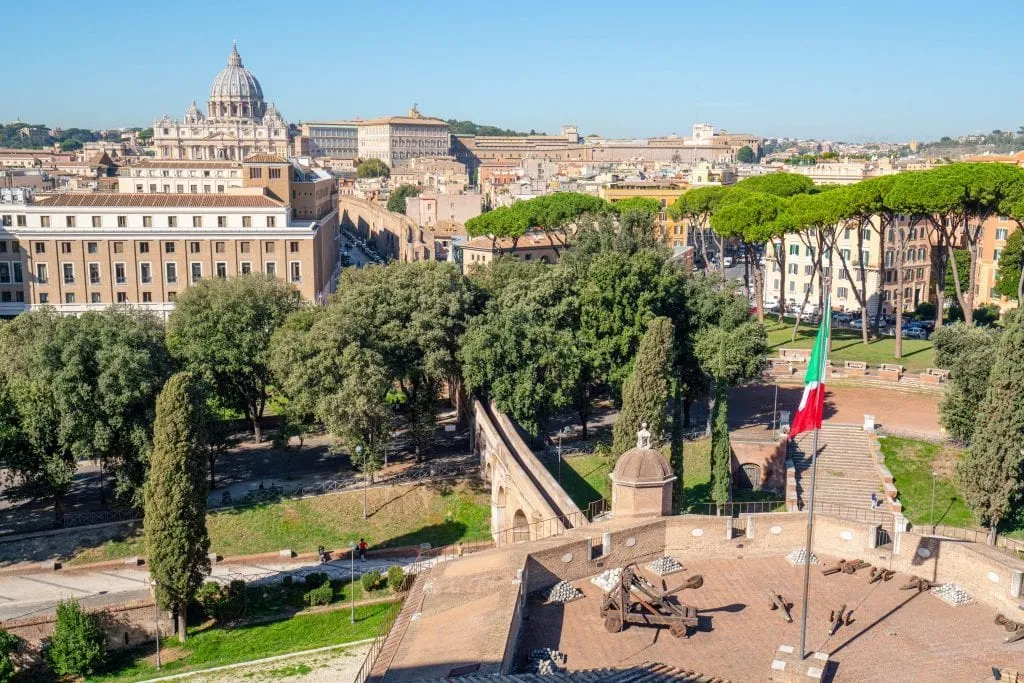
There are two metro stops close-ish to the Vatican: Ottaviano and Cipro, which are each a short walk from the Vatican Museums entrance.
There are several bus lines that stop near Vatican City, with the most frequent being 40 and 64.
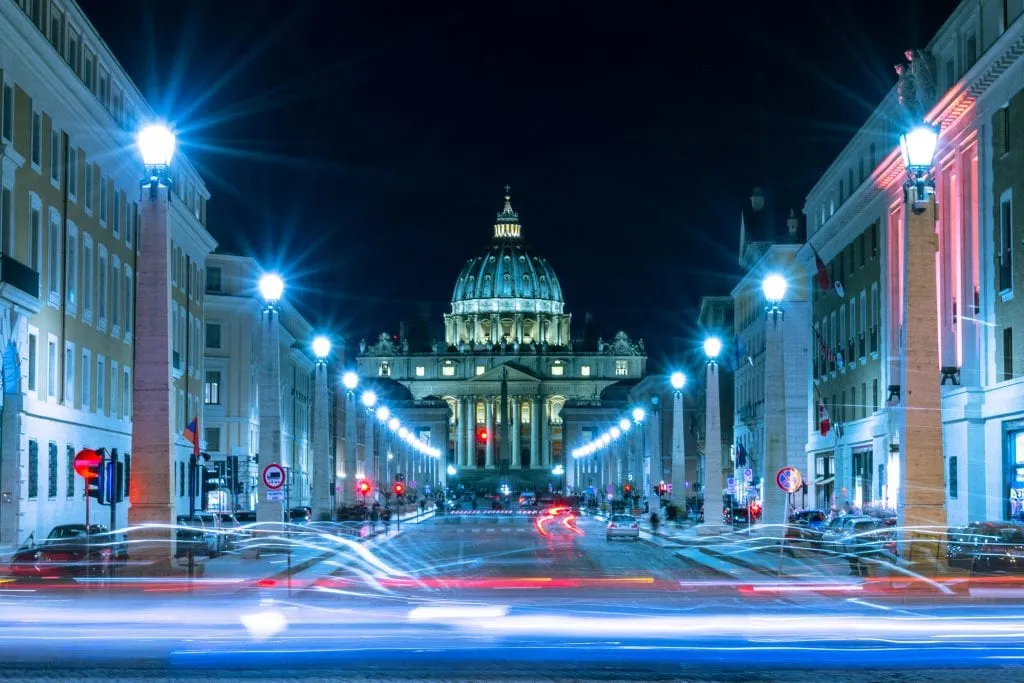
Have more questions about visiting the Vatican?
Here are the answers to some of the most common Vatican City FAQs!
Can you reach St. Peter’s Basilica from inside the Vatican Museums?
Yes… but only on a tour.
There is a semi-infamous door between the Vatican Museums and St. Peter’s Basilica links the two together and makes it possible to go right from the museums into the basilica without taking a (long) walk and waiting in line again, but independent visitors cannot use it.
Some guided tours, though, like this one , do give you the opportunity to use this door.
Otherwise, you’ll need to wait in line to enter St. Peter’s .
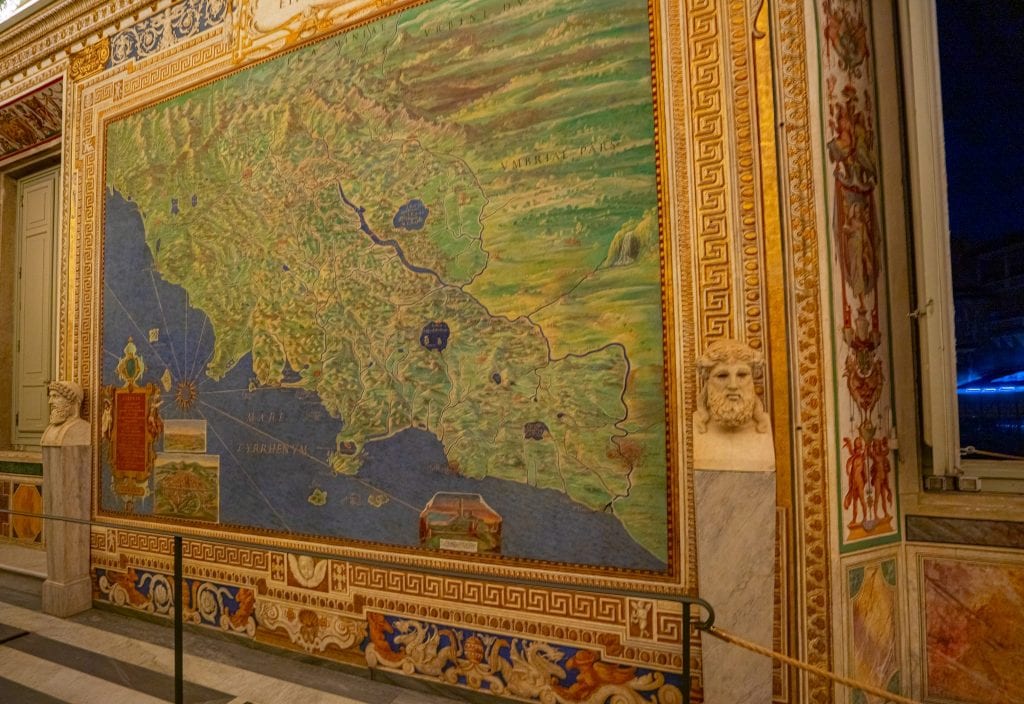
What is the Vatican City dress code?
When in the Vatican Museums, Vatican Gardens, St. Peter’s Basilica, or Sistine Chapel, you’ll want to avoid wearing anything sleeveless, any shorts, or showing cleavage.
Hats are also not allowed.
If you’re just visiting St. Peter’s Square, you don’t need to subscribe to the dress code.
You can see the official language of the dress code here .
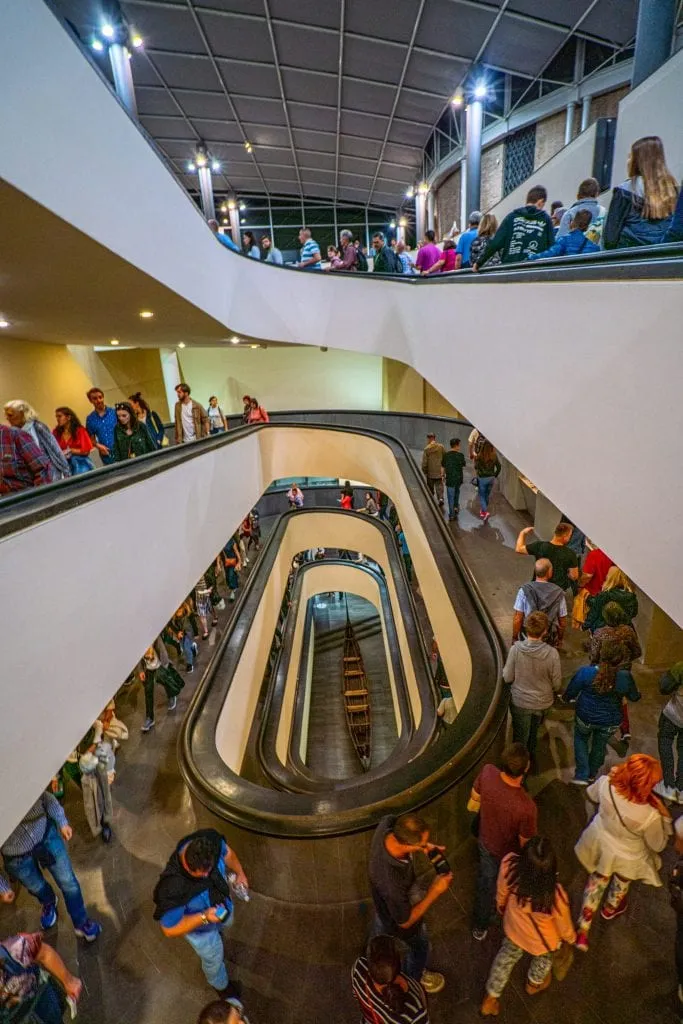
Is Vatican City a country?
Yes, it is–it’s the smallest country in the world, covering only 0.2 miles of land area.
It’s also one of the only absolute monarchies in the world, with the Pope ruling it both as the Pope (overseeing The Holy See, aka the Catholic Church), and the King (overseeing the country of Vatican City).
Vatican City is not part of the UN, but The Holy See (aka the Catholic Church) is a permanent observer of the UN.
Do you need your passport to enter the Vatican?
Even though it is a country, there’s no need to bring your passport when visiting the Vatican.
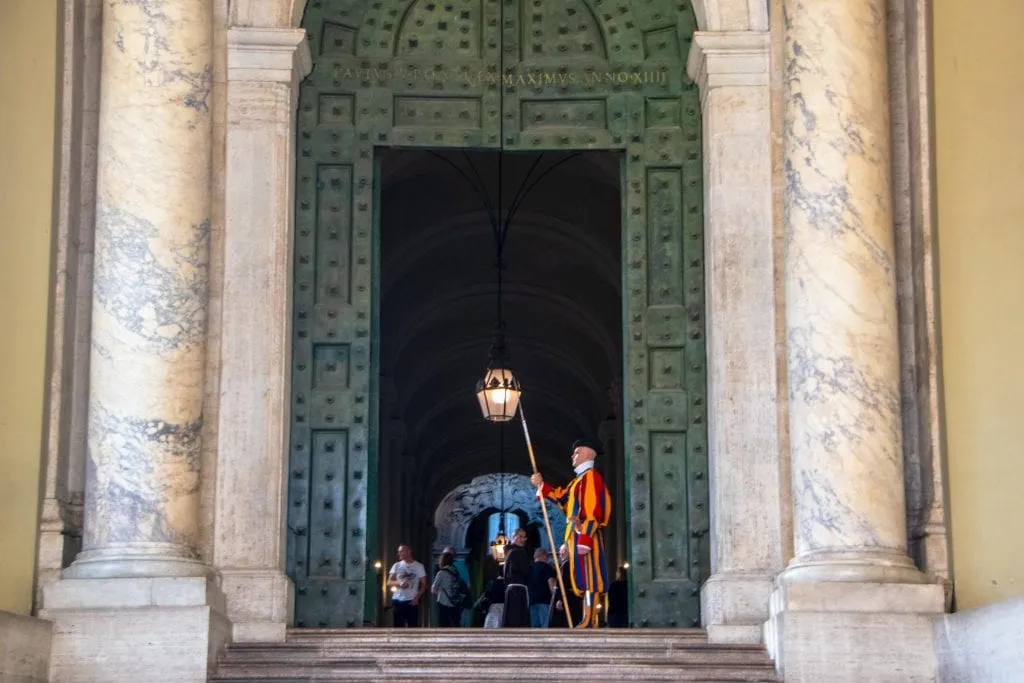
Can you visit Vatican City for free?
If your goal is only to step inside the country of Vatican City, you can enter St. Peter’s Square (for free, and without waiting in line) and St. Peter’s Basilica (for free, but after waiting in line) to pay a quick visit to the country.
Can you get a Vatican City passport stamp?
No, Vatican City doesn’t offer passport stamps.
However, you can buy a postcard in the gift shop and mail it home from Vatican City!
It will be processed through the Vatican’s mail system, and many people use it as a unique souvenir from their visit to the Vatican in lieu of a stamp.
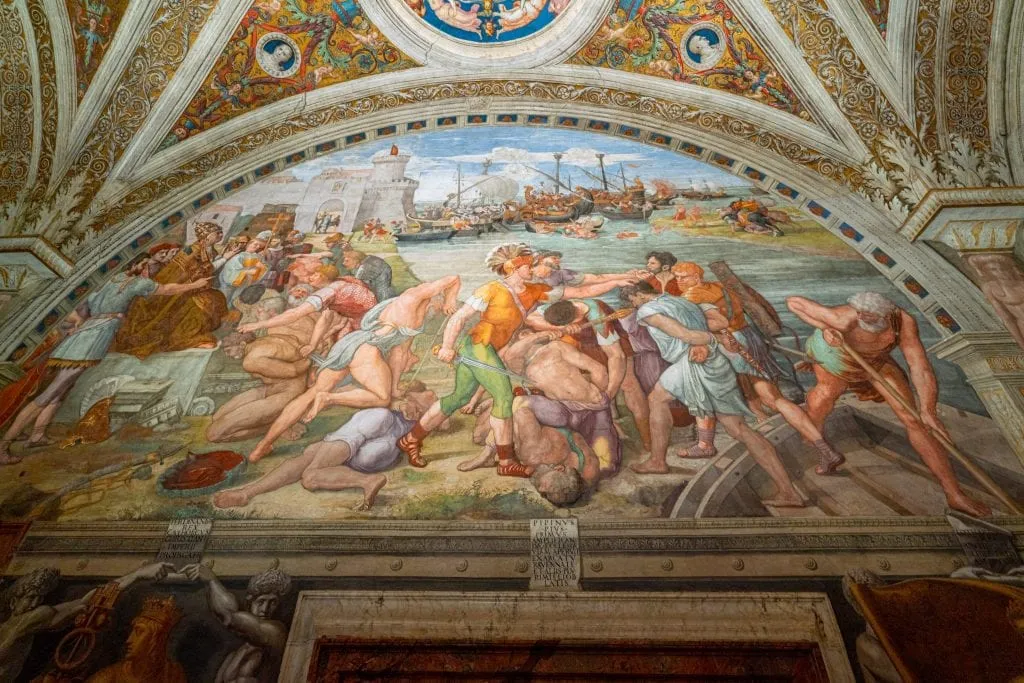
Can you see the Pope when visiting the Vatican?
We covered this a bit above, but essentially, every Wednesday morning that the Pope is in Vatican City, he’ll give an audience in St. Peter’s Square.
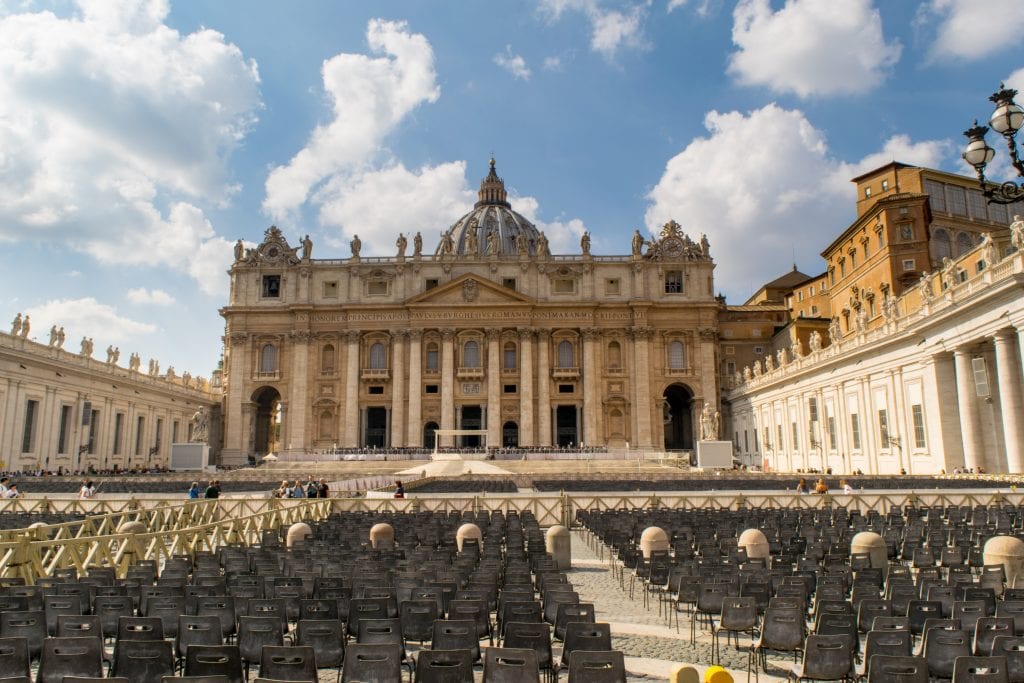
Can you just visit the Sistine Chapel in Vatican City?
No, you can’t.
The Sistine Chapel is one of the final stops when touring the Vatican Museums and can’t be seen without visiting the museums.
Is St. Peter’s Basilica part of the Vatican Museums?
No, it’s not.
You can visit St. Peter’s Basilica separately from the museums.
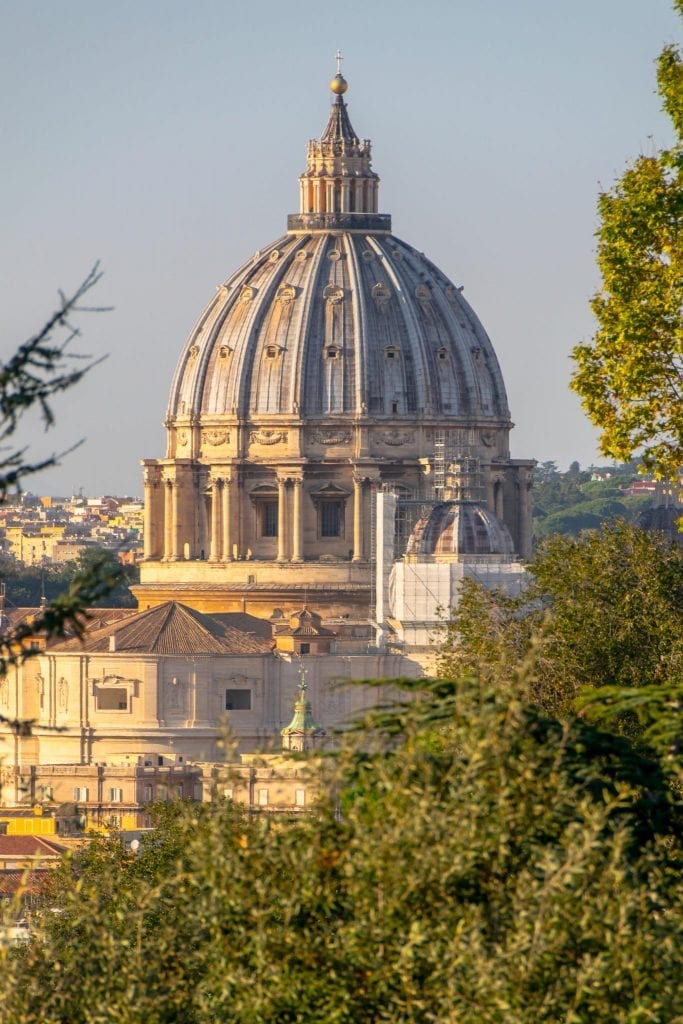
Should you visit the Vatican Museums and St. Peter’s Basilica on the same day?
You can, but be prepared for a long day, as you’ll have to enter both areas separately… unless you book a tour that includes both the Vatican Museums and St. Peter’s Basilica, that is.
In that case, you’ll be able to seamlessly visit both without exiting the Vatican Museums and waiting in an additional line to access St. Peter’s Basilica.
This tour is a popular option that includes both!
Book your Vatican Museums + St. Peter’s Basilica tour today!
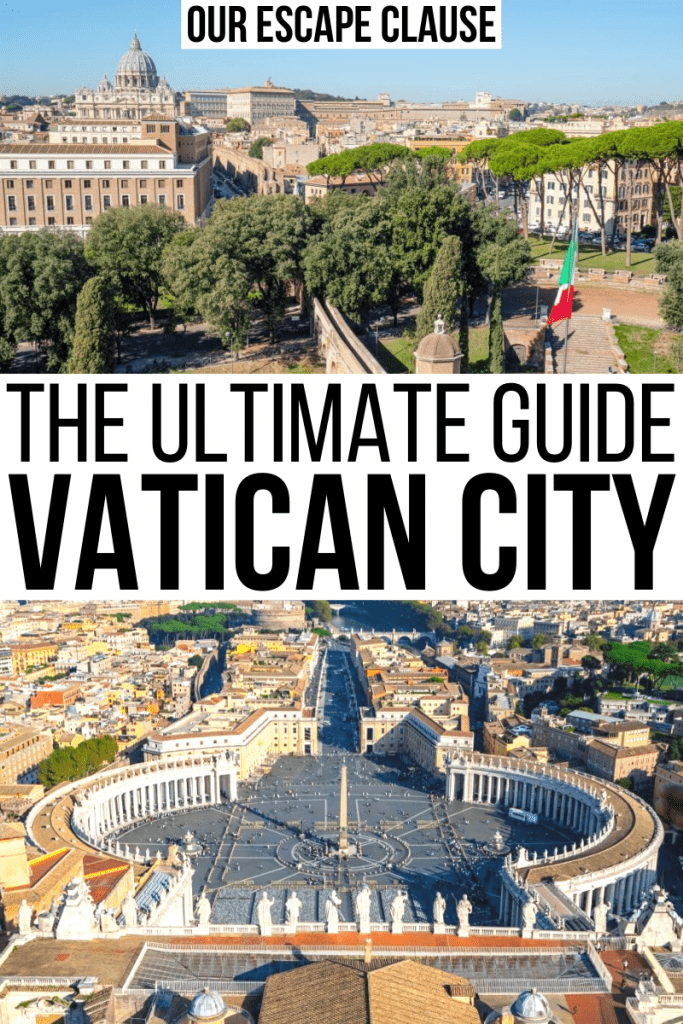
About Kate Storm

In May 2016, I left my suburban life in the USA and became a full-time traveler. Since then, I have visited 50+ countries on 5 continents and lived in Portugal, developing a special love of traveling in Europe (especially Italy) along the way. Today, along with my husband Jeremy and dog Ranger, I’m working toward my eventual goal of splitting my life between Europe and the USA.
2 thoughts on “The Ultimate Guide to Visiting the Vatican: Tips, Tricks + FAQ!”
I am SOOO happy I followed your link for a tour to Vatican City and everything in it! We’re going there 1st week of April and all of the tours through their website were booked or super $$$! I went to your link for TakeWalks Tours and got a great price for the Chapel, Musuems and Basilica! I’m going to keep scouring your site for our perfect Italian vacation!
That is so wonderful to hear, thanks for sharing, Julie! I hope you guys have an incredible trip to Italy! 🙂
Leave a Comment Cancel reply
- Skip to main content
- Skip to primary sidebar
- Skip to footer

Italy Travel Experts Tours and Vacations
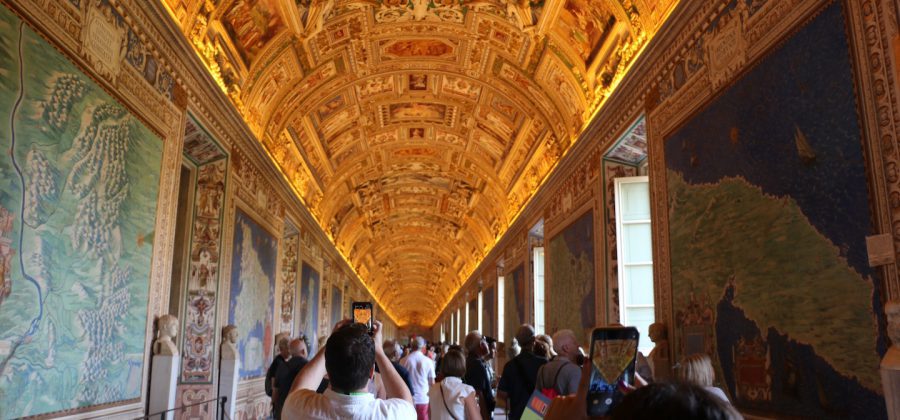
How To Visit the Vatican City: Tickets, Hours, Tours, and More
Sean Finelli Last Updated: August 28, 2023
Did you know that approximately 19,000 people visit the Vatican every day? It can get hectic inside these museums, but there are some ways to get around the crowds. We’ll explain everything you need to know to visit Vatican City from how to get tickets to when to go, the best Vatican tours to take, and more .
Pro Tip: Planning can be tough, but it’s easier to organize your trip when you have all your resources in one place. Create a browser folder and bookmark this post along with our dedicated guide to planning your visit to the Vatican , where you’ll find everything you need. Also, check out our article on the best Vatican tours .
Visiting the Vatican City: What We’ll Cover
Vatican City is the seat of the Roman Catholic Church and the smallest independent country in the world. No matter your religious affiliation, it welcomes all who want to visit—around 19,000 people per day! It is home to some of the greatest works of art in the world.
Visiting the Vatican is an unforgettable experience not only for lovers of art but also of history, culture, and architecture. In this guide, you’ll find information on how to visit Vatican City, the Sistine Chapel, St. Peter’s Basilica, and more. Here’s what we’ll cover:
- Facts and History of the Vatican City
- Opening hours and tickets
- How long to budget for your visit
- How to get to Vatican City
- What to see at Vatican City
- Guided tour options
- Visiting the Vatican with kids
- Where To Eat Nearby and Inside
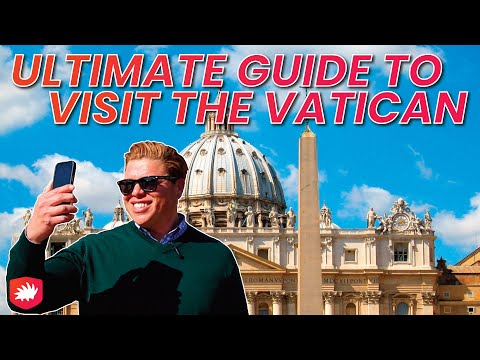
Facts and History of Vatican City
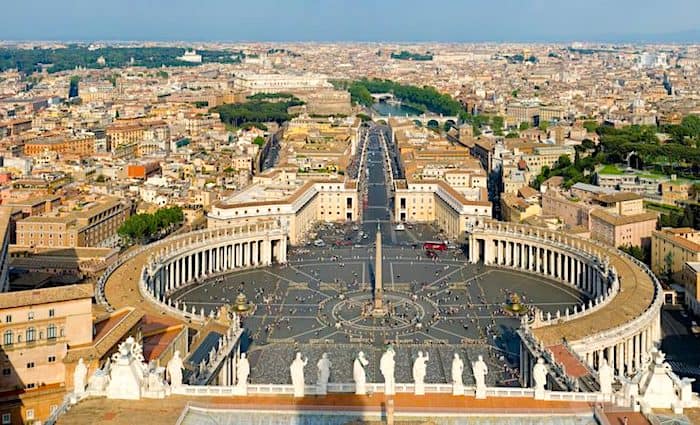
Constantine’s Vatican
The early establishment of the Vatican began with Constantine’s St. Peter’s Basilica, which stood where the current Basilica stands today. Jesus gave Simon the name Peter when he first met him and said, “You’re the stone upon which I will build my church.” After Constantine legalized Christianity in A.D. 313 with the Edict of Milan, he quickly began building that church. For Constantine, Jesus would have been as old as George Washington is in relative history to us.
The Vatican’s Name
I have read many versions of how the Vatican got its name. The most likely is that the Etruscan society living in this area referred to it as Vatica prior to Roman settlement. It was a marshy area called Ager Vaticanus. There are a lot of other theories which may well be correct. It is an old word with many possible roots.
The Leonine City
In A.D. 846, Pope Leo IV commissioned a 39-foot wall to be constructed around the old St. Peter’s Basilica and other areas used by the clergy as a protective measure. The Saracens attacked Rome and caused significant damage to St. Peter’s Basilica, which motivated the pope to build out defenses. The area, which was larger than the current Vatican City, was proclaimed the Leonine City and stayed that way for some time.
Sottopassaggio
In 1277, there was a half-mile-long underground passageway and wall that connected the papal residence adjacent to St. Peter’s Basilica to the Castel Sant’Angelo. This was a major fortification for the pope in case of attack.
Vatican Museums
The Vatican Museums have residents. You won’t see the pope walking around as you visit, but he’s there. The collection of art is a mix of ancient and Renaissance or Baroque. There is even a modern religious art section.
St. Peter’s Basilica and Tomb
The Basilica of St. Peter is basically the largest and most beautiful gravestone ever built. According to Vatican dogma, it was built on the grave of St. Peter, which you can visit with special Scavi tickets. The Basilica, built during the 16th and 17th centuries, was completed in 1615 with contributions by almost every great Italian artist.
Sovereignty
In 1870, Italy was unified under the leadership of Italian-American Giuseppe Garibaldi. The government of the newly-defined Italy allowed the pope to keep a small area under sovereignty. Pope Pius IX would not agree to the terms until 1929, when the Lateran Treaty was signed under Benito Mussolini, which granted the Vatican sovereignty. This sovereignty extends beyond the Vatican City to other churches, including the Basilica of St. John Lateran in Rome.
Not ready to book a tour? Find out if a Vatican tour is worth it .
Vatican Opening Hours and Tickets
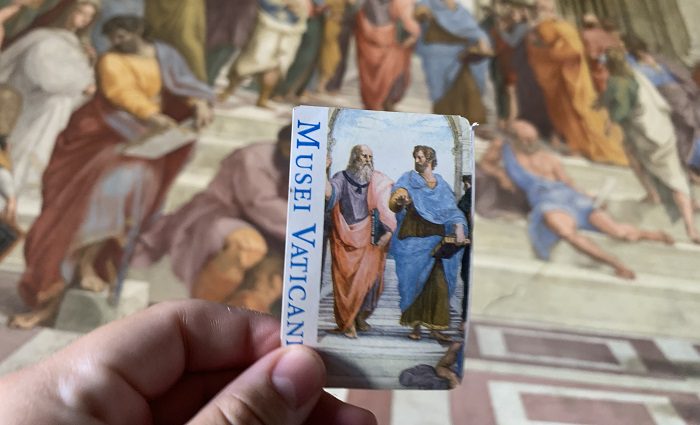
Vatican Museum Ticket Prices:
- Adult (18+): €17
- Children (ages 6 – 18): €8
- Students (ages 19 – 26): €8
- Members of the clergy: €8
Be prepared to show proof of eligibility at the door. Without that, they’ll either make you pay more or disallow entrance without a refund. Tickets include access to the Vatican Museums and Sistine Chapel. If you are looking for solo-visit Vatican tickets , you can check our website for all types of entrance times to suit your preferences.
The Vatican Museum Hours:
- Monday to Saturday: 9 am to 6 pm (last entry at 4 pm).
- Extended Opening Hours: April 14th to 30th, Friday and Saturday, open until 10:30 pm (last entry 8:30 pm); May 5th to October 28th, Fridays open until 10:30 pm (last entry 8:30 pm), Saturdays open until 8 pm(last entry 6 pm).
- Closed: Sundays except for the last Sunday of every month, Jan 1st and 6th, Feb 11th, Apr 10th, May 1st, June 29th, Aug 15th and 16th, Nov 1st, Dec 8th, 25th, 26th, and 31st.
- Free the last Sunday of every month: 9 am – 2 pm (last entry 12:30 pm). Not recommended if you don’t like crowds.
- Most tour companies can enter at 8 am, an hour before it opens.
- The Tour Guy/The Roman Guy can enter as early as 7:30 am, before most tour companies.
St. Peter’s Basilica Ticket Prices:
- Free for all.
- Climbing the dome costs €8 if you take the stairs or €10 if you take the elevator. I recommend the elevator. Find out more about climbing St. Peter’s Dome .
- The Basilica of St. Peter is free to enter but does not include entry to the Sistine Chapel.
St. Peter’s Basilica Hours:
- From April to September: 7 am – 7 pm
- From October to March: 7 am – 6:30 pm
- Closed Wednesday mornings for the papal audience
St. Peter’s Dome Climb Hours:
- From April to September: 7:30 am – 5 pm
- From October to March: 7:30 am – 5 pm
Tours:
We sell top-rated Vatican tours enjoyed by thousands of customers. The Vatican Museums is a bucket-list place you absolutely should visit at least once with a tour guide.
Vatican Dress Code:
To gain access, you’ll have to abide by the Vatican dress code. Cover your shoulders and avoid shorts and short dresses and skirts. We know that Rome gets hot in the summer, we suggest bringing a light scarf to wrap around yourself when you need to. Hats, food, and metal tools like knives and scissors are also not allowed.
How Long To Spend at Vatican City
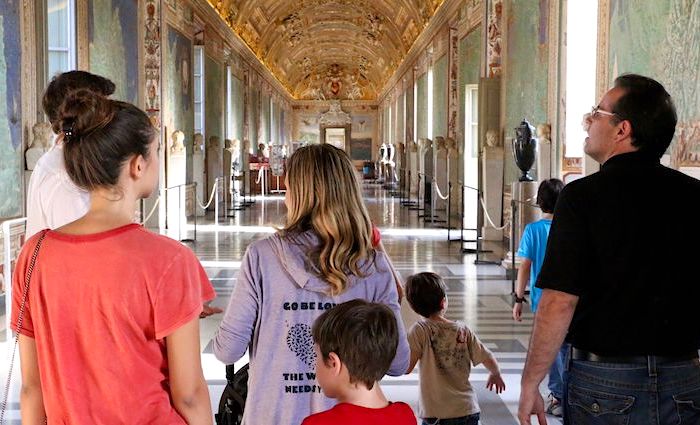
Short Answer: 3 to 5 hours
This is a great question! The Vatican is an immense complex of artwork. You could spend a few hours inside and see a lot of art or you could spend 3 – 5 hours and really learn the history. It depends on your level of interest.
Most people visiting the Vatican for the first time, without an art-history background, will follow the signs for the Capella Sistina or Sistine Chapel until they get there, snap their photo, and leave. Our goal is to help you have a more enriching experience. Here is a proposed Itinerary:
- Spiral Staircase
- Pinecone Courtyard
- Pio Clementino Gallery
- Gallery of Candelabra, Tapestries, and Maps
- Raphael Rooms
- Sistine Chapel
- St. Peter’s Basilica
If you’re an art aficionado, also visit the Pinacoteca. Further on in this article, you’ll see a more comprehensive list of Vatican must-see artwork . If you’re going to go it alone, be well prepared. Check out our top things to see at the Vatican .
How To Get To Vatican City
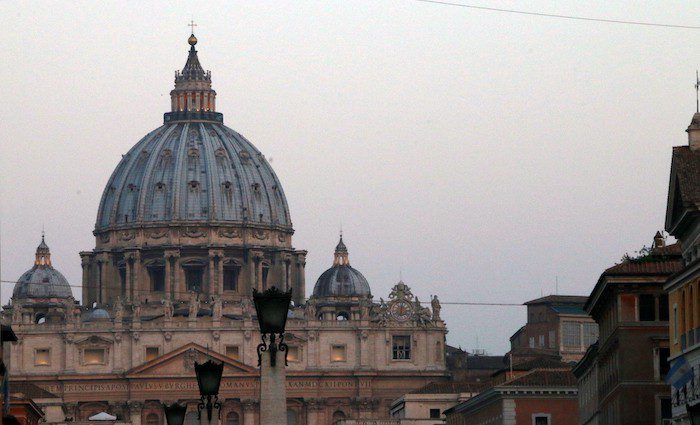
Luckily, getting to Vatican City is really easy. Depending on your preferences, you can take the metro, a bus, catch a cab, or just walk.
Metro (about 20 minutes):
There are two metro stops located near the Vatican Museums entrance: Ottaviano and Cipro. These stops are located on the A-line (orange line). So, if you jump on near the Spanish Steps (Spagna) or Termini train station, make sure you catch the A-line going towards Battistini and get off at either Ottaviano or Cipro.
The entrance to the Vatican Museums is a 5-minute walk from either of these stops. Of course, you can also catch the A-line from many other stops, just check the Rome Metro schedule. You can buy tickets at the metro station or a corner store, but not from the driver.
Pro Tip: Always budget an extra 10 to 20 minutes if you have a scheduled event like a Vatican Tour . This way you don’t have to rush and it’ll give you time for that quintessential morning espresso.
Bus (about 20 minutes):
From the Termini train station, head outside and get on bus number 64. The bus ride will take about 20 minutes and your stop is the last one on the route: P.za Stazione S. Pietro. Getting to the Vatican Museums’ entrance is about a 15-minute walk from the bus station.
You can also take the number 81 bus from the Colosseum area (the bus stop is located right outside of the metro station—B-line). The 81 bus route ends in Piazza Risorgimento, which is a five-minute walk to the Vatican Museums’ entrance.
Taxi (depends on the departure point):
A taxi ride should cost no more than €20 if you’re staying in the historic center of Rome. When you get in the taxi, tell the driver to take you to the Vatican Museums’ entrance, otherwise, they’ll probably take you to St. Peter’s Basilica.
The most typical way to get a taxi in Rome is to go to a taxi stand. These are located near every major tourist attraction. If you aren’t located near one, you can always order a coffee and pastry at a café and ask the people working there to call you one.
Walking (about 20 minutes):
You can easily walk to the Vatican Museums if you’re staying near Piazza Navona or in Campo de’ Fiori. Prati is also within walking distance. Technically, you can walk to the Vatican from basically anywhere in Rome, depending on your level of fitness.
It’s important to take into consideration that you’ll be on your feet for 3 hours or more as you visit the Vatican. I would recommend taking public transport because you’ll be on your feet plenty in Rome.
Pro Tip: A neat trick for using your map app on your phone is to set your course while you’re on wifi on airplane mode. GPS will still show your location while you’re on airplane mode—it won’t reroute you if you go off the route but it will show you where you are.
Popular Vatican Tours
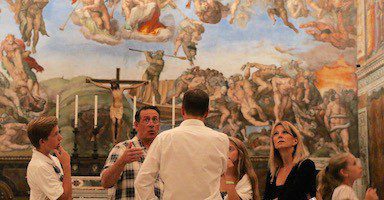
Best Selling Tour
Privileged Entrance Vatican Tour with Sistine Chapel
This our most popular and longest-running Vatican tour to date. It enters the Vatican Museums an hour before the general public and visits the Sistine Chapel before heading to St. Peter’s Basilica. Our English-speaking guides will amaze you with how they bring the museums to life!
Exclusive Value
Vatican Night Tour with Sistine Chapel
You’ve heard about the crowds at the Vatican, but did you know that the museums are almost empty in the evening? This night tour of the Vatican is perfect for those who prefer to explore Rome later at night. You’ll have 2 hours of a guided tour to key areas in the Vatican, plus the Sistine Chapel. And you’re welcome to stay on your own until the museums close at 10 pm!
What To See at Vatican City
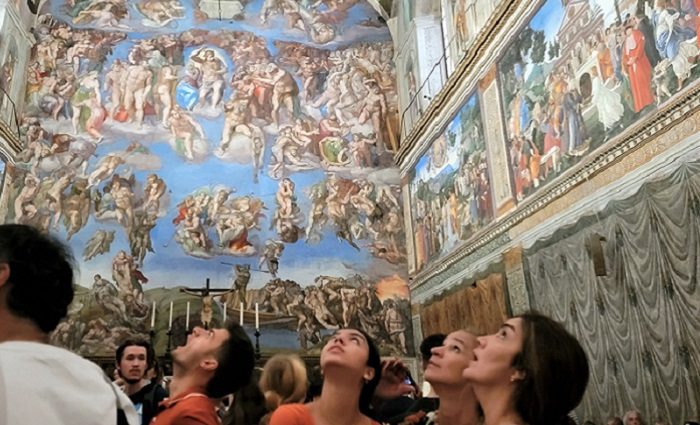
This is a list of the top things to see at the Vatican—an excerpt from our much more elaborate mega-guide on the top things to see at the Vatican Museums written by a Vatican guide. Check it out for more in-depth descriptions, history, and images.
1. Spiral Staircase
The staircase was built by the famous architect Giuseppe Momo in 1932. It was commissioned by Pope Pius XI and was to be created for the new entrance to the Vatican Museums.
2. The Terrace with a view of the Basilica and Vatican Gardens
3. the pinacoteca (for art lovers).
Pinacoteca means “painting gallery” in Italian and, considering that all the popes have historically been the main patron of the arts for centuries, they don’t disappoint. Be sure to see:
- Transfiguration (Raphael)
- The Annunciation (Raphael)
- Crowning of the Virgin (Raphael)
- St. Jerome (Da Vinci)
- St Matthew (Guido Reni)
- Deposition (Caravaggio)
- The Crucifixion of Saint Peter (Guido Reni)
- Martyrdom of St. Erasmus (Nicolas Poussin)
- Astronomical Observations (Donato Creti)
- Adam and Eve in the Garden of Eden (Wenzel Peter)
4. The Pinecone Courtyard
The pinecone courtyard is a massive courtyard that connects the main galleries leading to the Sistine Chapel with the Pio Clementino and Braccio Nuovo Galleries. Reports have been written of jousting tournaments and bullfights taking place under the Borgia Pope AlexanderVI in the 15th century and supposedly Pope Leo X housed his pet elephant, Hanno, here in the 16th century. Be sure to see:
- Colossal Statue of Augustus
- Sphere within a Sphere
- The Pinecone
5. The Pio Clementino Gallery
The collection of classical statues you will see in these galleries was started at the beginning of the 16th century by Pope Julius II. The gallery is named, however, for popes from a much later date: Clement XIV(1769-1774) and Pius VI (1775-1799), who created the current galleries you’ll walk through. Much of the artwork here was taken by Napoleon and returned to the Museum after his defeat. Be sure to see:
- Apoxyomenos
- Apollo Belvedere
- Laocoön Group
- The Belvedere Torso
- The Bath of Nero
- Statue of Hercules in Bronze
- Sarcophagus of Saint Helena
6. The Candelabra Gallery
As the name suggests, this gallery owes its name to the enormous marble candlesticks that you’ll find in each section as you walk down the hallway. The gallery was completely renovated during the pontificate of Pope Leo XIII Pecci (1878-1903), which is what you see today. It was meant to be built so that each piece is like a furnishing for the house. Be sure to see:
- Artemis of Ephesus
- Lapus Lazuli Mosaic
- The Persian Warrior
7. The Gallery of Tapestries
As you walk through the gallery, you will see tapestries on the right-hand side dedicated to stories of the life of the Barberini Pope Urban VIII (17th century). On the left-hand side, are stories from the Bible whose original drawings were executed by the school of Raphael, then woven in Flanders.
- Resurrection of Christ
8. The Gallery of the Maps
By far one of the most over-the-top galleries as far as decor goes, this room is literally a gigantic mural with frescoes on both sides of maps depicting Italy. Pope Gregory XIII, also known as the calendar pope, commissioned this room to be painted so he could accurately study the lands in which he lived and the surrounding areas.
- The Grotesques
- The Ceiling
- Map of Sicily
- Map of Lazio
- Vatican Radio Station (Out of the window to your right)
9. Raphael Rooms
The four rooms known as the Raphael rooms were painted by Raphael and his students between 1508 and 1524. They were commissioned first by Pope Julius II (1503 to 1513), supposedly because he refused to live in the Borgia apartments on the floor below due to his hatred for the man. These rooms were also used by his successors, specifically Leo X the Medici Pope (1512-1521). Be sure to see:
- Room of Constantine
- Vision of the Cross
- Battle of Constantine against Maxentius
- The Victory of Christianity over Paganism (Ceiling)
- Room of Heliodorus
- Liberation of St.Peter
- Encounter of Leo the Great with Attila
- Room of the Segnatura
- The School of Athens
- Room of the Fire in the Borgo
- Fire in the Borgo
10. The Sistine Chapel
This chapel needs no introduction. Originally named Capella Magna (Great Chapel), it was restored by Pope Sixtus IV (pontiff from 1471 to 1484) in 1480. Sixtus IV had famous early Renaissance artists, who lived a generation before Michelangelo and Raphael, paint the fake draperies, the life of Moses and Christ (side walls), and the Pope (above the windows) Sixtus’ nephew. Julius II had Michelangelo paint the ceiling in 1508. Be sure to see:
- The Central Panels
- The Side Panels
- The Stories of Moses
- The Stories of Jesus
- The Last Judgment
11. St. Peter’s Basilica
For me personally, there is no church that compares in beauty. It is the ultimate expression of space, beauty, and monumental grandeur. It also happens to have an amazing history to it as well. When you’re there, be sure to see:
- La Baldacchino
- St. Peter’s Square
Vatican Tour Options
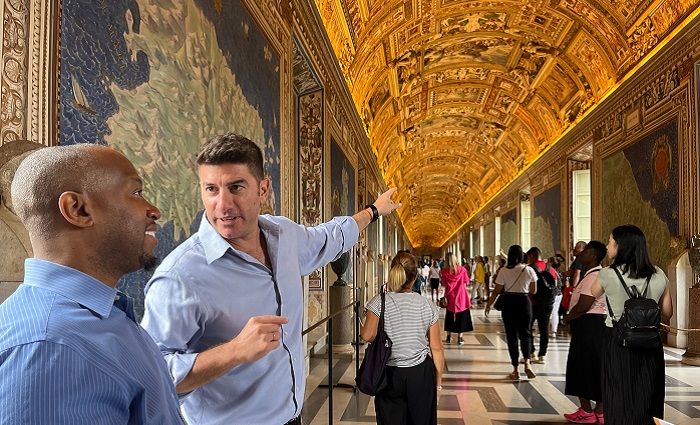
Not sure if a Vatican tour is worth it ? Beyond the explanations and local insight, a major advantage of a tour is that it provides you special access to many sites like St. Peter’s Basilica.
Without a tour guide, you will have to exit the Vatican Museums from the entrance where you came in, which means about a mile of additional walking. Many of our tours provide direct access from the Sistine Chapel to St. Peter’s Basilica. Here are our best Vatican tours:
Colosseum, Roman Forum & Vatican Highlights Combo Tour (8 hours)
This tour is for the art-history buff, visiting the majority of the Vatican Museums including the Pinacoteca, Sistine Chapel, and more. You’ll even have time in the Cabinet of Masks which is an area reserved specifically for guided tours. Your guide will share plenty of stories and information to engage and inspire even novice art lovers.
See tour itinerary, price, and description
Privileged Entrance Vatican Tour with Sistine Chapel (3.5 hours)
This is our most popular Vatican tour. It covers all the must-see sights for visitors including the Sistine Chapel and St. Peter’s Basilica. It’s good for art lovers and anyone that wants to see a ton but doesn’t want to be too mentally exhausted by the end of the visit. A major benefit of this tour is that we have an 8 am entrance time, which is an hour prior to general admission and gets you in when it’s less crowded.
Skip the Line Vatican Tour with Sistine Chapel (3 hours)
This is a great low-price Vatican tour that covers most of the main attractions including the Sistine Chapel and St. Peter’s Basilica. It features a large selection of start times throughout the day, so you can fit your visit into the rest of your plans. The price is also hard to beat from a top-quality tour company.
Exclusive After Hours Sistine Chapel Tour with Aperitivo (3.5 hours)
If you want to see the main sites and understand them but don’t want to get caught up in every detail, this is for you. We have an 8 am option that beats the crowds, along with other start times. It’s a small group tour and great value that’s also our fastest way to see the best of the Vatican Museums.
Not ready to book a tour? Check out our best Vatican tours to take and why.
Visiting the Vatican With Kids
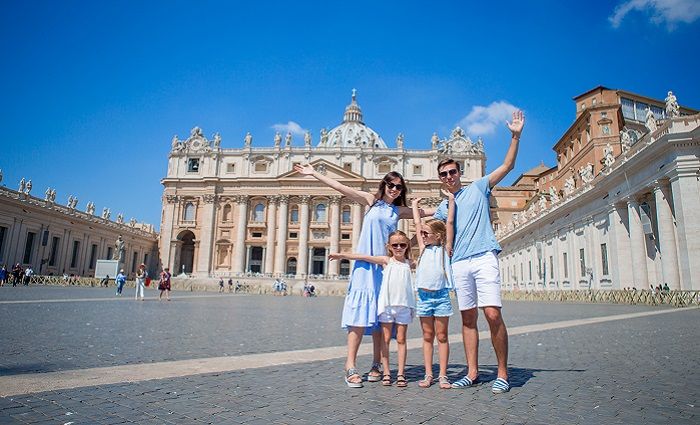
If you want to visit the Vatican Museums with your kids, you’re in luck. The museums are happy to welcome families with children and strollers in tow.
As you explore the collections, there are also plenty of restrooms with changing tables and places to sit and rest. There’s even a private room for mothers to nurse in complete privacy. For a more private experience truly geared toward a younger audience, consider our family-friendly Vatican tour .
Popular Rome Tours
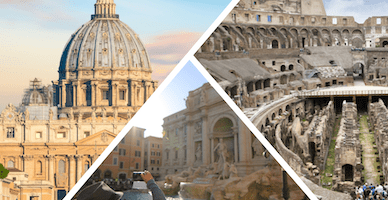
Best-Selling Tour
Rome in a Day Tour with Colosseum and Vatican Museums
Our “in a day” tour is best way to get your bearings all in one day. Visit the Sistine Chapel, Colosseum, Trevi Fountain, and more with a licensed, fun English-speaking tour guide. They’ll add tons of insights and make the entire experience so much more memorable. Also, you’ll get a feel for the city, so it’s a great option on one of your first days in Rome. Bring your walking shoes and water bottle!
Best Price!
Skip the Line Vatican Tour with Sistine Chapel
One of our most popular Vatican tours since it is such an amazing value. Skip the line to get inside with a super-knowledgeable, English-speaking guide who will bring the museum to life with stories of the artists, popes, conspiracy, love, and even tragedy! This tour has start times throughout the day so you can choose when to visit based on your schedule!
Not ready to book a tour? Check out our best Rome tours to take and why .
Places To Eat Inside and Nearby
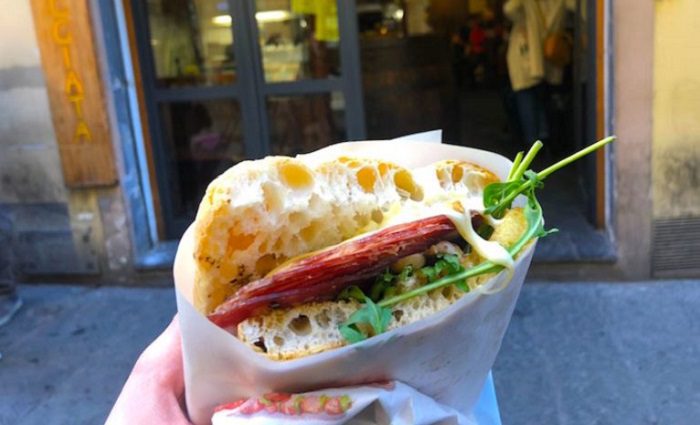
Like all great Italian museums, you can get coffee and food inside the Vatican Museums. Here are a few recommendations for getting a bite to eat and some refreshments inside and nearby the Vatican.
Inside the Vatican
Caffetteria Centrale : €€ | Coffee Shop —With sub-par reviews that you would expect in a cafeteria-style eatery, this coffee shop and light eatery will get the job done if you want to spend more than 4 or 5 hours inside the Vatican Museums. To find it, look for signs near the Pinacoteca.
Bar: €€ | Quick Snacks —There is a small bar for coffee and pastries located near the Sistine Chapel. Look for the signs as you get close.
St. Peter’s Dome Bar: €€ | Coffee Shop —Yep, you can get coffee on top of St. Peter’s Dome. There is a little bar open basically whenever they want to be open. But if it’s open, stop for a coffee and enjoy the view.
Near the Vatican
Hostaria Dino e Toni : € | Roman Restaurant —Somehow this owner-operated and authentic Roman restaurant has yet to get touristy. They make good food with relatively friendly service, and they may just order for you. Come here for pizza, pasta, and apps.
200 Gradi : €€ | Sandwich Shop —Have a big day of sightseeing planned after your Vatican visit? This sandwich shop is perfect. You can get really tasty to-go sandwiches or sit down inside. Super reasonably priced.
La Zanzara : €€ | Bistro —A bit more cool and trendy with a modern spin on Italian classics, this place feels like a French bistro but the food is definitely Italian. It’s great for a cocktail and sit-down lunch.
Where To Stay in Rome
Rome has a rich cultural history and many iconic landmarks to explore. Plan where to stay in the magnificent Eternal City in the best neighborhoods.
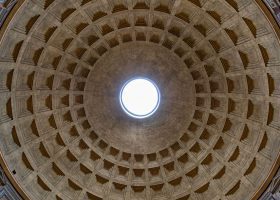
Reader Interactions
Comments (16).
March 6, 2019
It’s best to visit this enthralling withing the country charm
March 8, 2019
Hey Eric! Thanks for reading our blog. We’re so glad you enjoyed reading!
June 5, 2019
It was great reading your blog, very nicely executed. You obviously put a lot of effort into it. Keep it up!
June 6, 2019
Grazie! We’re so glad to hear that you enjoy the blog. Come to Rome soon and join us on tour !
July 11, 2019
I, being a native of Italy, wasn’t aware of these facts and the way it has been stated is interesting as well as hugely informative. Thanks for the post man… Would be waiting in for more.
July 12, 2019
Ciao Daniel! We’re thrilled to hear that you enjoyed reading this post. We offer tons of useful content on travel in Italy! Check out another one of our useful Vatican blogs here, about our best Vatican tours .
September 19, 2019
Thank you for this informative post! With regards to your Vatican tours, which tour will be the one to get the most out of Vatican City? Solo traveler by the way. Looking forward to hearing from you soon!
September 20, 2019
Ciao Darryl! Thanks for checking out our blog. For the most in-depth Vatican City experience, I recommend our Complete Vatican Combo Tour with Sistine Chapel & Dome Climb . This climbs St. Peter’s Dome and provides an excellent skip the line Vatican tour. Hope this helps!
September 29, 2019
Thank your these tips Tawny. Very helpful and detailed. I will definitely look up in your travel guide and tours next time I come in Rome.
October 1, 2019
Ciao Sophia! Thanks for reading our blog! Happy to supply helpful information to you. We’d love to welcome you on tour when you come to Rome!
October 6, 2019
Hello, We have planned a day visit to Rome on 25th Dec. Please suggest if all attractions will be open that day especially the St. Peter’s basilica and the Vatican museum.
October 11, 2019
Ciao Anu! The Vatican Museums are closed on Christmas. We recommend visiting the Vatican a different day during your stay.
December 10, 2019
Hello! It was great reading your blog, very nicely executed. You obviously put a lot of effort into it. Keep it up! Thanks
January 13, 2020
My daughter and I are going to our first trip to the Vatican this summer. I wanted to find out if there is a mandatory dress code when visiting. In our country, for example, women in trousers and bare-headed cannot go to Orthodox churches. Thanks for such detailed details.
January 21, 2020
Hi Tori! Thanks for reading. Yes, there is a dress code – knees and shoulders must be covered.
April 19, 2020
The Tour Guy always does a great job. Had a trip planned for the Vatican this week but of course it was cancelled due to COVID-19. Anyways, this made it feel like I still went.
Leave a Comment Cancel reply
Your email address will not be published. Required fields are marked *
- In The Press
POLICY & TERMS
- Cancellation Policy
- Terms & Conditions
- Privacy Policy

What is the best time of day to visit the Vatican?
Limited time at vatican city well, don’t just stand there and grumble, read our top tips here to avoid the crowds and make the most of your day out .
On your trip to the incredible country of Italy, you will see endless attractions filled with culture, history, and of course, crowds. And the Vatican City is no exception, with spectacular places swarming with tourists around every corner. Instead of wasting time waiting in lines for half your trip, find out the best times to visit each popular sight. Using our tips and tricks to get you to the front of the line, see the vast collection of art and architecture this city has to offer.
What Season to Visit the Vatican?
With the changing of seasons, comes the change in tourist traffic. There are high, low, and shoulder seasons within Italy. The period between June to August is the high season, due to visitors coming during their holiday breaks. For much of Europe this is their summer season, so think school holidays and summer breaks. High season may be more convenient and appealing, but the hours waiting in line under the hot sun can have some drawbacks. You don’t want to be getting heat stroke before you’ve even seen the basilica. Wintertime is the low season and is the quietest time to visit Vatican City. You will be able to cover a lot more ground in a shorter amount of time, as most people like to avoid the cold months and the Christmas season. If you don’t mind a bit of cool fresh air to wake up your senses, then this could be the season for you! The city is still beautiful in the winter sun and not tarnished by hoards of tourists. However, if you’re not one to brave the cold then maybe the shoulder season would be a better choice. This means the months between September – November and March – May. The shoulder seasons are essentially autumn and spring for much of Europe and include the perks of nice weather and quieter crowds. The two months that are best are March and April, which usually has warm weather and a few crowds but nothing like the high levels you see in high season.
What Day to Visit the Vatican?
Vatican Museums are open six days a week, with the exception of Sunday. Which is only open on the last Sunday of every month, when from 9 am – 12:30 pm, the entrance is free. The otherwise Sunday closures mean that Saturdays are always swarming with large crowds, so it’s best to avoid the museums during the weekend. Friday is probably the best day to go, with Tuesday and Thursday coming in at a close second. Wednesdays are quite busy due to the papal audience, where the Pope appears to address the crowds in St. Peter’s Square in the mornings. It might therefore be best to visit the Vatican early in the week, on either a Monday or Tuesday, this ensures you miss weekend traffic and the pilgrims or tourists who are coming into the city for the papal audience on Wednesdays. Always check online beforehand to ensure you’re visit isn’t poorly timed with a public event or holiday.
What time is the best time to visit the Vatican?
Usually, people think skipping the lines means getting to the Vatican early in the morning. For Vatican City, this is not the case, as the tourist traffic is busiest during the morning hours. The crowds enjoy the start of the day pushing through the hordes of people lining the marbled halls and cobblestone streets. Right around lunchtime, it starts to slow down, troops of people heading off for a delicious lunch to tuck into and refuel. This is your chance! Simply walk right in at 3 pm and enjoy the spectacular attractions all to yourself. The ticket windows usually close around 4 pm, with the museums and building remaining open until 6 pm. If you time it well you can enjoy a 2-hour slot to yourself where you can marvel at the remarkable attractions that have made this city so famous.
Tips for Your Adventure to Vatican City?
If this all sounds like too much work and organisation for your holiday, then why not book onto a tour? A tour is a great way to take the stress out of your visit, whilst ensuring the get the most out of the day-trip. By signing onto one of our Vatican City Tours , you can skip the long queue lines and head straight for the sights, all within a small guided group. Learn more about each attraction in detail as our tour guide explains to you the sights’ particular history and place in the city. Or, if you’re not quite ready to commit to a tour yet, read our article on a 1-Day Itinerary in the Vatican, to find out what you can do there!
Explore Our Vatican Tours
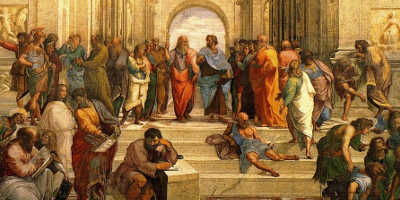

Vatican & Sistine Chapel Morning Tour €65

Private Vatican Tours from €339
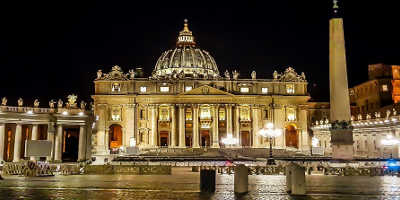
Vatican & Sistine Chapel Night Tour €59

Rome Day Tour with Vatican & Colosseum €95

Vatican & Sistine Chapel Afternoon Tour €65
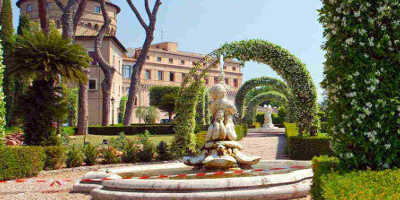
Extended Vatican Museums & Gardens Tour €99

Pompeii Tours
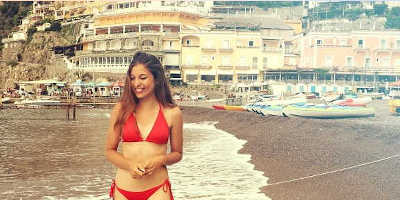
Amalfi Coast Tours

Florence Tours
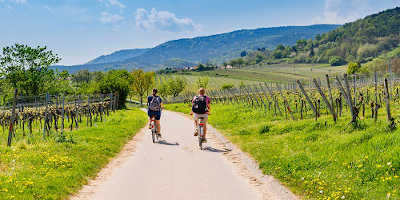
Tuscany Wine Tours

Venice Tours

All Italian Tours
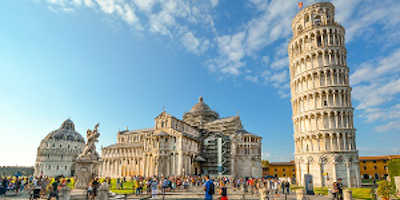

Visiting the Vatican Museums – All You Need to Know for a Perfect Tour
Visiting the Vatican Museums, one of the largest museums in Rome and also one of the most famous museums in Italy , requires some good planning. Being so popular, you will likely find a long line at the entrance. Being so old, you will definitely be overwhelmed about what to visit in the short time you can afford inside.
Being one of the main landmarks of Vatican City , this wonderful museum is pretty much always included in the private Vatican tours as well as the more generic tours of Rome .
I wrote this guide to visit the Vatican Museums to avoid as many surprises as possible and ensure a smooth tour. Here you will find important information regularly updated about visiting hours and closing times, ticket prices, and how to skip the line when visiting the Vatican Museums in Rome.
Table of Contents
Our tips and guide to visiting the Vatican Museums
Is it worth visiting the vatican museums.
The Vatican Museums enshrine five centuries of history and artwork donated to the popes by the world’s leaders, kings, and queens, as well as the pieces purchased and commissioned by the popes themselves throughout history.
Historical pieces like clothes and carriages and historical areas like the different popes’ apartments sit side by side with immortal artwork such as Michelangelo’s Last Judgment in the Sistine Chapel and the frescoes of Raphael’s Rooms.
First and foremost, you need to accept the idea that you can’t just show up at the entrance of the Vatican Museums and get in straight away. There will be a long queue or it might even be closed, so if you haven’t done a minimum of planning, you might end up wasting time and missing one of the best places to visit in Rome .

Tickets for the Vatican Museums
From January 1st, 2024, the tickets for the Vatican Museums will be more expensive, priced at 20€ instead of the current 17€.
To fight the phenomenon of unauthorized ticket resales, the Vatican Museums will introduce nominative tickets and will start checking IDs at the entrance.
Skip the line
Nobody likes standing in line for hours on end, especially when there is an easy way to avoid this. While you can just turn up and buy your ticket, this is no guarantee that you will do it as easily as you think.
In Rome’s most famous landmarks , it’s of paramount importance to arrive with your ticket already purchased. There are many websites where you can buy your ticket to the Vatican Museums online, one of the most popular is Get Your Guide .

Join a tour
Alternatively, instead of just booking your entrance, you can join a private tour of the Vatican Museums. Along with the admission, a private tour includes a guide who will take you directly to the most famous spots you would probably miss if you were on your own or that you would have to look for.
A guided tour is more expensive than a single admission ticket but has the perks of saving you time and making your visit more complete with historical facts and anecdotes. We recently took a very exclusive private tour of the Vatican Museums and Sistine Chapel and loved it.
Check closing time…
Even though an art gallery, the Vatican Museums are closed on Sunday, except if it’s the last Sunday of the month when there is free entrance. The Vatican Museums also close on the main religious holidays when other museums are actually open, such as Easter Sunday and Monday, November 1st (All Saints’ Day), December 8th (Immaculate Conception), Christmas and Boxing Day, and New Year’s Eve, December 31st.
… and the new opening hours
Starting January 1st, 2024, the Vatican Museums announced that they are going to extend their visiting time by two hours, one extra in the morning and one extra in the evening. So instead of opening at 9 am, it will open at 8 am, and instead of closing at 6 pm, the Vatican Museums will close at 7 pm. This applies to every day from Monday to Saturday.
From the beginning of March 2024 when the high season starts, the Vatican Museums will extend an extra hour on Friday and Saturday, closing at 8 pm only on these two days.

Follow the dress code
Again, even though visiting the Vatican Museums might just seem like entering an art exhibition, you need to keep in mind that they are located inside Vatican City. This means that you are expected to follow the Vatican dress code you would follow when visiting the Basilica of Saint Peter and its underground Roman necropolis .
What is not allowed in the Vatican Museums?
Large bags, backpacks, and suitcases are not allowed in the Vatican Museums and you will need to leave them in the cloakroom. Apart from these types of bags, among the obvious objects that are not allowed in the Vatican Museums are firearms, knives, scissors, and any sharp and dangerous object.

Are photos allowed in the Vatican Museums?
You can snap your pictures without using the flash everywhere in the Vatican Museums except for the Sistine Chapel and the frescoes of Michelangelo. It’s also not allowed to take videos, use selfie sticks, or use professional photo and video gear, including a tripod. Anyone visiting the Vatican Museums should be aware of these rules as there are staff and guards everywhere who will ask you to delete your photos.
Be mindful of the noise
This doesn’t apply to all the areas when visiting the Vatican Museums but only when you are inside the Sistine Chapel. Here, in fact, you will be asked to be silent or to speak by whispering so that the experience of your fellow visitors won’t be ruined when admiring Michelangelo’s masterpieces.
Check out our guide to eating near the Vatican!
WANT TO SAVE THIS FOR LATER? PIN IT TO YOUR BOARD!
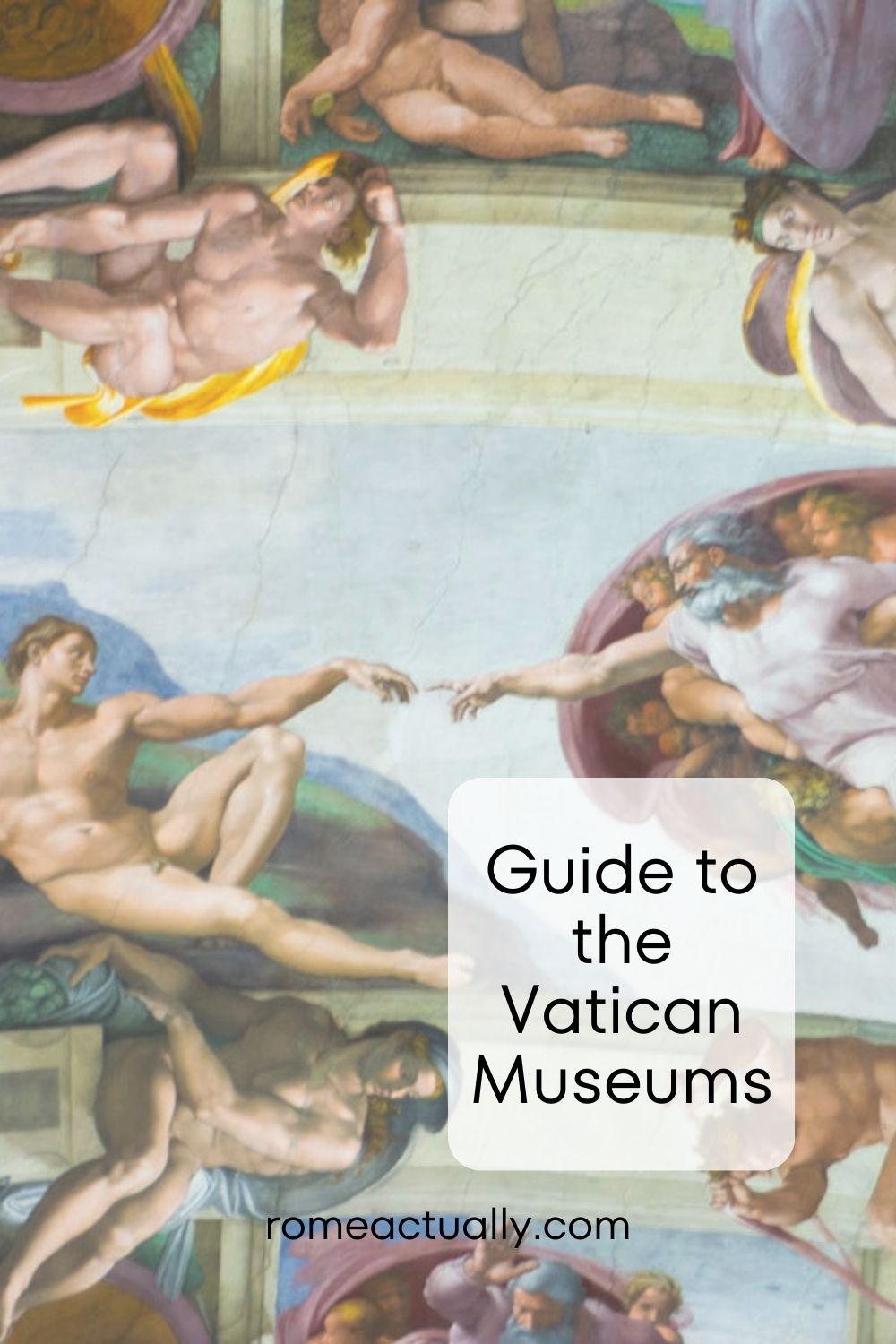
About The Author: Angela Corrias

Is Rome Worth Visiting? My Honest Opinion, Pros & Cons
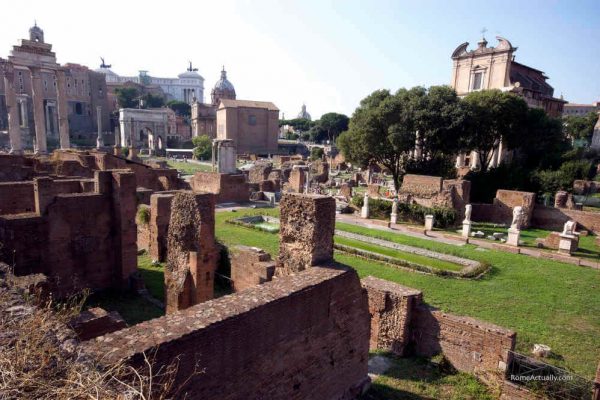
Birthday of Rome, All You Need to Know About the 21st of April in Rome (2024)

Rome in April – What to Know + Planning Tips (2024 Edition)

23 Best Rome Tours – Explore the Eternal City with an Expert
Leave a Comment Cancel reply
This site uses Akismet to reduce spam. Learn how your comment data is processed .
Privacy Overview
Vatican Museums
Where we are.
General information +39 06 69883145 [email protected] Office of the Directorate +39 06 69883332 [email protected]
Publications and Merchandising

Sculptures >

Publications >

Gift ideas >

Prints and Posters >

Accessories >

Home decor >
Follow us Menu

Social media
Support menu, patrons of the arts.

Search Menu
Advanced search.
How to see the Sistine Chapel all by yourself — or explore the Vatican Museums on the cheap

Jun 15, 2022 • 6 min read

A traveler walks with the Vatican Museums' keymaster Gianni Crea (right) walk through the halls of the Vatican Museums © Copyright – Governatorato S.C.V. – Direzione dei Musei
You’d be wrong to assume that, should you find yourself in the once-in-a-lifetime position of gaining access to the Vatican Museums at 6 am — a full three hours before the doors open to the public — there would be any pomp and circumstance when the main entrance door along Rome’s Viale Vaticano swings open.
The door, built in 1932 and topped by Pietro Malendri-chiseled sculptures of the Vatican’s two main artistic superstars, Michelangelo (with a sculptor's mallet in his hand on the left); and Raphael (clutching his palette and brush on the right), is a grand exercise in symbolic expectation. The chiseled words above, in Latin script, are both direct and spine-tingling: Vatican Museums. It need not say more.
However, it’s just a suited security staff member who casually opens the door and says, " Buongiorno! " Were it not for the fact that the general public doesn’t actually use this door (visitors enter through a far more modern gateway a few meters to the left), it wouldn’t feel special at all.
But therein lies the rub. Entering the Vatican Museums at sunrise needs no added fanfare — the treasures awaiting in the museums, void of people and quiet enough to hear an aureus coin drop, do all the work themselves.
I’ve come to the Vatican to meet the clavigero , the official Vatican keymaster, Gianni Crea, who oversees the nearly 3000 keys that open all the doors within the Vatican Museums. Crea heads up a team of 11 clavigeri , who take turns opening and closing the various rooms of the Vatican Museums, including the Sistine Chapel, each and every day. I’m just along for the ride.
The 8 best museums in Rome
Crea, an immediately likable Italian from Calabria, shows me how the keys are kept in a special bunker nightly; and explains that there are five backups of each one. Except one — the key that unlocks the Sistine Chapel. This key is sealed in an enveloped nightly, stamped and sealed by the Swiss Guards, and locked away in the bunker. There is no backup.
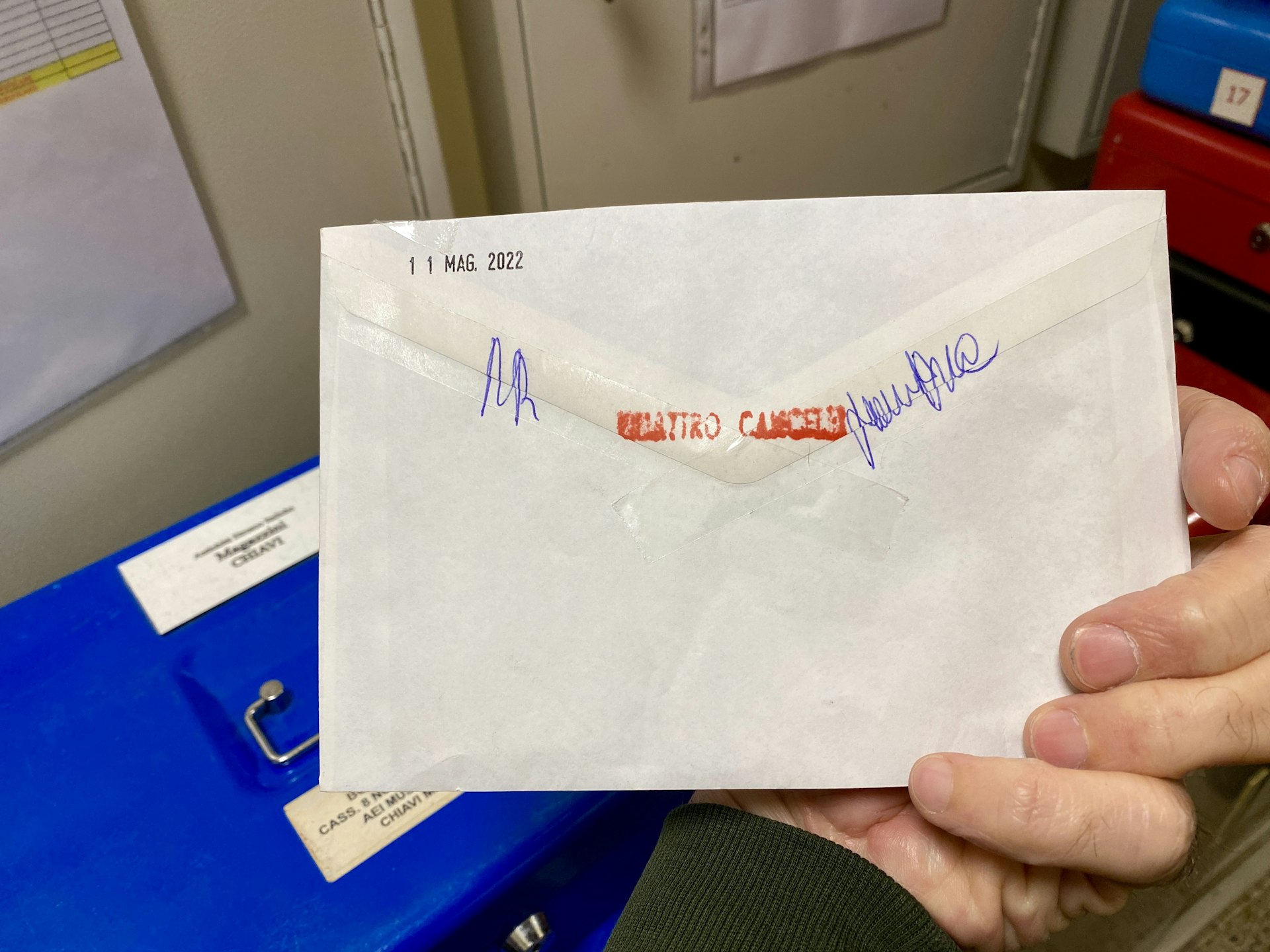
Crea hands me the envelope and I casually tuck it away in the back pocket of my jeans — it’s a long walk to the Sistine Chapel and I need my hands to take notes and snap pictures.
As we saunter through the museums, no words can describe the extraordinary experience of watching the rooms come to life at the flick of a light switch, soundtracked by Crea's spirited commentary. Inside Museo Pio-Clementino, Crea nonchalantly removes a rope and takes me behind the Laocoön, one of the most famous ancient sculptures in the world, like we are peeking behind a TV console in his living room (yes, the rumors are true — the original arm is attached to the back of the statue!). We ascend the original Bramante Staircase — closed to the public in most cases — for an extraordinary morning view across Rome. The Gallery of Maps, probably the second most dazzling gallery in the Vatican Museums after the Sistine Chapel, illuminates like the lights of Heaven’s Gate when the electricity is turned on (so astonishing, we do it twice).
Finally, we arrive at the Sistine Chapel. Crea tells me to get to it. “I’ve lost the key,” I joke. "Nooooooooooo!" says Crea with a wry smile. I turn the key to the left. The door opens. And there it is: The most legendary, most eye-popping, most creatively-astonishing room in the world. Empty — there are no words.
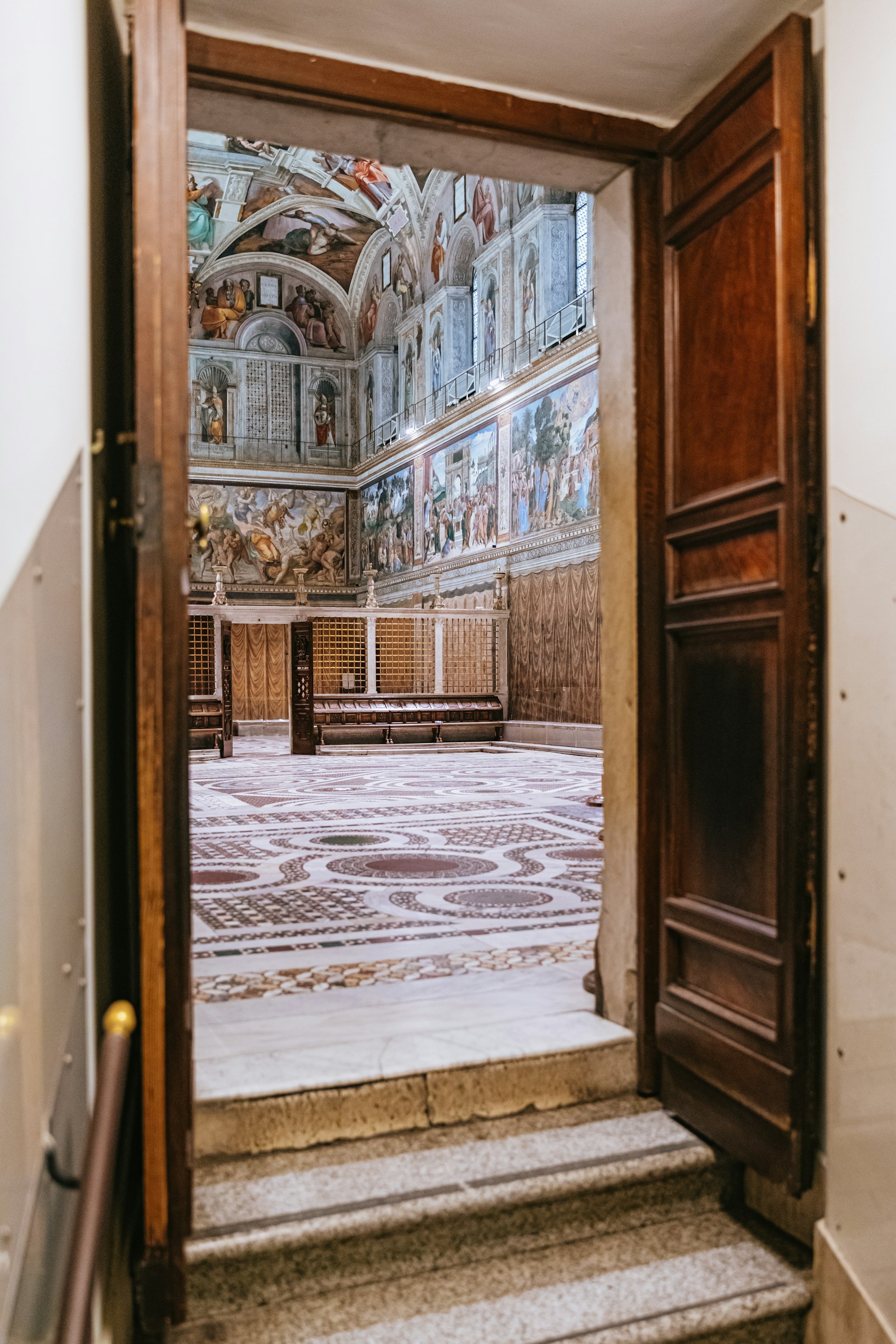
So, how can you experience this once-in-a-lifetime, clavigero-guided tour of the Vatican yourself? Well, currently, the only way is to enter GetYourGuide’s "Turning the Lights On at the Vatican Museums" contest . Other tours offer access with clavigeri, but only one will get you face-time with Crea.
But there are a lot of other fantastic ways to do the Vatican — including exclusive private tours to options that won't break the bank.
The Vatican Museums house one of the world’s most immense collections of ancient sculptures and Renaissance art — some 70,000 works in total, of which 20,000 or so are actively displayed in 24 interconnected galleries across 7 km of museum space. It’s overwhelming —and it’s crowded. Pre-COVID numbers in 2019 recorded some 6.9 million folks through the turnstiles. Is there a way to keep your sanity along the way?
Sì, signori! Depending on your budget, the options are as daunting as the museum itself.
Everything you need to know before visiting Rome
Vatican Museums on the cheap
The absolute cheapest route is booking admission tickets directly (do it well in advance, up to 60 days), which nets you an unprecedented laundry list of world-class art for less than the price of a gourmet pizza back home (adult/reduced €17/€8 plus a €4 reservation fee and optional audio guide €7). Post-COVID, booking online in advance is compulsory.
If the goal is the Sistine Chapel at its quietest, show up at least 1.5 to two hours prior to the 9 am opening to ensure a strategic position in line (keeping in mind you will not be the only person with this idea!). High tail it direct to Michaelangelo‘s masterpiece following the shortcut signage and you’ll arrive before most of the masses. Afterwards, work your way backwards to see everything you flew by when the doors opened.
You won’t have the Last Judgement to yourself, but it’s the best you can do on a budget.
Top things to do in Rome
Early access, semi-private and group tours
Another way to beat the crowds at the Vatican Museums are early morning and evening semi-private and group tours. The Vatican itself offers both a Prime and Prime VIP Experiences, both of which tour the museum one hour before opening. Though you won’t get the clavigero as your tour guide, you will be led by an authorized educational guide who will notably enhance your overall experience.
The difference between the two experiences is group size and price: Prime groups host up to 25 people for €63 per person. The Prime VIP limits the group to 10 for €45 per person; both tours include breakfast and a guided tour through the Upper Galleries (Candelabras, Geographical Maps, and Tapestries), the Raphael Rooms and the Sistine Chapel. Other parts of the Museums may be visited without the guide after breakfast during normal opening hours.
Various independent tour companies offer similar early access and night tour options ranging in price between €50 and €100; and of course semi-private and group tours are available throughout the day as well. Skip-the-Line access for St. Peter’s Basilica is often offered as well.
Private tours of the Vatican
Private tours of the Vatican are similar in style to semi-private and group tours, but are just for you and yours. They will usually involve entering one hour before opening time, include breakfast in the Pinecone Courtyard, and feature a dedicated guide. Most options settle in around €150 to €250 per person.
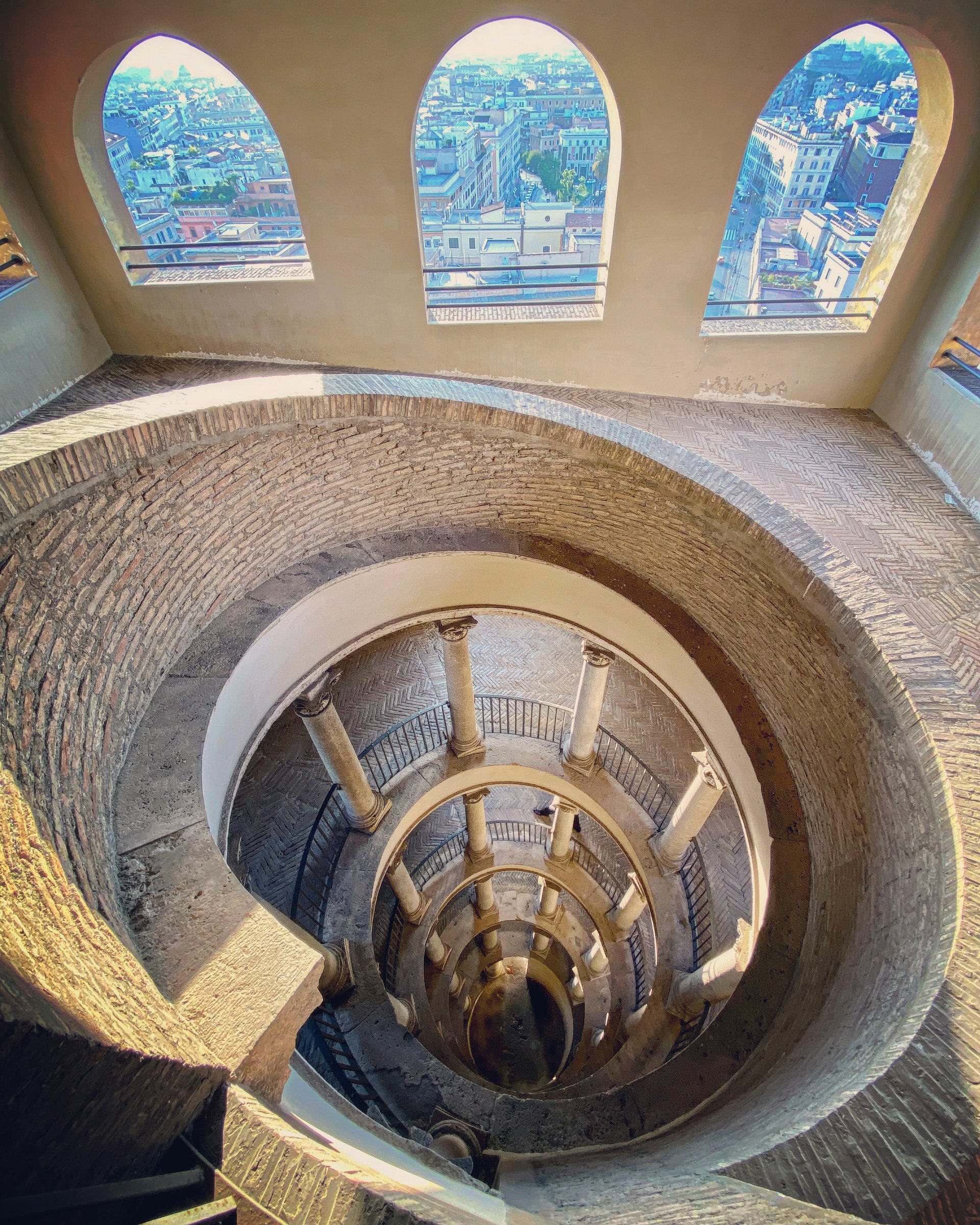
Some of these tours will even including off limit highlights, such as the original Bramante Staircase, and sometimes explore deeper into galleries that other tours cast but a tertiary glance.
If you are looking to unlock your way to the Sistine Chapel with a clavigero, that’s possible, too, with numerous private companies offering the experience from around €300 per person and up (options with UK-based True Travel, who includes the experience has part of a broader package that includes hotel accommodation, transfers and other sightseeing experiences, start from €2500 to €3000 for two people).
You won’t get the boss (Crea) — one of his staff usually leads these tours — or his remarkable stories. But you will experience the Vatican Museums like few others have.
Explore related stories
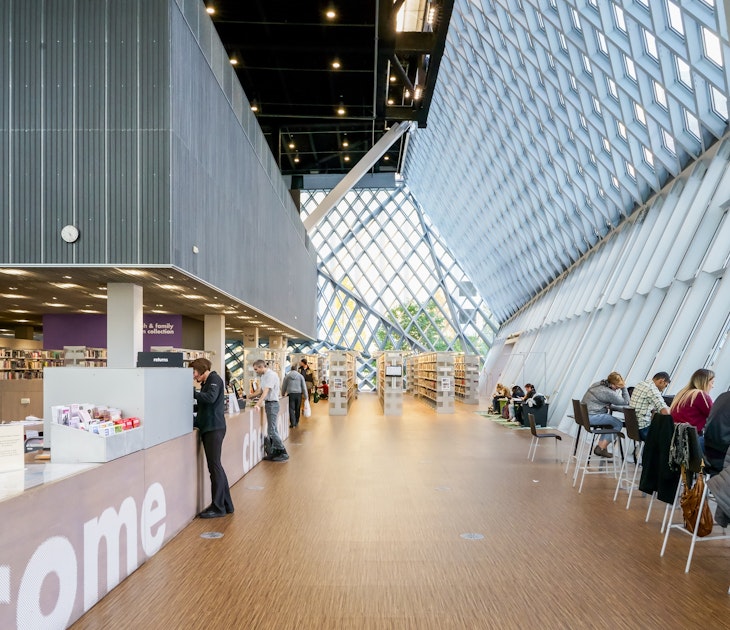
Apr 4, 2024 • 7 min read
From open-air art galleries to natural wonders, there's no shortage of ways to experience the best of Washington state for free.

Feb 23, 2024 • 8 min read

Jan 9, 2024 • 4 min read

Nov 1, 2023 • 7 min read
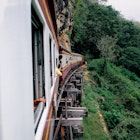
Oct 16, 2023 • 6 min read

Apr 10, 2024 • 6 min read
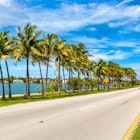
Apr 10, 2024 • 8 min read
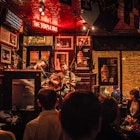
Apr 10, 2024 • 10 min read

Apr 9, 2024 • 5 min read
Top Things to See at the Vatican Museums
The Vatican Museums contain a vast store of artworks which range from the ancient to the contemporary, including the world-famous Sistine Chapel . Touring the Vatican Museums can easily take two hours or more (days if you have a broad range of interests), so it is imperative that you have an action plan when you visit. You may have works of art that have meant something to you all your life that you want to see firsthand. Or, you are an architecture buff and want to make sure you see all the architectural details.
There are many museums ranging from a lapidary museum to an Egyptian museum. There are an impressive carriage museum and a collection of contemporary art. So, it's important to tailor your visit to your interests. The Vatican website also maintains a current list of opening and closing times for the museums which will help you with your planning.
Here is a list of the top attractions to look for when you visit the Vatican Museums including key works of art, archeological areas, architecture and more. For a complete list, visit the Vatican Museums website .
Sistine Chapel
The Vatican Museums' curators were wise to put the Sistine Chapel at the end of the museum tour, as it is the absolute highlight of the visit.
Here you can take in the majesty of Michelangelo's ceiling and altar frescoes as well as paintings by other Renaissance greats such as Perugino, Botticelli, and Rosselli.
The Sistine Chapel stands on the foundation of an older chapel which was named the Capella Magna. In 1477, Pope Sixtus IV ordered a restoration of the chapel which, upon completion, was named for him.
Raphael Rooms
The Raphael Rooms are important to visit. Raphael worked on the mesmerizing frescoes in these four rooms—the apartments of Pope Julius II—while Michelangelo was painting the Sistine Chapel. The paintings include several significant scenes from Christian history.
The most famous room of all is the Room of the Segnatura, in which Raphael painted The School of Athens , a scene that incorporates the likenesses of Raphael's artistic contemporaries, such as Leonardo da Vinci and Michelangelo.
Borgia Apartment
The artist Pinturicchio painted the rich frescoes in the rooms of the Borgia Apartment , the area on the first floor where Pope Alexander VI lived. The rich, colorful frescoes depict scenes from Egyptian and Greek mythology and speak to the lavishness of the Vatican Palace.
Gallery of Maps
This incredible hall has maps frescoed on both walls showing various parts of Italy from the 16th century. These historically significant frescoes of the Italian cities, the countryside, and geographical features, such as the Apennine Mountains and the Tyrrhenian Sea, are a joy to inspect, as is the gallery's sumptuously decorated coffered ceiling. The gallery was reopened in 2016 after a restoration of the art.
Cappella Nicolina
Some of the most beautiful and vibrant 15th-century frescoes, painted by Fra Angelico and Benozzo Gozzoli, are in the diminutive Niccoline Chapel . Named for Pope Nicholas V, who worshiped here, this chapel is located in one of the oldest parts of the papal palace.
Greek and Roman Antiquities
The Pio-Clementine and the Gregorian Profane Museums are dedicated to treasures of antiquity. Highlights include the Apollo del Belvedere , "a supreme ideal" of classical art; the Laocoön , a large marble composition from 1st century A.D.; the Belvedere Torso , a Greek sculpture from the 1st century B.C.; the Discus Thrower , a 5th century B.C. representation of an discus athlete in movement; and a collection of Roman mosaics.
Vatican Museums Tours
TripSavvy / Christopher Larson
Taking a guided tour is a great way to navigate the vast maze of things to see in the Vatican Museums.
There are tours for individuals, families, groups, religious pilgrims and for blind or deaf visitors. You can tour the museums, villas and gardens, and archeological areas. Some tours are guided.
Tickets to visit the Vatican Museums can be purchased online .
How to Visit the Vatican Museums and Sistine Chapel in Rome
The 25 Top Attractions in Rome, Italy
8 Best Things to Do in Vatican City
How to Visit the Sistine Chapel and What to See
Vatican City Travel Guide
Art of Michelangelo in Florence
Take a Sistine Chapel and Vatican Museums Tour
22 Things to Do in Central Naples, Italy
The 14 Best Day Trips from Rome
Borghese Gallery: A Complete Guide
Disney Magic - Western Mediterranean Cruise Travel Log
The Top 23 Things to Do in Italy
10 Unique Guided Tours in Rome
20 Best Things to Do in Florence, Italy
3 Days in Rome: What to See and Do
Essential Ancient Sites to Visit in Rome

Guide to Visiting the Vatican Museums
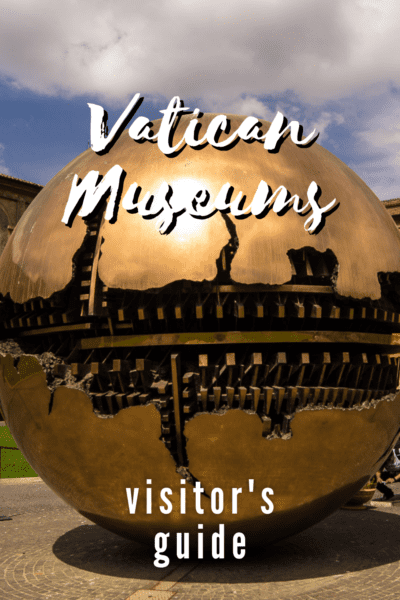
No trip to Rome is complete without visiting the Vatican Museums. With their world-famous artwork and awe-inspiring architecture, these museums offer visitors a glimpse into the history and culture of the Catholic Church. But with so much to see, it can be difficult to know where to start.
We’ll answer all your questions in this article. This guide to the Vatican Museums will help you make the most of your time so you can enjoy every minute of your visit.
ⓘ TIP: If you’ll be visiting Rome for a few days, be sure to check out the helpful travel planning links at the end of this article.
Where is the Vatican in relation to the City of Rome?
Vatican City is located on the west bank of the Tiber River, about 2.5 miles (4 kilometers) north of Rome City Center. The area that is now the Vatican City was once part of an independent country known as the Papal States.
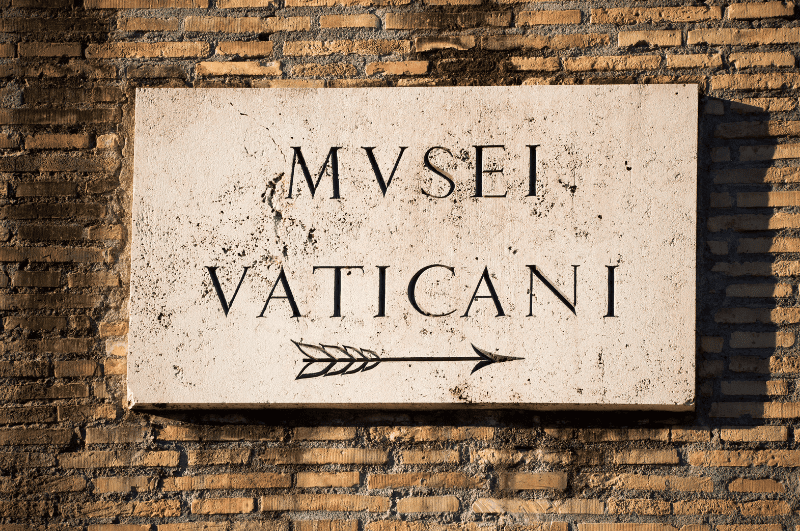
Is Vatican City a separate country? Do I need a passport?
You do not need a passport to enter Vatican City. The Vatican has an open-border policy with Italy, so if you have a visa or the right to enter Italy, you can enter the Vatican City too.
There are no Vatican City entrance fees, either.
In 1870, the Papal States were annexed by Italy and became part of the Kingdom of Italy. Then in 1929, an agreement known as the Lateran Treaty was signed between Italy and the Holy See (the governing body of the Catholic Church), which recognized the Vatican City as an independent state.
How do I get to the Vatican from Rome?
Fortunately, getting into the Vatican is super easy. Depending on your preferences, you can either take the Metro, a bus, a cab, a tram or just walk.
ⓘ TIP: For exact directions to the Vatican Museums, use this Google Maps link .
How to take the Metro to the Vatican
The Metro is the most convenient way to get to Vatican City. Take Line A to Ottaviano-S. Pietro metro stop. From there, it’s a 5-minute walk to both the Vatican Museums and St Peter’s Square.
ⓘ TIP: The two metro stops closest to the Vatican are Cipro and Ottaviano. If you arrive early in the morning or later in the afternoon, use Cipro, which is closer to the Vatican Museums’ entrance. Ottaviano is preferable when the crowds get larger during mid-day.
How to take the bus to the Vatican
If you don’t want to walk or take the Metro, another option is to take one of Rome’s many buses. Bus numbers 40, 64, 81, 982, and 990 all go to Vatican City.
Bus 49 stops in front of the Vatican Museums. Bus 64 stops at Cavalleggeri/S. Pietro, which isa 10-minute walk from the Vatican Museums.
How to take a taxi to the Vatican
Finally, if you’re feeling lazy or are in a hurry, you can always take a cab. Just be warned that cabs in Rome can be expensive, so this may not be the best option if you’re on a budget. Uber is also an option, but it’s even more costly.
How to take the tram to the Vatican
Depending on where you are located, you may be able to take the #19 tram down to the St Peter’s metro stop. It’s not a convenient option if you’re coming from Rome city center, however.
Can I walk to the Vatican from Rome City Center?
Yes. From Piazza Navona, you can walk to Vatican City in 15-20 minutes. However, it may be a bit too much walking for some people, especially in the summer heat. If you decide to walk, be sure to wear comfortable shoes and bring a bottle of water with you.
How large are the Vatican Museums?
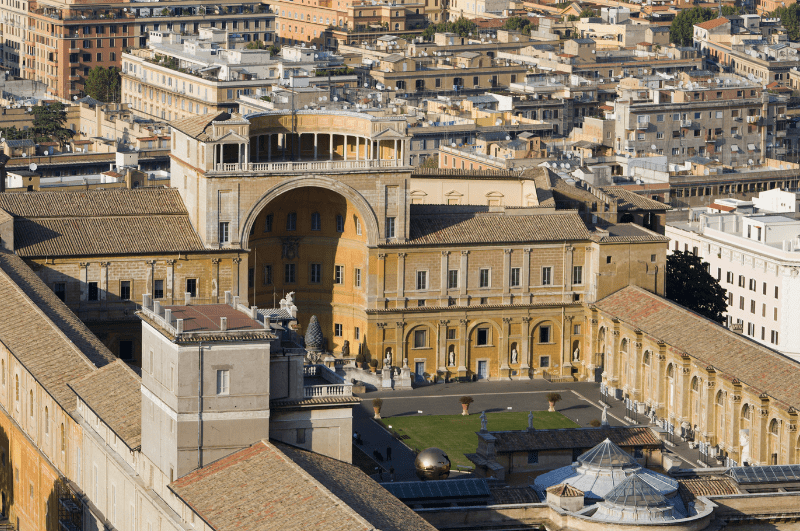
The Vatican Museums contain over 70,000 works of art, which are held in 54 galleries spread out over 7 miles (12 kilometers).
To put that into perspective, it would take you about 2 hours to walk through all the Vatican Museums if you walked at a brisk pace without stopping to look at anything!
How much time is needed to visit the Vatican Museums?
How long to visit the Vatican Museums and Sistine Chapel depends on your interests and whether or not you have skip-the-line tickets. In peak summer months, with queues up to 1 km long, it could easily take 90-120 minutes just to get inside the building.
- Most people spend 3-4 hours touring the Vatican Museums , even if they’re only spending one day in Vatican City.
- If you only want to see the Sistine Chapel, it will take 1 hour minimum. The museums are so extensive that it takes 30 minutes to walk directly from the Vatican Museum entrance to the Sistine Chapel door. You then have to clear an additional metal detector before being allowed entry.
- If you intend to see any of the attractions along the way, such as the papal apartments or the Raphael Rooms, plan to spend at least 2 hours at the Vatican Museums.
- Most guided tours last for about 3 hours. This is the best way to ensure you see all the Museums’ highlights in the least amount of time.
All that said, museum-goers should seriously consider spending a full day here. There are so many things to see that you could explore for days and not see it all.
Some museum highlights include classical sculptures and Renaissance paintings in the papal art collection, frescoes by Michelangelo and Raphael, painting and sculpture galleries, Egyptian mummies, and the private apartments of Pope Julius II.
And of course, there are two Michelangelo masterpieces in the Sistine Chapel that you absolutely must see during your visit: The Last Judgment altarpiece (with more than 300 figures!) and the ceiling of the Sistine Chapel itself.
Want to read this later?
Save this pin on your favorite Pinterest travel board.
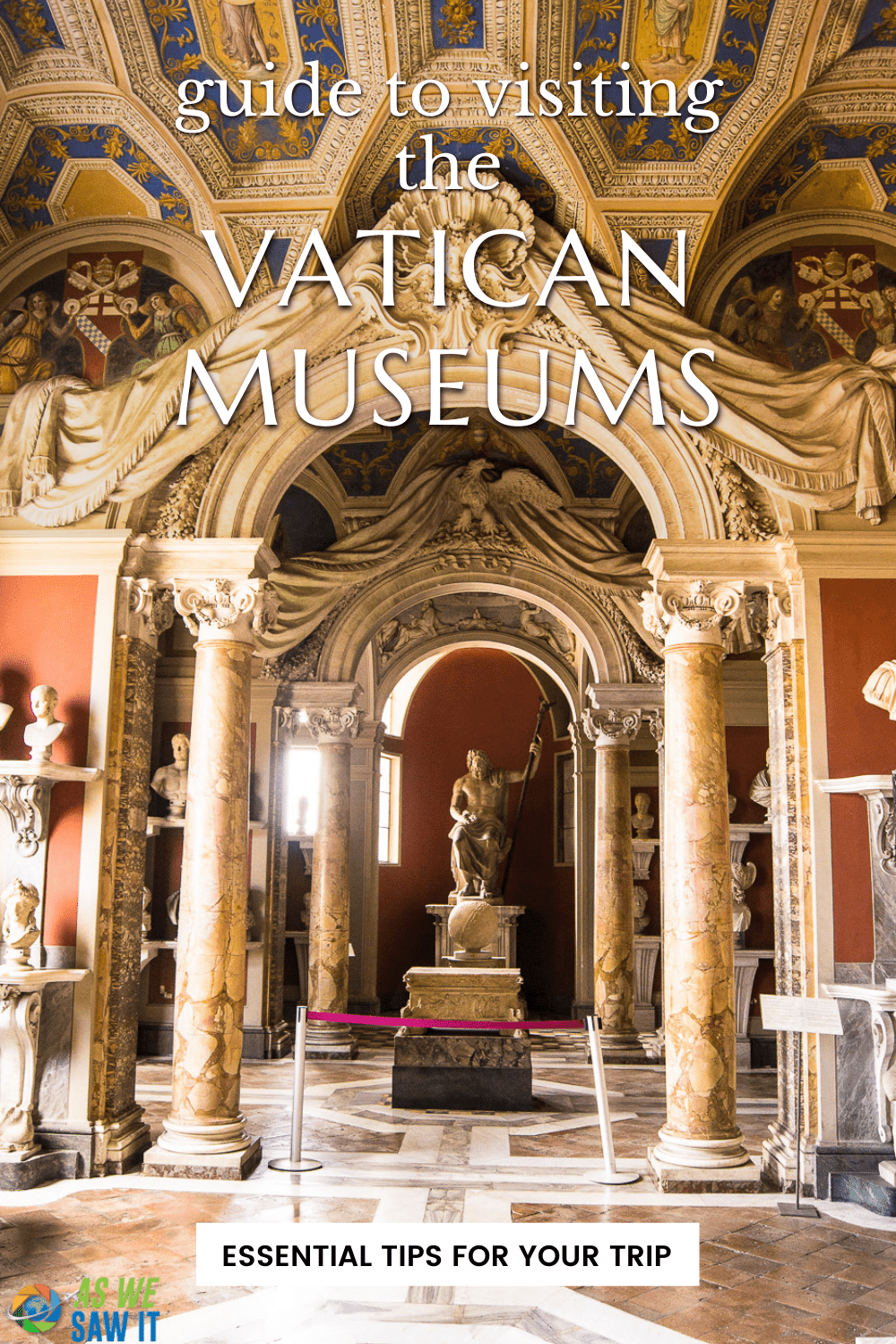
What time do the Vatican Museums open?
The Vatican Museums opening hours are as follows:
- From Monday through Thursday, the museums are open from 9:00 am to 6:00 pm, with final entry at 4:00 pm.
- On Fridays and Saturdays, the museums close at 10:30 pm, with final entry at 8:30 pm.
The Vatican Museums are closed on Sundays. However, every last Sunday of the month, you can visit between 9:00 am – 2:00 pm. The final entry is at 12:30.
What are the best days to visit the Vatican Museums?
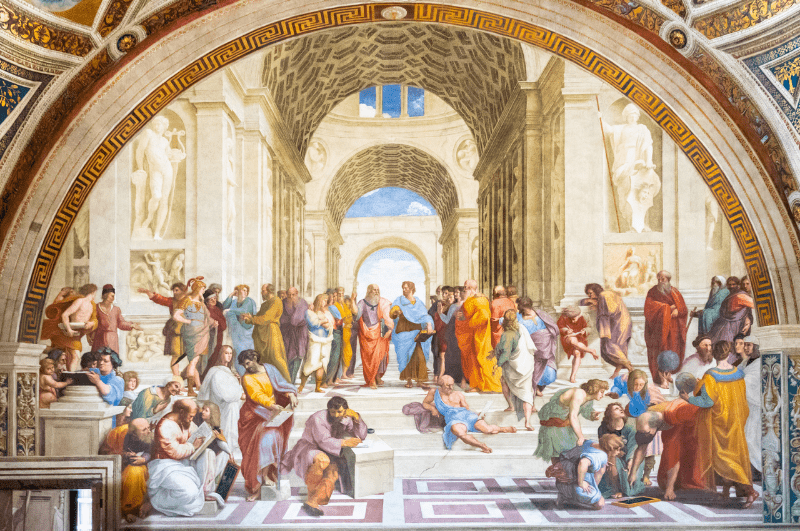
If you want to avoid the tourist hordes as much as possible, plan to visit on a Tuesday or Wednesday. Avoid Mondays, when most museums in Rome are closed, so more visitors come here.
Also avoid the last Sunday of the month, when admission is free. They are extremely crowded at this time, which makes it harder to see the art.
The Vatican Museums are always closed on Easter Sunday, June 29 (the feast of Sts. Peter and Paul), December 8 (Feast of St. Mary), December 25 (Christmas Day), and December 26 (Feast of St. Stephen).
How much does it cost to visit the Vatican Museums?
The cheapest way to get into the museum will always be via buying the regular Vatican Museum admission tickets at the door. A standard Vatican Museum ticket costs €17 (about $18). After 4:00 pm, you can purchase a reduced-price admission from the ticket office for €8 (about $9). But you won’t have much time to look around.
The next cheapest is the fast-track “skip-the-line” option, which lets you zip right in.
Tours are a bit more expensive, as you have a guide who will take you directly to the best works in the building and give an informative commentary along the way. You’ll save time and energy, not to mention have a great time learning about all the fine art you came there to see.
Is there free entry to Vatican Museums?
Every last Sunday of the month, visitors can enter at no charge (subject to the Calendar of museum closures). Expect intense crowds.
Other people who can enter free:
- Children below the age of 6.
- Directors of museum institutions, managing boards, and other bodies engaged in the protection of archaeological, historic, and artistic heritage.
- Disabled visitors and a companion can get priority entry (without queuing in line) through the official Vatican Museums ticket office. Learn more here.
Is there a separate admission for the Sistine Chapel?
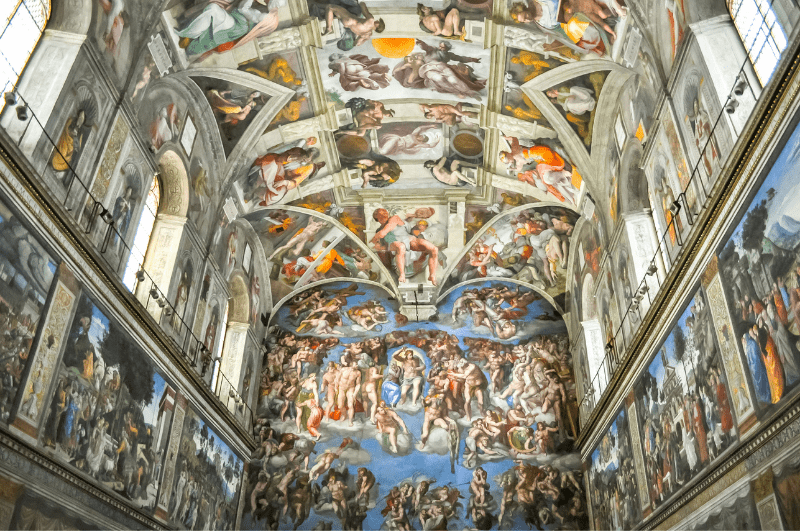
No. The Sistine Chapel is included with your museum entry at no extra charge. Anyone who tries to sell you Sistine Chapel tickets is a fraud. Run away.
What does a Vatican Museum ticket include?
With a purchased admission to the Vatican Museums, the Sistine Chapel, the Raphael Rooms, and all of the other galleries and collections are included.
Once you enter the Museum, you can stay inside for as long as you want. However, should you choose to leave for any reason, there is no re-entry.
How do I avoid the long ticket lines?
If there’s one thing you should do on your visit to the Vatican, it’s to buy your Vatican Museum tickets online ahead of time. Trust us: It’s not fun to stand in the hot sun for hours on end, knowing that you’re wasting valuable sightseeing time.
The best ways to skip the lines at the Vatican Museums are:
- Buy a skip-the-line ticket online from a trustworthy seller. Once you have it, all you’ll have to do is show up on the day of your visit and breeze through the entrance. ( Tip: This skip-the-line ticket from Get Your Guide includes a free audio guide and a 20% discount at the Vatican Museums online shop.)
- Book a guided tour. This is the best way to be sure you don’t waste time and don’t miss a thing. In addition to breezing right in, you’ll also learn a lot about the art and history of the Vatican Museums from a knowledgeable guide. Take Walks offers some of the most in-depth tours available.
- Stand in the right queue. There are 3 lines to enter the Vatican Museums: one for people who don’t have tickets yet, one for those who already purchased regular admission tickets online, and a third, fast-track one for skip-the-line ticket holders. Make sure you’re on the right queue.
- Buy a combination ticket that includes museum entry along with other attractions in Rome. One example is the 3-day OMNIA Roma Pass Vatican Museum card . It includes all top sights in Vatican City, free admission to your choice of 2 top Rome attractions, a 3-day hop-on hop-off bus tour, discounts at 30 other sights, and a travel card. You will also receive a free guidebook and map to help you plan your itinerary as well as dedicated itineraries that allow you to explore the city at your own pace.
ⓘ BUDGET TIP: You may see touts approaching the queue, offering tours that will let you skip the line. Avoid them. They are often sub-par and a waste of your precious money.
How do I avoid crowds in the Vatican Museums?
- Time your visit wisely. If you arrive when the museums open or right before closing time, you’ll avoid the worst of the crowds. The busiest time for visiting the Vatican Museums is between 10:00 am and 3:00 pm.
- Book an early morning tour. A few select tour companies have access to the museums outside of normal visiting times. Walks of Italy offers an early-entrance small group tour that will let you visit without the crowds.
- Tour after the museums close for the day. This special access tour includes a full tour of the Vatican Museums and Sistine Chapel (excludes St Peter’s Basilica, which closes at 7 pm).
If you only have one day at the Vatican, you should seriously consider visiting outside of scheduled hours. It leaves you more daylight hours to enjoy exploring the rest of Vatican City.
What is the dress code for visiting the Vatican Museums?
The dress code for visiting the Vatican is relatively strict. Both men and women must cover their shoulders and knees.
This means no tank tops, strapless shirts, miniskirts, or shorts. If you’re not sure if your outfit meets the Vatican visitor dress code requirements, it’s always better to err on the side of caution and dress more conservatively.
If you’re visiting St Peter’s Basilica after the museums, dress more conservatively because there is a stricter dress code here. You will be asked to remove your hat.
ⓘ TIP: Vatican visits in the summer months can be quite hot and stuffy. Be sure to wear light and comfortable clothing.
What’s the security like? Are there any prohibited items?
All visitors to Vatican City must go through a security screening, which includes a bag check and metal detector. Prohibited items include weapons of any kind, pocket knives, scissors, spray cans, and umbrellas.
It is also important to note that taking photos inside the Sistine Chapel is strictly forbidden. If you ignore this rule you can expect to be removed from the chapel by security guards.
Can I bring a backpack or a large bag into the Vatican Museums?
No, backpacks or large bags are not allowed within the Vatican museums. You will have to check them.
Where can I eat in the museum?
If you bring food or beverages, they are forbidden in exhibition rooms. However, if you are on a tour you may bring your own lunch and eat in the gardens. (You cannot access the gardens unless you’re on a tour.)
You can also eat at two facilites: a cafe-style eatery and a pizzeria. The food hall is downstairs near the museum entrance. But don’t expect to be impressed.
Alternatively, some of the more enchanting tours include meals, like the pre-opening VIP Pristine Sistine Vatican Tour with Museum Breakfast or After Hours at the Sistine Chapel: Vatican Museums & Aperitivo .
Is photography allowed in the Vatican Museums?
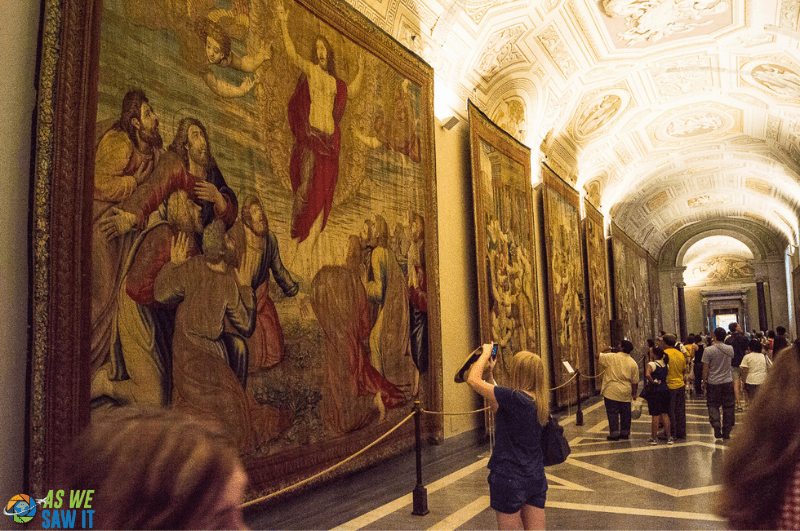
Yes, but only without a flash. You can take photos and videos throughout the museums (excluding the Sistine Chapel) and in the Vatican Gardens.
Remember that the Vatican Museums attract millions of tourists each year, so keep your camera or phone stowed away (without a flash!) when visiting some parts of the museums. Be mindful to avoid disrupting other visitors.
Finally, note that selfie sticks are not allowed in the museums or St Peter’s Basilica.
Are there any other things to do in Vatican City?
Sure! In addition to visiting the museums and St. Peter’s Basilica, there are quite a few things to see and do in Vatican City. However, you’ll need to be on a guided tour to access some of them.
Read all our Rome & Vatican blog articles: Things to See in Rome in 2 Days , Things to Know Before Visiting Vatican City , Best Things to Do in Vatican City , Guide to the Vatican Museums , and Tips for Visiting the Colosseum.
Cruising to Rome? Best Things to Do in Civitavecchia Cruise Port , How to See Rome on Your Own from Civitavecchia Cruise Port , and How to Go from Civitavecchia Port to the Train Station will be helpful.
Share this story with others
Written by Linda
Linda is multilingual and has been to over 50 countries. Her insatiable love of travel, cuisine, and foreign languages inspired her to create As We Saw It, where she documents her trips, shares practical itineraries, and offers insider tips. She’s passionate about helping fellow travelers save time, money, and hassle, and loves to discover new places to explore.
You may also like...
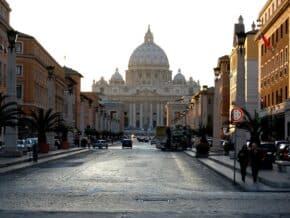
10 Things You Must Know Before Visiting Vatican City
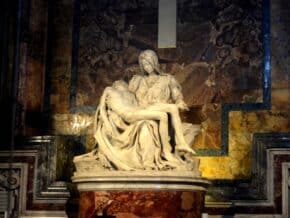
7 Best Things to Do in Vatican City (Itinerary Ideas)
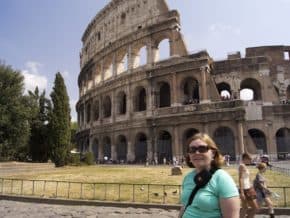
10 Best Things to See in Rome in 2 Days

- Africa Africa
- Cambodia Cambodia
- Malaysia Malaysia
- Nepal Lifetime Experiences!
- Philippines
- Singapore Singapore
- Taiwan See our Taiwan destination page for more.
- Curacao Travel photos and articles
- Dominica Exhilarating adventures, breathtaking landscapes and fairy-tale coral reefs
- Jamaica Heartbeat of the World
- Sint Maarten/ St Martin The Friendly Island
- Belize Belize
- Panama Panama
- Andorra Andorra
- Austria Austria
- Belgium Where Benelux begins
- Croatia Croatia
- Czechia Czech Republic
- France France
- Germany Germany
- Greece Greece
- Hungary Hungary
- Ireland Ireland
- Italy Italy
- Montenegro Montenegro
- Netherlands Netherlands
- Slovakia Slovakia
- Spain Spain
- Switzerland Switzerland
- U.K. United Kingdom
- Vatican City Vatican City
- Israel + Palestine Land of Creation
- Saudi Arabia Hello World
- Türkiye You Will Want to Stay Forever
- United Arab Emirates Discover all that’s possible
- Mexico Mexico
- United States United States of America
- Australia There’s NOTHING like Australia.
- New Zealand New Zealand travel inspiration, articles, and tips for curious travelers
- Argentina Argentina travel inspiration – destinations, things to do, and tips for the curious traveler.
- Brazil Brasil – sensational!
- Colombia Colombia is magical realism
- Ecuador All you need is Ecuador
- Peru Land of the Incas
- 1-day itineraries
- Weekend Getaways
- 1- to 2-week itineraries
- food and drink
- Things to Do
- travel planning
- know before you go
- cruise ports
- cruise tips
- Viking Grand European Tour Daily journal entries from our Grand European Tour, a river cruise from Budapest to Amsterdam, with activities, experiences and tips.
- photo gallery Travel photos by As We Saw It
- photo essays Photo Essays
- photography tips Photo Tips

Ultimate Guide To The Vatican Museums: Masterpieces & Tips
The Vatican holds one of the world’s greatest art collections. Some of the most famous art works on the planet are there. If you’re an art or history lover, the Vatican is a must see site in Rome .
But the Vatican is a vast and intimidating place.
You could easily stare in awe at the Raphael Rooms or the Map Rooms and forget that they are actual paintings on display in the Vatican Museums. Beautiful paintings, by the greatest masters of Italian art.
If you want to be dazzled by the likes of Leonardo da Vinci and company, plan to spend a good few hours in the Vatican museums.
If you want to see everything else in Vatican City, you should commit most of the day. To inspect every last thing, well, that would require days.
It’s important to know what to see at the Vatican in advance because there are 26 museums inside the Vatican and a wall space of 5 miles.
In this Vatican Museums guide, I identify 20 must see masterpieces in the Vatican Museums and give you must know tips for visiting.
Overview of the Vatican Museums
There’s over 70,000 densely packed works of art (not all on display). That’s a lot of ground to cover. You need to know in advance what you absolutely shouldn’t miss at the Vatican.
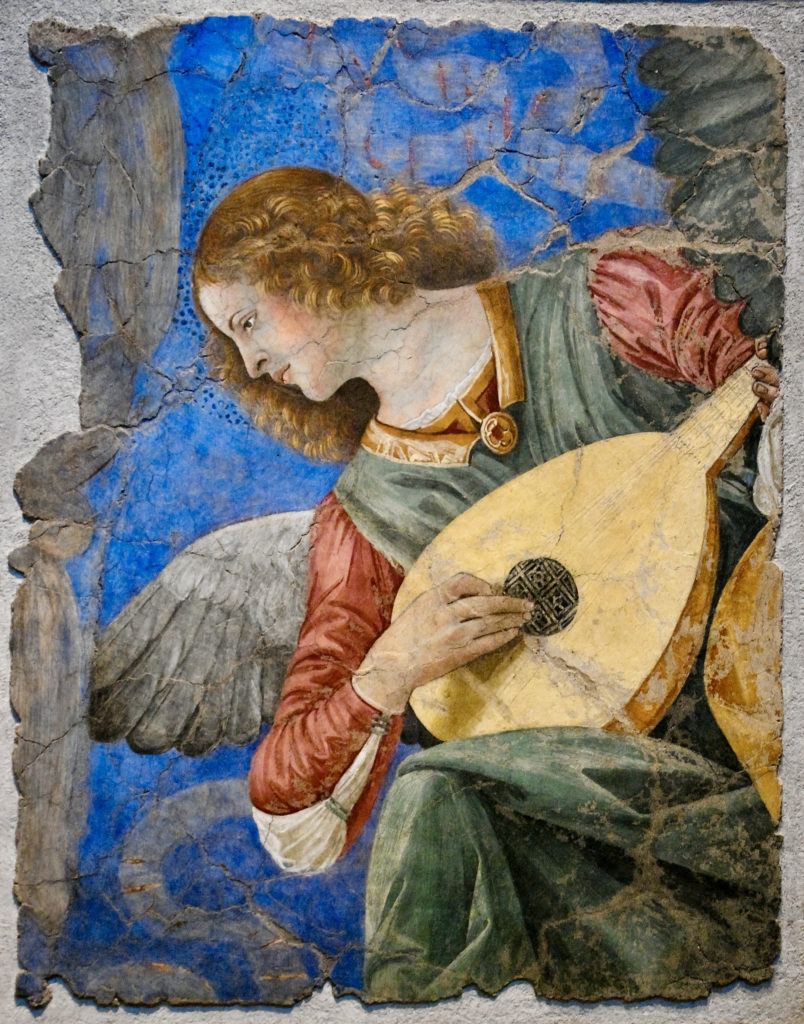
The last time I was in Rome, I went to the Vatican Museums twice, the first time on a skip-the-line small group tour and the second on a DYI mission to see everything the tour left out (quite a lot as it turned out).
There’s a museum path that takes you through the long corridors and wings of the Vatican Museums. On the first floor, you’ll find the Vatican Pinacoteca, the Pio-Clementine Museum, the Chiaramonte Museum, the Gregorian Egyptian Museum, and the Gregorian Etruscan Museum.
The latter three are very specialized museums that you can add to your Vatican itinerary if you’re interested and have the time.
The Vatican Pinacoteca is essentially a small painting gallery within the Vatican museums. It opened in 1930 and contains the papal easel collection.
The gallery gives you a historic and chronological overview of the development of Western painting. 18 rooms hold the Vatican’s most precious paintings.
The Pinacoteca is often overlooked. It’s in a newer section of the Vatican and rarely covered on standard Vatican tours.
It’s not in the direction of the signs pointing to the Sistine Chapel either. But it’s an absolutely essential detour for art lovers. There’s an entire room full of Rapahels!
Opened in 1932, the Pio-Clementine Museum is the oldest art collection in the Vatican Museums. It houses ancient Greek and Roman sculptures.
It’s named after the two popes who oversaw its foundation, Clement XIV and Pius VI. You’ll stroll through parts of the museum on a standard tour. In the center of the museum is the 18th century Octagonal Courtyard, with fountains, trees, and benches.
On the second floor, you’ll find the Tapestries Hall, the Gallery of Maps, and the Raphael Rooms. The Raphael Rooms are four rooms, which were the public rooms of the pope’s personal apartments in the time of Julius II.
They were painted by the famous Raphael. The most famous fresco is The School of Athens .
Your last stop will be the stunning Sistine Chapel, with the world famous Michelangelo frescos . Unless you’re on you own, you’ll probably won’t see the Raphael Rooms or the Borgia Apartments. They’re not on the “short cut” route to the Sistine Chapel, which most tour guides use.
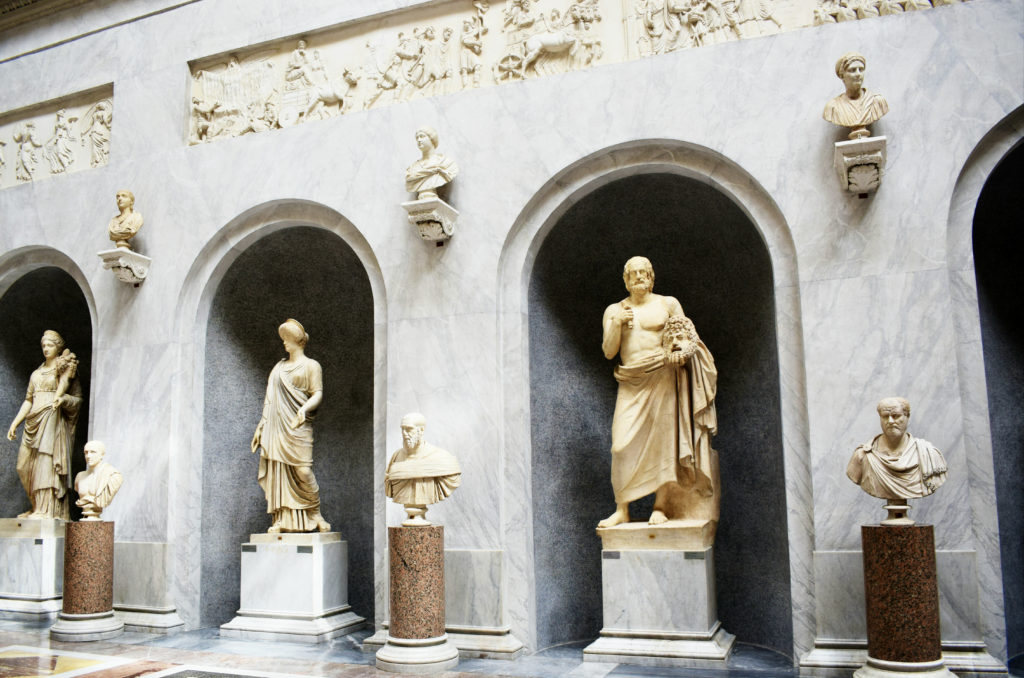
Should You Take A Vatican Tour?
I’m going to spend some time on this issue because it’s very important. You don’t want to be there, at the Vatican, and not see something that’s important to you.
If you can, I think you should take a guided tour and then do a DIY tour. I’ve done the Vatican many time both ways. If you’re a first timer, you’ll likely want a tour.
If you don’t book a guided tour, you absolutely must pre-book a skip the line tickets . Or else you’ll be stuck in line for hours unless it’s the dead of winter.
Most guided tours don’t cover everything in the Vatican. For example, you will likely miss the Raphael Rooms and the specialty museums.
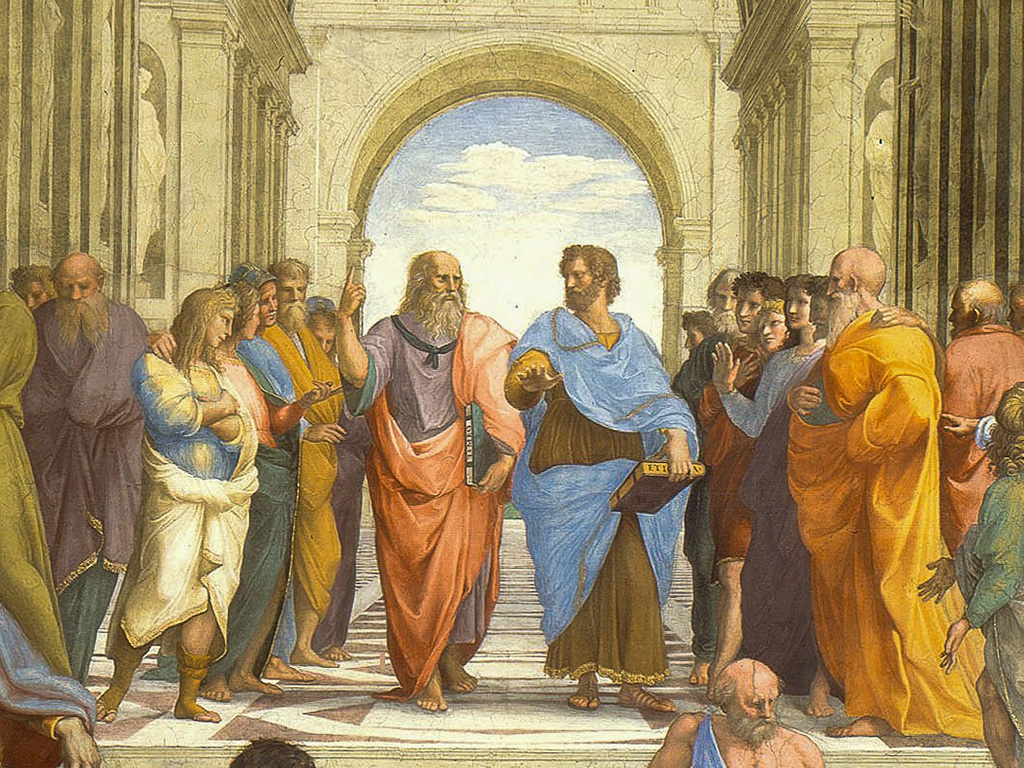
Here are your Vatican tour options. You can pick a tour tailored to your own interests and museum going tastes.
- a 2. 5 hour overview on a skip the line small group guided tour
- a 3 hour no w ait tour that also includes the Raphael Rooms
- a 3.5 hour tour Vatican visit with a guided tour of St. Peter’s Basilica
- a 3 hour Friday night tour of the Vatican
- a Vatican tour that includes a climb of the dome of St. Peter’s Basilica
- a small group Sistine Chapel first entry experience with Vatican Museums (good for early birds)
- a 2-3 hour private tour of the Vatican
If you’re taking a guided tour, you’ll access St. Peter’s Basilica from the back left corner of the Sistine Chapel. Once inside the basilica, you cannot re-enter the Vatican Museums.
So make sure you’ve seen everything you want to see at the Vatican before venturing into the basilica.
If you want to see all the top attractions in Vatican City besides the museums, here’s my one day in Vatican City itinerary .
Guide To The Vatican Museums: 20 ArtWorks
Ah, now down to what to see at the Vatican. There are millions of artworks and paintings to see. There are endless rooms and crowded display cases.
We’re speaking of beautiful, groundbreaking works of art. The art history major in me can’t help rhapsodizing.
1. Raphael, Transfiguration , 1520, Pinacoteca Room 8
The beautiful Transfiguration is in Room 8 of the Pinacoteca. It was painted by Raphael , one of the greatest painters of the Renaissance period.
The Transfiguration was commissioned by Cardinal Guilio de Medici, who later became Pope Clement VII. The dramatically lit painting was critically acclaimed, and carried at the head of Raphael’s funeral procession to the Pantheon .
The painting combined two biblical narratives. It tells the story of Christ leading his disciples up a mountain to show them his true form, a being of pure light. It also depicts a miracle — when Christ exorcized the demons of a young boy suffering from lunacy.
Why is the Transfiguration important? It bridges the period between the high Renaissance and the Baroque. It’s notable for its use of chiaroscuro (the effect of contrasted light and shadow), skill in composition, and expressiveness.
2. Laocoön and His Sons , the Octagonal Court of the Pio-Clementine Museum
Laocoön is one of the world’s most ancient and valuable sculptures. The sculpture was famously unearthed near Santa Maria Maggiore in 1506.
The statue was believed to have once decorated the palace of Emperor Titus. After the fall of the Roman Empire , Laocoön was lost for a millennium.
Upon its discovery, Michelangelo pressed for its restoration and urged Julius II to purchase it. It became the first work of art displayed at the Vatican.
Laocoön was initially lauded as the 2nd century B.C. Greek sculpture described by the classical author Pliny the Elder. But Laocoön is most likely a 1st century Roman marble statue copied from the bronze Greek original.
Laocoön is revered for its technical mastery and emotionally evocative rendering. Laocoön is based on an ancient Greek myth. In it, the priest Laocoön and his sons are attacked by a serpent sent by either Poseidon or Athena.
3. Raphael, School of Athens , 1509-11, Room 1 of the Raphael Rooms
The Raphael Rooms are a world famous assemblage of Renaissance art. A precocious young Raphael and his assistants (particularly Giulio Romano) painted the frescos in the four rooms between 1508-24. The Raphael Rooms served as the private chambers of Julius II and subsequent popes.
The School of Athens is the undisputed star of the Raphael Rooms. In it, an idealized throng of the great philosophers of the classical world are gathered together, despite living at different times. The viewer is fully engulfed in the painting, in theatrical style.
The two figures in the center are Plato (on the left) and Aristotle (on the right). Plato is given the face of Leonardo da Vinci, the famed Renaissance master, in tribute.
Plato points up because he believed in a true and eternal reality. Aristotle points down because he believed the only reality was the here and now. Each carry their most well known philosophical treatise.
Raphael and Michelangelo were arch rivals during the Renaissance. They worked simultaneously at the Vatican.
Legend holds that, as a dig, Raphael painted Michelangelo’s face on the sad and wailing philosopher Heraclitus, seated in the foreground. Raphael painted his own self portrait in a black beret at the far bottom right of the painting.
School of Athens is important because it’s a symbol of the Renaissance. It depicts the marriage of art, philosophy, and science — a hallmark of the Italian Renaissance. And it shows Raphael’s mastery of techniques like foreshortening and perspective.
READ : Guide To The Paintings of Raphael
4. Apollo Belvedere , the Octagonal Court of the Pio-Clementine Museum
Apollo Belvedere is a famous sculpture from antiquity, certainly the most famous sculpture in the Vatican. It’s a Roman copy of Leochares’ bronze original from the 2nd century. Critics recognized it as Roman because Apollo is wearing distinctively Roman sandals. The identity of the sculptor is unknown.
The larger than life marble sculpture shows the god Apollo in a martial pose, having just shot an arrow. He may originally have been carrying one. The work is anatomically realistic and brilliantly executed. Apollo Belvedere is considered the epitome of masculine beauty and athleticism.
Apollo Belvedere was discovered around 1485. It was later acquired by Giuliano della Rovere, a great art collector, who became — you guessed it — Julius II. Apollo Belvedere is praised as the “highest artistic ideal of all the works of antiquity.”
5. Belvedere Torso , Pio-Clementine Museum
This celebrated fragment of a damaged male nude statue was hugely influential to Renaissance artists such as Michelangelo and Raphael.
It’s said to have inspired Michelangelo’s Creation of Adam in the Sistine Chapel. What inspired these 16th and 17th century artists most was the twisted, convoluted quality of the statue.
Discovered in the 15th century, the marble sculpture itself dates back to the 1st century BC. It’s thought to be a Greek copy of an older bronze Roman original. The statue is signed on the base by “Apollonius, son of Nestor, Athenian.”
The man depicted? The most favored hypothesis is that it’s the Greek hero and demigod Hercules. But other theories say the sculpture is Ajax, possibly contemplating suicide.
6. Augustus of Prima Porta , Braccio Nuovo
Augustus of Prima Porta is a 2 meter high marble statue of Emperor Augustus. It was discovered on April 20, 1863 during excavation of the ruins of the Villa of Livia (Augustus’ wife) near Rome. She retired there after his death.
The statue has been dated to the 1st century. It’s likely a copy of an earlier sculpture from 20 B.C., which celebrated Augustus’ victory over the Parthians.
Arguably one of the most important statues of Emperor Augustus, the Augustus of Prima Porta is certainly one of the best preserved extant portraits of him. This sculpture is beautifully decorated and expertly carved in marble from the Greek island of Paros.
Likely a propaganda piece, the statue exudes power. A young Augustus is in full military dress, with a highly decorated breastplate and contrapposto pose.
Despite a few breaks the statue is virtually fully intact. It’s now one of the most iconic images of the Roman Empire’s first emperor.
7. Caravaggio, The Entombment of Christ , 1603, Pinacoteca, Room 12
Hidden away in a quiet corner of the Vatican, where almost no one ventures, is a Caravaggio masterpiece — The Entombment of Christ . It’s one of the most famous pieces in the Pinacoteca.
Carravagio is famed for his naturalistic approach to Baroque art and daring composition. His work marked a seismic shift away from the Renaissance’s idealism that Raphael personified.
In this painting, Caravaggio rejected the prevailing tendency to portray Christ as a hero. Instead, the viewer is confronted with a heavy corpse in a black tomb. As such, the painting sparked controversy.
Behind Christ, three women mourn and Mary stares at her son’s lifeless body. The painting sparked a trend, which became wildly popular, to make celestial subjects more plebeian and accessible.
The spot-lit figures are set against a dark space. This contrast was an example of the extreme “chiaroscuro” that made Caravaggio’s work so prized. It would go on to define the Baroque period.
READ : Caravaggio Trail in Rome
8. Leonard da Vinci, St. Jerome in the Wilderness , 1482, Pinacoteca Room 9
Only 15 paintings by Leonardo da Vinci exist today, 16 if you count the hotly disputed Salvator Mundi painting . One of them is at the Vatican, St. Jerome in the Wilderness . It’s an unfinished and intimate masterpiece, typically Leonardo-esque, with masterful attention to human anatomy.
And it’s very enigmatic. We don’t know who commissioned it or why it was created. We don’t know why Leonardo didn’t finish it. Possibly, St. Jerome didn’t meet with his patron’s approval or Leonardo abandoned it due to his well known perfectionism.
In the painting, Leonardo depicts St. Jerome in prayer. Then a hermit in the desert, he looks emaciated, self-immolating, and contemplative. A profound sorrow emanates from the painting. It’s an emotional and devotional piece.
Why is St. Jerome important? Aside from being a rare Leonardo, it shows his classic style and innovation. Leonardo used his fingers to create a soft-focus landscape called sfumato . As you can see, it’s also a painting of intense psychological power.
READ : Guide To All of Leonardo da Vinci’s Paintings
9. Raphael, The Annunciation , 1502-03, Pinacoteca, Room 8
The Annunciation is one of Raphael’s earlier works. It’s on display in room 8 of the Pinacoteca. Originally, the Oddi family commissioned the painting for the family chapel in Perugia.
The paining depicts the classic annunciation scene, where the angel Gabriel tells Mary of the coming of Christ. But, in the background, two open arches look out onto a landscape.
This gives the painting a three dimensional perspective — highly unique for that day. In the upper left corner, God looks down, stealing the focus from Mary.
Always with an eye for great art and itchy fingers, Napoleon seized The Annunciation and displayed it in the Musee Napoleon, a one time name for the Louvre . The painting was returned to Italy in 1815 and placed in the Vatican.
10. Borgia Apartments
The Borgia Apartments are a lavishly decorated suite of six rooms.They’re one floor down from the Raphael Rooms. You’ve got to take the stairs. But it’s worth it.
The Borgia Apartments are ancient, without the benefit of the facelift given to the Raphael Rooms. There are divine gilded ceilings and tile weathered floors.
In the late 15th century, Pope Alexander VI commissioned the Italian painter Bernardino Pinturicchio to decorate his private rooms. Pinturrichio was known for his delicate and refined frescos.
The first room of the Borgia Apartments is the Room of the Mysteries of Faith. It’s decorated with scenes from the life of the Virgin Mary. The Annunciation of the Birth of Christ is the first in the sequence and the prettiest of the paintings in the Borgia Apartments.
When the Pinturicchio frescos were cleaned, restorers discovered a scene in Resurrection the included Native Americans. It was completed 2 years after Christopher Columbus’ voyages in the New World. It’s believed to be the earliest known European painting of Native Americans.
11. Room of the Sybils, 1494, Borgia Apartments
The last room in the Borgia Apartments is the beautiful Room of the Sibyls. The ceiling is a golden stucco with heraldic emblems. The sibyls are found inside the 12 lunettes, or arched apertures.
The sybils are silhouetted against a blue background, alternated with the prophets. They hold fluttering scrolls, announcing the coming of Christ. Typically, sybils are portrayed as wise older women. But, here, they’re beautiful young women.
In contrast, the ceilings are grim, depicting scenes of ancient sacrifice. It’s unclear what the connection is between the ceiling and the lunettes.
The Room of the Sybils has several different motifs. There are mythological creatures, elaborate flora and fauna, crowns, and astrological symbols. The Borgia family crest was a bull and Pinturicchio made sure the Taurus symbol was on the wall.
12. Giotto, Stefaneschi Polyptych , 1320, Pinacoteca, Room 11
The Stefaneschi Polyptych is one of the Vatican’s most ancient works. It’s a richly gilded double-sided work created by by Florentine painter Giotto di Bondone, around 1320. It’s a rare Gothic medieval piece in the Vatican an one of the first things you’ll see when you walk into the Pinacoteca.
Giotto was the greatest painter of the 14th century. He’s said to have “baptized the Renaissance.”
His paintings reveal acute observations of human behavior and emotions, unusual for the time. Most of Giotto’s life work consists of in situ frescos. The most famous are ones adorning the Scrovegni Chapel in Padua. So the polyptych altarpiece is a rare chance to see Giotto’s work in a museum.
Intended for a high altar in St. Peter’s Basilica , the polyptych was commissioned by Cardinal Stefaneschi. It depicts St. Peter on a throne with an array of saints and Cardinal Stefaneschi at his feet. The likeness is considered among the first realistic portraits ever made.
On the reverse side, in contrast to these stately images, there’s violence. Giotto depicts the crucifixion of St. Peter and the beheading of St. Paul.
13. The Last Supper Tapestry , Pinacoteca, Room 8
This precious Vatican tapestry is known as Last Supper in Amboise in the Castle of Clos Lucé . It was inspired by and faithfully reproduced Leonardo da Vinci’s famous fresco, The Last Supper (which is Milan). It’s a popular scene of Chrisitan iconography — where Christ predicts his own betrayal.
READ : Leonardo’s The Last Supper and How To Visit It in Milan
The tapestry has the same Leonardo-esque assembly of apostles at the table. It reproduces the fresco in full scale, capturing Leonardo’s nuances and sfumato technique. The only difference is that the scene is framed with architectural accents. The tapestry is made of silk with gold and silver threads and a crimson velvet border.
The tapestry, which is protected by glass, was created in a Flemish workshop. Despite some hypotheses, it’s still not known exactly which artist created the work or even which factory it was woven in.
READ : Guide To all the Last Supper Paintings of Renaissance Italy
14. Aldobrandini Wedding Fresco, Room of the Aldobrandini Wedding, side room off the main museum path
The Aldobrandini Wedding Fresco is a beautiful and enigmatic ancient Roman fresco. It’s one of the most important paintings from the early Roman Empire.
The wedding fresco dates to the age of Augustus, Rome’s first emperor. It was found in 1610 in the ruins of a Roman home on the Esquiline Hill and detached.
The fresco is generally thought to portray a wedding scene. Aphrodite is in the center, attempting to calm a distraught bride who fears her wedding night. A god, or perhaps the groom, is on the threshold.
Be sure to look down in the Aldobrandini Wedding Room. The floor is inlaid with ancient Roman mosaics. It depicts Achilles in his chariot dragging the corpse of the Trojan prince Hector, a notable event during the Trojan War.
15. Fra Angelico, The Virgin and the Child Enthroned, 1435, Pinacoteca, Room 3
This ancient and delicate painting is by Fra Angelico, a Dominican monk with a gift for painting. It glitters like an exquisite jewel.
The painting shows Mary playing with her child, a popular religious motif at the time. Fra Angelico was known posthumously as the “Angelic Painter.”
In the painting, there are three dominant colors — red, blue, and gold — all appearing on the Virgin Mary. The angels form a sort of tapestry around Mary, though in more muted colors. The background is studded with flowers.
A notable feature of the painting is Mary’s transparent veil, an artistic feat of the time. So too was the tender glance between Mary and son.
READ : Guide To Fra Angelico Frescos in Florence’s San Marco Monastery
16. The Sistine Chapel Ceiling Frescos, 1508-12
Finally, we’re here! Michelangelo’s Sistine Chapel frescos are the undisputed highlight of a visit to the Vatican. They’re among the most famous paintings in the history of art. 20,000 people visit daily to cast their eyes upward to the glorious ceiling.
Originally, the ceiling of the Sistine Chapel was azure blue with stars. But, in 1508, Pope Julius II summoned Michelangelo from Florence to paint the ceiling of his private chapel.
Michelangelo wasn’t entirely enthusiastic. He was first and foremost a sculptor. But he had no choice in the matter.
According to Julius II, it was “paint or hang.” In any event, Michelangelo was insanely talented and up to the task at hand — which the canny pope no doubt discerned.
Michelangelo spent 4 years toiling away on the 9 ceiling panels, which depict scenes from Genesis and seem to open up the chapel to heaven. And he did it standing up, not laying down as legend holds.
When the Sistine Chapel ceiling was unveiled in 1512, it was somewhat shocking. The frescos were revolutionary in their execution. Instead of staid figures, Michelangelo painted figures that looked like sculptures in almost acrobatic poses. They wear flowing brightly colored garments.
In the middle is Adam, the progenitor of the human race. The Creation of Adam is the most famous Sistine Chapel ceiling scene. God is depicted as a flying figure acccompanied by a host of angels.
Adam lies in the center of earth. He looks adoringly at God, waiting for the magic touch. Interpreted as the transmission of life, this touch is the most famous “hand of god” depiction in the world, appearing on coffee cups and fridge magnets.
17. Michelangelo, The Last Judgment , Altar Wall of the Sistine Chapel, 1533-38
In 1533, Michelangelo made a return visit to the Sistine Chapel. Pope Julius II summoned him to paint The Last Judgment on the altar wall. This time, Michelangelo worked entirely alone, taking 5 years to complete the project.
This fresco is rendered in a different style than Michelangelo’s prior ceiling frescos. The figures are more monumental and the colors are largely monochromatic — essentially sky and flesh tones.
In the middle, Christ is excessively youthful and floats on clouds. He’s depicted more like Apollo than the suffering bearded savior one expects.
But The Last Judgment was a difficult task. Michelangelo was already 62 when he began work. Perhaps to depict his unhappiness at the enforced servitude, Michelangelo hid two dour self portraits in The Last Judgment . He painted his face on Holofernes’ severed head. And his face is on the shedded serpent skin held by Saint Bartholomew.
In 1980, a serious renovation of the Sistine Chapel began. It took 14 years to clean away the detritus of centuries. The result was a glowing and richly hued Sistine Chapel seen in natural (no longer artificial) light.
The vibrant restoration stunned most viewers. I know it did me. I could hardly believe the difference in the chapel between my youthful and subsequent visits.
If you want to know why “underpants” or draperies were later painted on The Last Judgment after Michelangelo’s death, read my article .
18. Pietro Perugino, Christ Giving the Keys to St. Peter, on the north wall of the Sistine Chapel
News Flash! There are paintings in the Sistine Chapel that aren’t by Michelangelo. There are beautiful frescos by Botticelli , Perugino, Ghirlandaio, and Pinturicchio on the chapel walls.
Perugino’s Christ Giving the Keys to St. Peter is widely regarded as one of the most beautiful frescos in the Sistine Chapel. It’s part of the New Testament narrative cycle. Extremely large in scale, the painting is considered the perfect exemplar of Renaissance painting.
The painting shows the moment when Christ, standing in the center dressed in purple and blue, hands the keys of heaven to a kneeling St. Peter. This act symbolizes the direct link between Christ and all subsequent popes, lest you forget.
The painting is divided into a foreground, middle ground, and background — lending it that prized Renaissance three dimensional perspective. Each figure is carefully drawn in repeating postures and colors. The figures are idealized. Some of their postures are based on statues from classical antiquity.
19. Francis Bacon, Study for Velazquez Pope , 1961
If you proceed past the Borgia Apartments, shortly thereafter you’ll encounter this amazing Francis Bacon work in the Vatican’s contemporary art section.
It’s part of a series aimed at recreating Velazquez’ famous painting of Pope Innocent X, which Velazquez considered thought was one of the “world’s greatest paintings.”
If you want to see the Velazquez work itself, head to the Doria Pamphlij Museum . It’s a hidden gem in Rome — a gorgeous palace stuffed with fantastic art.
20. Recently Discovered Raphaels
In 2017, the Vatican discovered two paintings by Raphael when a room was cleaned and restored. A significant find. They were hidden right under the Vatican’s nose!
The paintings adorned the fourth of the Raphael Rooms, the banquet hall called the Hall of Constantine. But the paintings were completely obscured by the passage of time. The paintings depict two female figures, one Justice and one Friendship.
They were painted at the end of Raphael’s life. Departing from tradition, Raphael used oil paint, not traditional fresco materials. He also used some unusual colors.
The Hall of Constantine is now on display to the public. The Vatican describes the restoration of the recently found paintings as its “most important project in decades.”
Practical Guide & Tips Visiting the Vatican Museums
Address : Viale Vaticano, 00165 Rome
Hours : Monday to Saturday, 9:00 am to 6:00 pm
Entry fee :
€ 17. € 21 if purchased online, which is recommended. On the last Sunday of each month, the Museums can be visited free of admission charge from 9:00 am to 2:00 pm. But it will likely be packed.
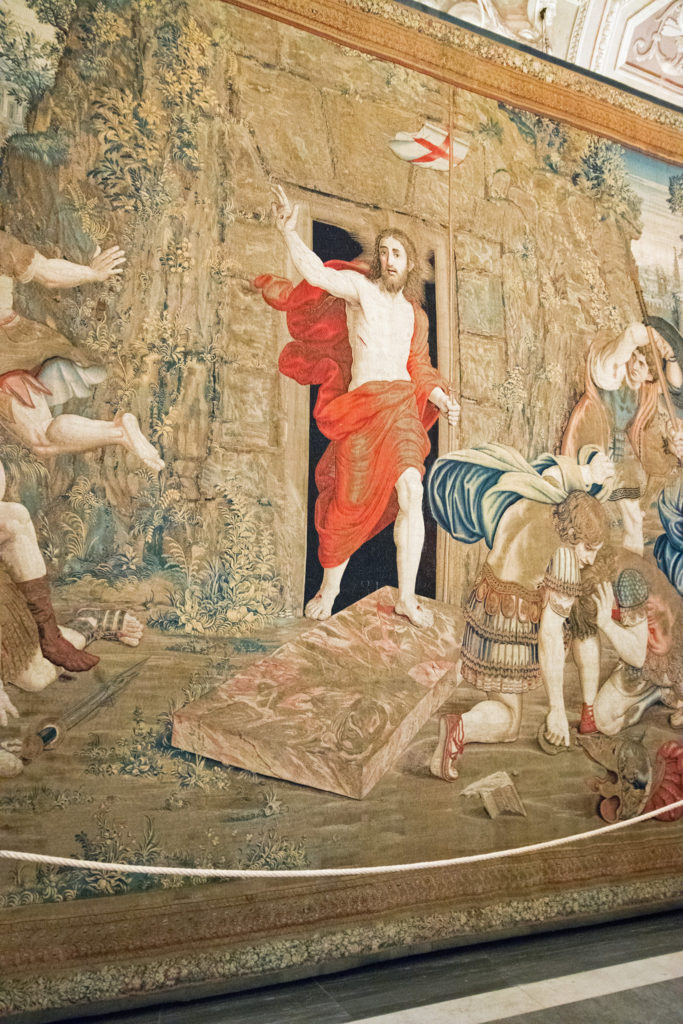
1. How To Get To The Vatican
The Vatican Museums can be accessed by foot, metro, or bus. You can literally just walk right in.
The metro stops are Ottaviano and Cipro. Or take bus #40 or 64.
If you arrive at St. Peter’s Basilica first, it’s a 15 minute walk to get the Vatican entrance.
You should definitely buy your Vatican ticket online . You can also book your ticket through the Vatican website in advance of your arrival, for an extra 4 euro charge.
If you don’t splurge for skip the line access, you could wait hours in line to get inside. There are even waits in low season.
Know in advance that there will be plenty of companies over-charging for tours, loitering just outside of the Vatican walls.
3. Photography
You can take photos (no flash) everywhere except the Sistine Chapel. Silence must be maintained in the Sistine Chapel.
You may want to read up on the paintings in advance. You guide won’t be able to tell you about them inside.
4. Dress Code
There’s also a strict dress code at the Vatican — no shorts, no hats, no cleavage, no bare shoulders. Be forewarned, if you’re there in the summer, there’s no air conditioning and it can feel suffocating.
Be sure to wear comfortable shoes. You could be there for hours.
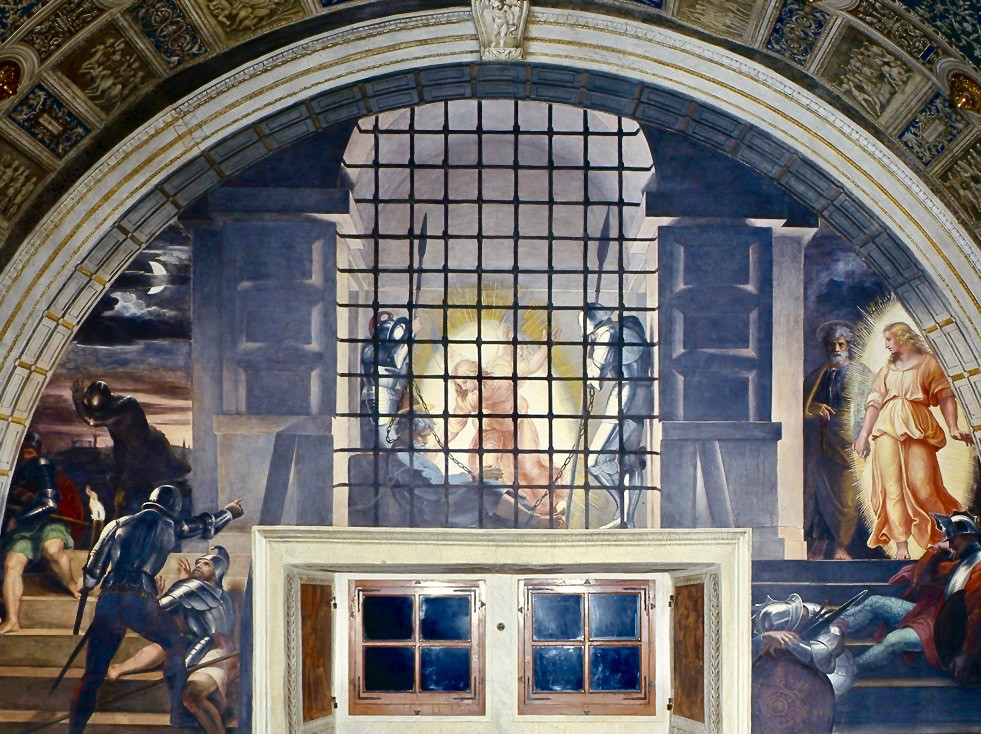
5. Other Tips
You can’t touch anything in the Vatican Museums. These are priceless relics and artworks. So resist the urge! If you don’t resist, you may be escorted out.
There aren’t many places to stop to rest in the Vatican Museums. In most galleries, seats are in short supply. If you need a break, head to the Pine Cone courtyard. There are also some benches in the Gallery of Maps and the Sistine Chapel.
I hope you’ve enjoyed my guide to the Vatican Museums. You may enjoy these other Rome travel guides and resources:
- 8 ways to spend 1 day in Rome
- 3 day itinerary for Rome
- 5 day itinerary for Rome
- Hidden gems in Rome
- Best museums in Rome
- Archaeological sites in Rome
- Guide to the Borghese Gallery
- Guide to Palatine Hill
- Guide to the Roman Forum
- Guide to the Colosseum
If you’d to see the must see masterpieces at the Vatican, pin it for later.
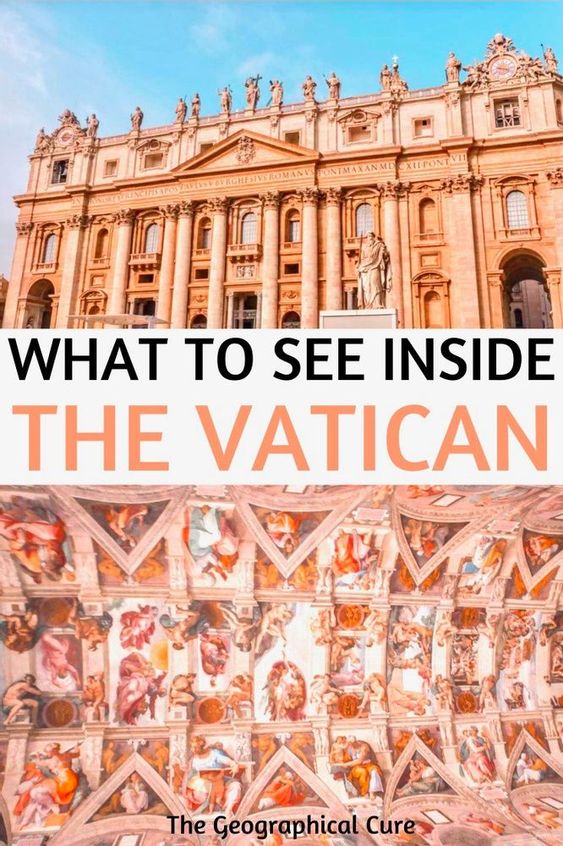
3 thoughts on “Ultimate Guide To The Vatican Museums: Masterpieces & Tips”
If we do a tour (we signed up for an early morning tour with breakfast) are we able to stay and look at any of the museums on our own or do most tours have you exit? Thanks for such helpful information.
Tours will take you into the Sistine Chapel and you cannot exit from there. You have to see the other museums before heading into the chapel. Your guides can’t offer you much by way of guidance in the chapel anyone because silence is the rule. So you could easily double back and see the other museums and do the chapel by yourself.
The only other caveat is that the guides usually take your from the chapel to St. Peter’s Basilica. So if you break off before the chapel, you won’t here what they have to say about the basilica.
Leave a Comment Cancel reply
Save my name, email, and website in this browser for the next time I comment.
Last Updated on December 21, 2023 by Leslie Livingston
- Tour Account ›
- Travel Forum ›
- Travel Forum
- Best Time to visi...
Best Time to visit: Vatican Museum, Sistine Chapel, and St. Peter's Basilica
I have only 2 full days in Rome at the end of August (Friday and Saturday).
Based on some blogs/review, sounds like Friday may be a better day to go at the end of August. Let me know if you agree?
What time in the day is best to visit these 3 places and the order of visiting? Is it better in the early morning or early afternoon? I plan to reserve the ticket in advance, but understand that Sistine Chapel may still be packed and line at St. Peter's may be long depending on timing. Any guidance here would be helpful. My 2 choices are:
- A: Early morning - See St. Peter's at open 7am or 7:30am, then go to Vatican Museum by 8:30/9am and head straight to Sistine Chapel. If I head straight to Sistine Chapel, can I back track to come back and visit the rest of the museum or I'm I force to exit after that.
- B: Early Afternoon - See Vatican Museum/Sistine Chapel at 2:30/3:00 pm PT, then see St. Peter's at 5:30/6pm PT.
Remember I'll reserve the ticket to Vatican Museum in advance. My family and I aren't that much into museum and seeing everything. We walk pass and skip through things, and after awhile we get tired of it, so we think 2-3 hrs at Vatican is more than enough.
Please let me know your thoughts.
Given the crowds and heat at that time of year, and your limited time, I would sign up for a tour like Pristine Sistine with Walks of Italy, or another good company. You start very early, get into the Vatican Museums and Sistine Chapel at 8 am before the general public, and have some much more sane, quiet and cooler time there, before the crowds and heat begin to fill the facilities after 9 am. Then you go directly into St. Peter's without having to walk back to the museum entry, then around to St. Peter's in the mid-day heat, and wait in line to enter. The guides are excellent. Yes, it costs more with this tour, and your need to get rolling very early, but the experience will be much nicer and more comfortable, and you will finish with the whole afternoon and evening in front if you. Walks of Italy offers an RS discount of 10% I believe, in addition to senior and youth discounts, if those apply to your family.
I would say very early or late in the day. But you will be surprised how much of a crowd there still is at that time of day, but much worse middle of the day. It may pay to join a tour group.
.......and, I'd suggest seeing St. Peters on the first day you have allocated for Rome. That way, if it is unexpectedly closed for a private mass, etc., you will still have the next day to try again. It took me three tries over two trips to finally get into St. Peters (due to private events that were happening when we visited).
Just a data point ... on Friday May 29 my grandson and I arrived in St. Peters Square at 8:15 am and stood in the security line for a little over half an hour to enter the basilica. The end of the line when we joined it was halfway around the circumference of the piazza. By the time we left the basilica at about 10 am the line was all the way around the piazza .
But it was worth it. :)
The other option - if interested in the more budget-friendly option- would be to purchase a morning tour of the Museums/Sistine/St Peters through the Vatican website itself. These also allow you to go directly into the basilica after the Sistine, although they doesn't include entry an hour before the public, like the WOI Pristine Sistine tour.
Cost is 37 euro for three hours, and wraps up in the basilica - where you can wander about on your own after the guide is finished.
http://www.museivaticani.va/3_EN/pages/z-Info/MV_Info_Servizi_Visite.html
If you book a tour of the Vatican Museums only and not Saint Peter's Basilica, you can stay in the museums after the tour is over. Even without a tour, you can stay in the museums after the Sistine Chapel. With a tour of the Museums and the Basilica, you can't go back to the museums without buying another ticket.
Thanks everyone. I am trying to do it myself without a tour. Somewhat on a budget.
So it sounds like at 2:30pm/3:00pm in the afternoon in late August, things will still be pretty packed inside the Vatican Museum? If so, I may be better off with my 7am St. Peter's plan and 9am Vatican Museum reservation.
If you use the tour exit from the Sistine Chapel you walk right into St. Peter's without having to wait on the line but you don't get to go back through the Vatican Museum. Get an early time, do the museum and then St. Peter's. The Sistine Chapel will probably be crowded whenever you go anyway so you might as well avoid the line at St. Peter's.
I would go to St. Peters early but you need more time till your reservation than you have allocated. You should build in at least a half hour security line wait, at least an hour in St.Peters and another half hour to walk to the Vatican Museums -- and add half an hour onto all that for the unexpected. If you arrive later than the crack of dawn then add yet another half hour for the St. Peters security line.
The Sistine Chapel is always crowded but it doesn't matter because what you want to see is straight up. If you hang by the benches eventually someone will getup and you can pop into their spot and lean back and look up. Unless you are with a tour don't count on the tour group door exit into St. Peters.
The Vatican Museum is open late on Friday nights, which was when we saw it a few weeks ago. Proved to be a great time to go -- crowds weren't an issue, we had time (and room) to soak in what we were seeing, and there was something magical about experiencing the Sistine Chapel and then stepping out into the night air. As a minor aside, there's a fantastic gelato place about two blocks from VM which buzzes with locals/energy late into Friday night. The combination of culture and fun made for a truly wonderful evening.
All, thanks so much for all response. A couple of follow up questions.
- Any view of how long lines at St. Peter's is at 5:30 pm? 2.Even with reservation, how long is Vatican security line in the early afternoon (2 or 2:30pm)?
If you use the tour exit from the Sistine Chapel you walk right into St. Peter's without having to wait on the line but you don't get to go back through the Vatican Museum. Get an early time, do the museum and then St. Peter's.
Just to clarify: this exit is reserved for tours. It has been reported that some independent tourists have managed to sneak through but the word lately is that the guards have become more observant, and are turning solo visitors away so there is no guarantee at all that you can go directly into the basilica. Plan on having to backtrack from the Sistine to the exit, and then around to the queue for the basilica.
We had good luck getting into the church pretty quickly by getting in line shortly before the doors opened in the morning but I won't swear that's always the case.
Check out the guest blog of Sara Murdoch - On Packing Light - in the September travel news. Her September 12 post Visiting the Vatican might be of some help.
We are planning to do a Walks of Italy tour "Vatican Highlights - Museum and Sistine Chapel" at 2pm. It states when complete, we would have no line access to St. Peter's if we wish. I checked Rick's map of St. Peters (the one used for his audio tour which we plan to use after the Sistine Chapel). Has anyone done this tour and use the access to St. Peter's? Reason I ask is the tour is 2 hr. 45 min. and Rick's audio tour of St. Peter's is about 45 minutes. According to the map, there is a WC area near the audioguides and baggage storage. Just in case we needed to find the WC, is there any way you can get there and back to St. Peters without having trouble with guards, etc? Just wondering if this is a possibility. I know this is a strange question! Thanks much.
Do all of your advise stay the same in terms of waiting time for end of October?
This topic has been automatically closed due to a period of inactivity.
- Where to Stay
- Where to Eat
- Best Time to Visit Rome
- Top 10 Tips for Rome
- Bathrooms in Rome
- What to Pack & What to Wear
Money Matters
Getting Around
Getting to Rome
- Learn Italian
- Can You Travel to Rome Right Now?
- Italy Green Pass - do you need one?
- Rome Coronavirus News & Updates
- Rome & Vatican Tours
- Italy Tours
- Transfers & Transport
- Sign up & get a FREE ebook Subscribe Today!
- Romewise Home Page
- Visiting the Vatican
- Vatican Museum Must Sees
Vatican Museum Must Sees - 10 stunning works not to miss!

By Elyssa Bernard
November 23, 2023
What are the top 10 Vatican Museum Must Sees?
With over 7 kilometers of art galleries , the Vatican Museums are among the largest in the world.
Find out what not to miss!
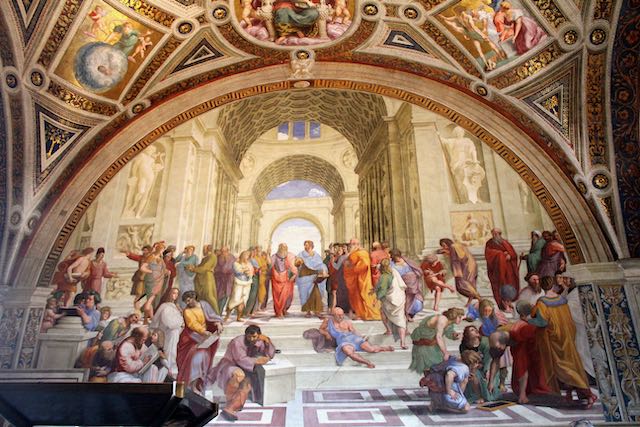
Why a Top 10 List of Vatican Museum Must Sees
There is so much to see in the Vatican Museums, if I listed it all the things I consider "must-see" here, this page would be way too long to follow (it's already pretty long, and I had to contain myself!)
And, frankly, as often as I have visited the Vatican museums, I always see something new.
Whether it's your first time visiting the Vatican Museums, or you have limited time and just want to make sure you see the highlights, there are some important works in the Vatican Museums you should not miss.
Some of these are things you will see no matter how you visit the museums .
For example, everyone ends up at the Sistine Chapel , so there is no chance of missing that.
But there are some other things you will have to make a decision to include.
And, some of the things on this list are entire rooms, so I'll let you know the most important thing(s) to see there.
In order of how you walk through the museums, these Vatican Museum Must Sees include, but are not limited to:
- The Spiral Staircase
Raphael's Transfiguration
- Pinecone Courtyard
- Apollo Belvedere
- The Rotunda Room and Porphyry Basin
- The Tapestries Hall
- The Maps Room
- Raphael's School of Athens
- The Sistine Chapel
Of course, my list is subjective .
The beauty of art is in the eye of the beholder.
There are pieces I love that I've left off this list, but the idea is to give you some of the most important, and most iconic things to see in the Vatican Museums .
Disclosure : If you make a purchase through a link on this page, I may receive a small commission - at no extra cost to you. Thank you for supporting my site!
Vatican Museum Must Sees - The Spiral Staircase
There is a very special staircase you cannot normally visit in the Vatican museums , designed by Bramante.
And in 1932, architect Giuseppe Momo designed another one, which was inspired by the original Bramante Staircase.
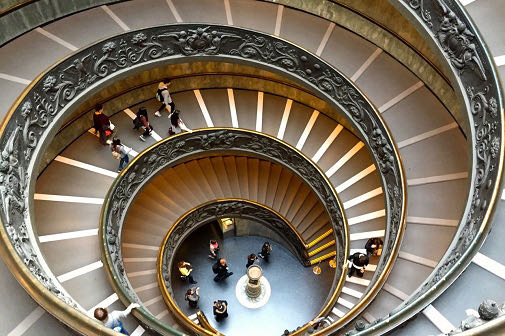
His staircase, like Bramante's, is a double helix (like DNA).
It is composed of two staircases which theoretically allow people to go up and down without crossing each other.
I say theoretically because this staircase is now intended ONLY as the exit from The Vatican Museums.
If you are visiting the Vatican museums with a tour that includes Saint Peter's Basilica , you will not exit the museums via this staircase, as you go from the Sistine Chapel directly into St. Peter's Basilica .
Depending on the tour company, the guide might show you this staircase at the very beginning of the tour so you don't miss it.
You might consider asking the guide to show it to you.
If you visit the museums on your own , and for whatever reason do not want to or cannot visit Saint Peter's Basilica using the shortcut (which is only possible with a booked tour of the museum that ends in Saint Peter's basilica) from the Sistine Chapel, you will take the exit from the Sistine Chapel that takes you back out to the entrance of the Vatican Museums.
In this case, you will visit this staircase on your way out.
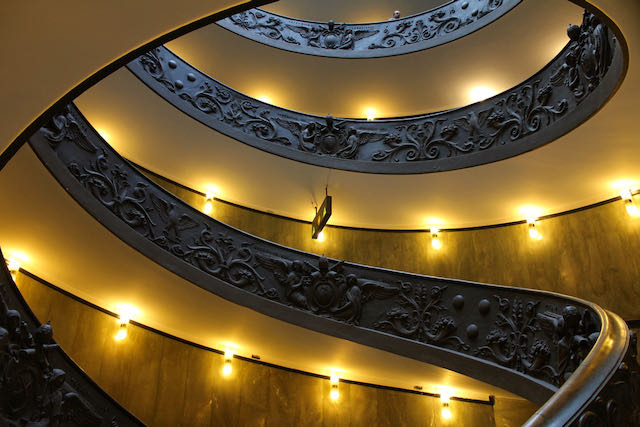
Why this is in my list of Vatican Museum Must Sees : I don't think this was the intention when it was created, but it has become one of the most photographed things in the Vatican museums .
If you want to see the original Bramante staircase , you can book a special tour that includes this staircase , plus other things in the Vatican Museums not normally open to the public .
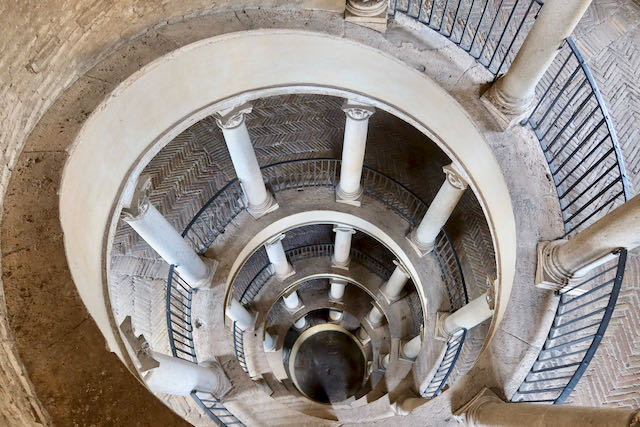
Vatican Museum Must Sees - The Pinacoteca
The Vatican Pinacoteca is the paintings gallery of the Vatican Museums.
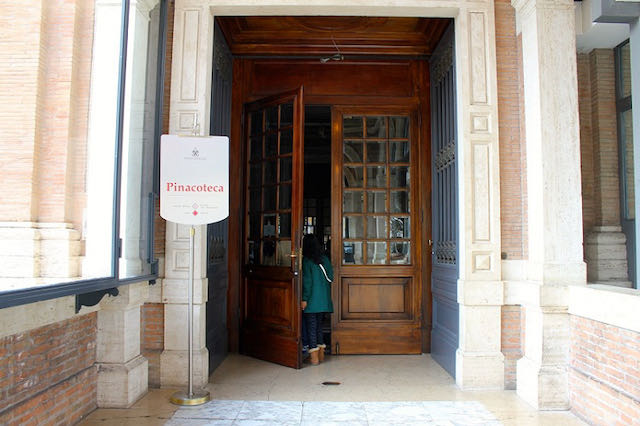
It is often overlooked and under-visited.
To me this is a shame, because there are several masterpieces in there.
The Pinacoteca is one of the latest additions to the Vatican Museums , completed in 1931.
There are mostly paintings but also a few other works like tapestries, icons and sculptures.
The works are from the Middle Ages through the 1800's and are in chronological order, covering 18 rooms.
To visit the Pinacoteca, either book a tour that includes this , or, if going on your own , visit this first.
Once you come up the big escalators at the entry and into the museums, the Pinacoteca will be on your right.
There are so many works by artists I love, including Caravaggio's Deposition , but the jewel in the crown so to speak, is Raphael's last work right before he died: the Transfiguration .
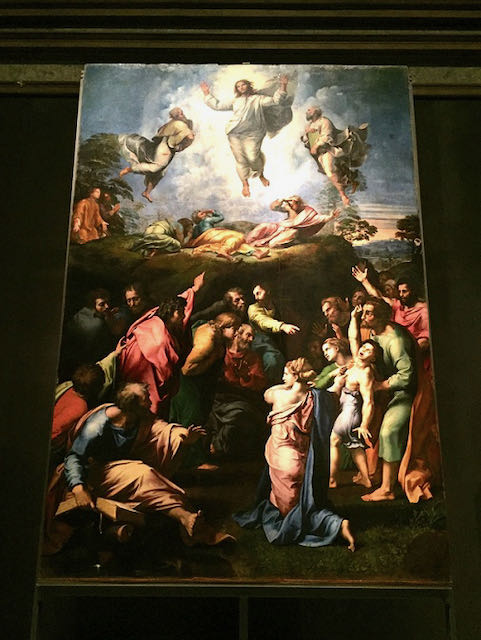
The Transfiguration relates to stories of the Gospel of Matthew, and depicts the dual human and divine nature of Jesus Christ.
The top half is painted in light colors and shows Jesus flanked by the prophets Elijah and Moses.
He seems to be the only serene one in the painting.
The bottom half is dark, because it's an earthly painting with a human, dark scene.
On the right side we see a boy who is apparently possessed (he has epilepsy.)
His parents are anguished, and the apostles are shown with a look of wonder on their faces, as they realize that Jesus Christ not only lives on, but that faith can cure the sick boy.
Their outstretched arms link the bottom with the top of the painting.
It was commissioned by Cardinal Giulio de' Medici , who was to become Pope Clement VII.
Raphael had not quite finished it when he died prematurely in 1520 (that is another story.)
The painting was originally meant to be an altarpiece for a church in France, but the pope decided to keep it in Rome.
Later, it did make its way to France when Napoleon got his hands on it for a while.
But the painting finally wound up in the Pinacoteca of the Vatican Museums.
Lucky for us!
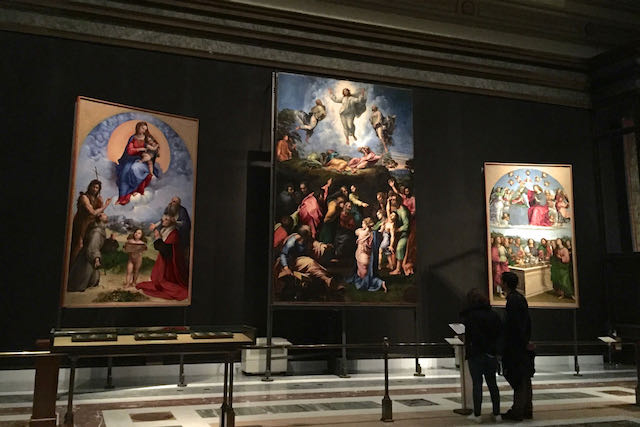
Why is this painting so significant and why is it on my list of Vatican Museum Must Sees ?
The Transfiguration is seen as the bridge between what is called "High Renaissance" painting (early 1500's), and "Baroque style" painting (early 1600's.)
Raphael used chiaroscuro ("light on dark", a technique made even more famous by Caravaggio), to highlight the darkness of the sick boy on earth (at the bottom of the painting), and the lightness of Jesus's body in heaven (at the top of the painting).
And unlike so many of Raphael's previous paintings, including in the Raphael rooms in the Vatican Museums, the figures in this painting portray extreme and very human emotions: awe, disbelief, anguish.
This painting inspired Michelangelo's "The Last Judgement", on the wall of the Sistine Chapel.
So the painting is not only amazing to look at, but it's a very important piece as far as art history and art appreciation go.
(If you'd like to read a more detailed analysis of this painting, visit the Encyclopedia of Art website.)
I can spend at least an hour wandering the rooms of the Pinacoteca.
But if you want to just go through to the room (room VIII) with the Transfiguration, you can do so easily, and get back out, in less than 20 minutes .
You can also see it while on a guided tour through the Vatican Museums
Vatican Museum Must Sees - The Pinecone Courtyard
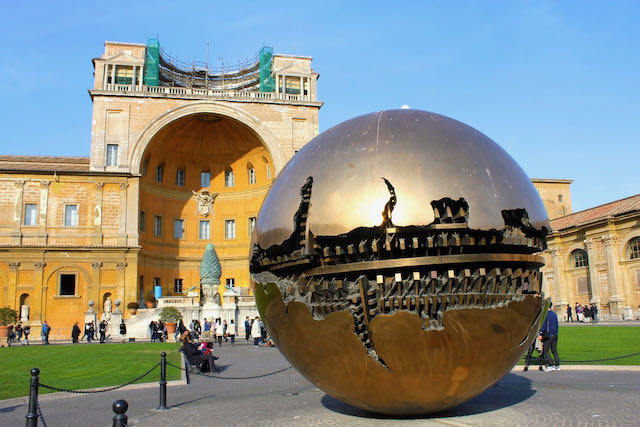
The Pinecone Courtyard , or Cortile della Pigna , is named for the nearly 13-foot high pinecone sitting at one end.
The giant pinecone is made of bronze and dates to the 1st century BCE.
It was originally found in the Campus Martius ( Campo Marzio ) area of Rome, which is near the Pantheon .
The two bronze peacocks on either side of the pine cone are copies of ancient sculptures that flanked an entrance to Hadrian's Mausoleum (today Castel Sant'Angelo .)
The originals can be seen in the Braccio Nuovo wing of the Vatican Museums.
The Pinecone Courtyard is part of what was once a much longer space, designed in 1506 by Donato Bramante (the first guy to design the cuppola of Saint Peter's Basilica , before Michelangelo finished the job. He also built that staircase I told you about above.)
That courtyard, called the Belvedere Courtyard , was meant to link the Vatican Palace (where the pope lived) with the Villa Belvedere (a sort of pleasure resort with a nice view of Rome, hence its name "Belvedere.")
Today the Villa Belvedere has been turned into part of the Vatican Museums.
The Belvedere Courtyard was a first in its design and became the inspiration for courtyard design around the world for centuries to come.
Later, a library was built across the middle of it, making this courtyard smaller (the one you see today.)
Neither the library nor the other half of the courtyard are open to visitors.
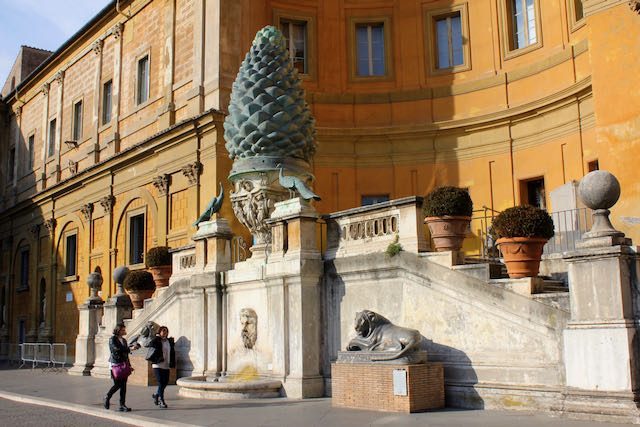
So what about that pinecone ?
It was found near the Pantheon around the Baths of Agrippa (the guy who first built the Pantheon, and who was also Emperor Augustus ' right-hand man.)
The pinecone was once a giant fountain, with water coming out of the top and scales and running down the sides.
Can you just imagine how lovely that must have been?
Since these were pre-Christian times, the pinecone was (probably) part of a pagan temple, dedicated to Isis.
In mystic or occult circles, the pine cone also represents the pineal gland , which is responsible for our perception of light.
The pineal gland (and so the pine cone), are symbols of the "third eye", which is the so-called “ Epicenter of Enlightenment ."
I do not mean to go off on an existential tangent here, but I do think that having a symbol like this, flanked by two peacocks, in the middle of the Vatican Museums, is an interesting juxtaposition.
For a very special treat, you can book this early-morning tour of the Vatican Museums and Sistine Chapel , that starts with breakfast right in the Pinecone courtyard!
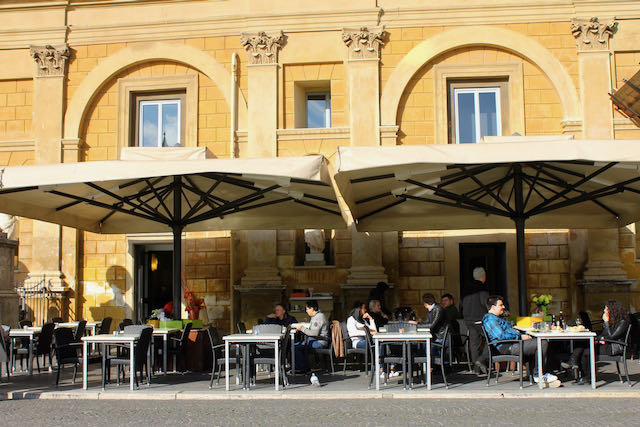
Why is the Pinecone courtyard on my list of Vatican Museum Must Sees ?
First of all, I think the pinecone in itself is fascinating, since it is from ancient Rome, but also has hidden meaning.
Second, because, like the spiral staircase, the strange modern art globe in the center is another of the most photographed things in the Vatican Museums (despite it being pooh-poohed for being...too modern? too weird? And yet, people seem to love it!)
Third, because it does give you what I think is a needed moment of fresh air and open space to rest, gather your thoughts and impressions, and re-group for the rest of the museums.
It's hard to miss seeing this courtyard but I suppose you could you if you were on a fast-track to the Sistine Chapel.
To see it, stop by after visiting the Pinacoteca.
The visit could take you anywhere from 10 minutes and up, depending on how much time you spend resting, taking pix or even grabbing a bite at the cafe there.
Brief History of Vatican City eBook
The history of the Vatican stretches back thousands of years, and to know everything about this incredible micro-state would take a lifetime to learn.
With this eBook, discover the brief history of Vatican City - where it got its name, who built the basilica, where the Popes are buried and more!
Topics covered include:
- Details about the Vatican's origin , going back to the time of Ancient Rome
- The role important artists such as Michelangelo played in the creation of the Vatican as we know it today
- How the Vatican came to be an independent city state within the boundaries of Rome
What else is included in this Brief History of Vatican City e-book?
- 50+ pages of information covering all areas of the Vatican's history
- Dozens of stunning and original photos showcasing the Vatican
- Insightful diagrams and drawings to help illustrate the more detailed elements of the Vatican's history
- + much more!
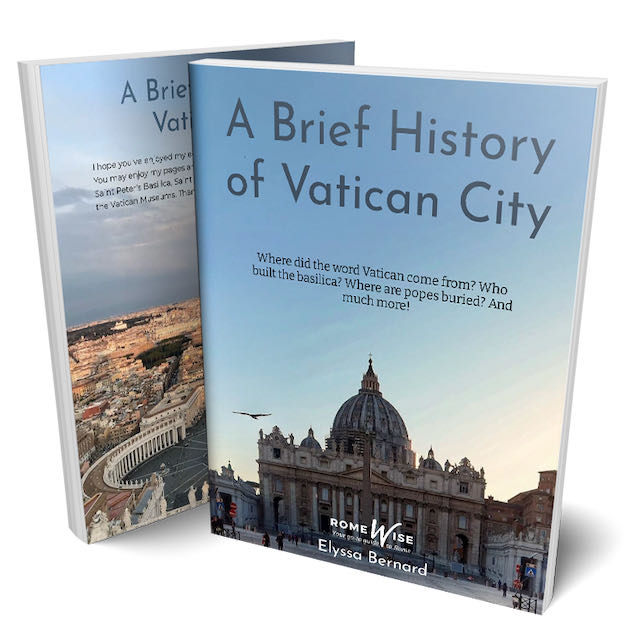
Look inside:
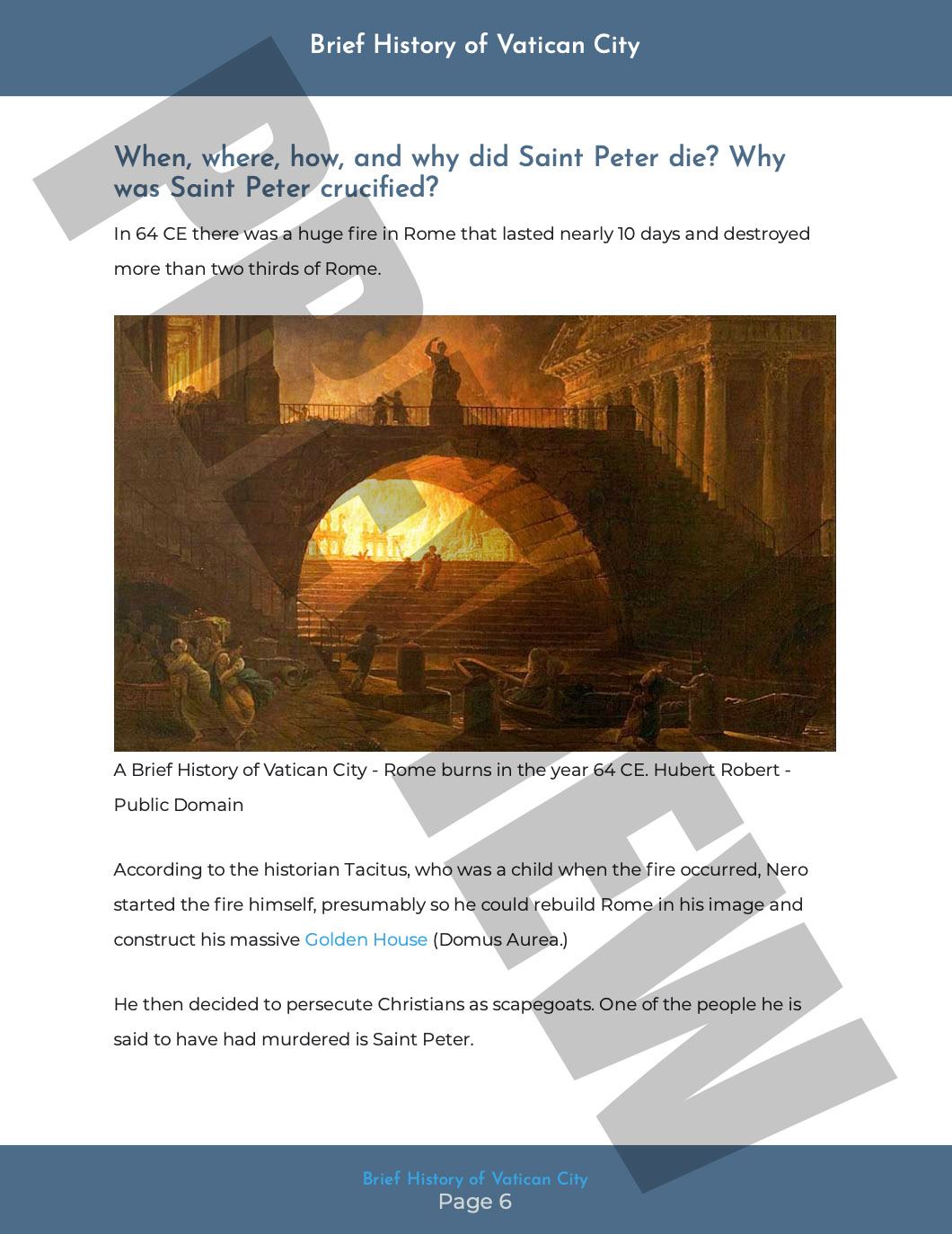
Only $8.99!
🤙 Roaming in Rome? 📱
Get yourself an Italian eSIM for calls, messages and data when traveling here.
Save on data charges with plans from just 19€ from Holafly - our recommended eSIM provider!
Click here to get yours now and use code ROMEWISE to save 5%!
Vatican Museum Must Sees - The Pio-Clementine Museums
The Pio-Clementine museum houses some of the best examples of ancient Greek and Roman sculptures found anywhere in the world.
The museum is named for the two popes who oversaw its foundation in the late 1700's: Clement XIV and Pius VI.
This museum is pretty large and houses many different rooms, each fascinating and chock full of things to see in its own right.
It's easy to skip this museum if you are on a fast-track to the Sistine Chapel, so if you want to see these Vatican Museum must sees, you will need to make a decision to include this museum.
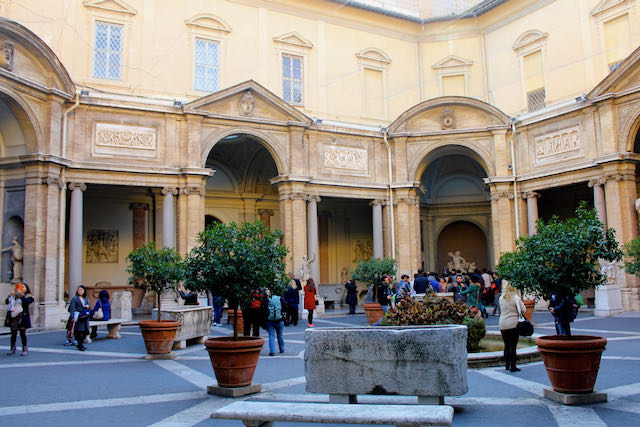
As you start making your way through the Pio-Clementine museums, you will come upon an open-air courtyard, called the Octagonal Courtyard (for its shape).
It would be easy to simply walk through it to the other side and keep going.
By this time, you will have already come across lots of sculptures.
I know how one can get overwhelmed by all these ancient Greek and Roman statues ... and start getting sculpture fatigue.
But while to me it is worth really soaking up all the art in here, there are at least two Vatican Museum Must Sees right in this courtyard .
The perfect 3-day itinerary in Rome
Trying to figure out how to organize your visit to Rome? I've got the perfect 3-day itinerary for first-time visitors (or those who have not been here in a while.) It works for a 2.5 day visit as well.
In my 3-day itinerary, you'll see all the major must-see Rome attractions like the Vatican , Colosseum , Trevi Fountain , Pantheon , Piazza Navona , Spanish Steps , Castel Sant'Angelo , and much more.
And if you have more time, or want suggestions for extra/other things to do, you'll find that there too.
Visit my page with the best 3-day itinerary in Rome for first-timers .
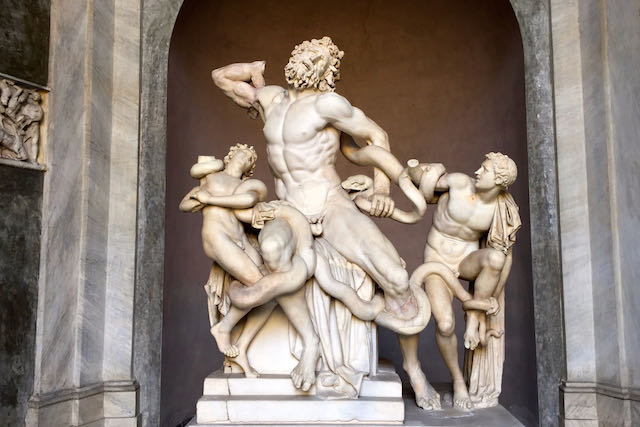
The Laocoön is a sculpture group, found in 1506 on the Esquiline Hill in Rome.
The sculpture, from around 30 BCE, depicts the Trojan priest Laocoön and his two sons losing a battle to the death with two sea serpents.
Pliny the Elder had described a statue just like this, as being a masterpiece made by three sculptors from Rhodes, and residing in the palace of the Roman Emperor Titus (part of the Flavian Dynasty, who built the Colosseum .)
It's pretty well accepted that this is the statue Pliny was referring to, although this statue may have been a copy from a 2nd century BCE original.
The Laocoön sculpture depicts a moment from Virgil's Aeneid , which recounts the Trojan War.
You may remember a scene in which the Greeks leave a giant wooden horse outside the gates of Troy.
The Trojans naïvely bring in the horse, and subsequently the Greeks who'd been hiding in the horse jump out and destroy Troy.
Laocoön, a Trojan priest , had warned the Trojans not to bring in the horse.
The gods Athena and Poseidon, who sided of course with the Greeks, sent two sea serpents to kill the priest.
Aeneas heeded the priest's warning and fled Troy, bound for Italian shores.
And for Romans, this is a big deal , since Aeneas was one of the forefathers of Romulus and Remus, the legendary founders of Rome.
Why is the Laocoön sculpture on my list of top 10 Vatican Museum Must Sees ?
First of all, as I said, the story itself is important to the founding legend of Rome.
And, second of all, this sculpture is pretty special, considering that it depicts real human agony, with dignity, and without any redemptive qualities that later Christian art shows of saints and martyrs.
It is considered by many to be one of the highest-quality sculptures in the world.
You can visit the sculpture with a guide as well - it's included in walking tours, such as this one .
Do you really need to visit the Vatican and Colosseum on the same day?
Find out how here!
Vatican Museum Must Sees - Apollo del Belvedere
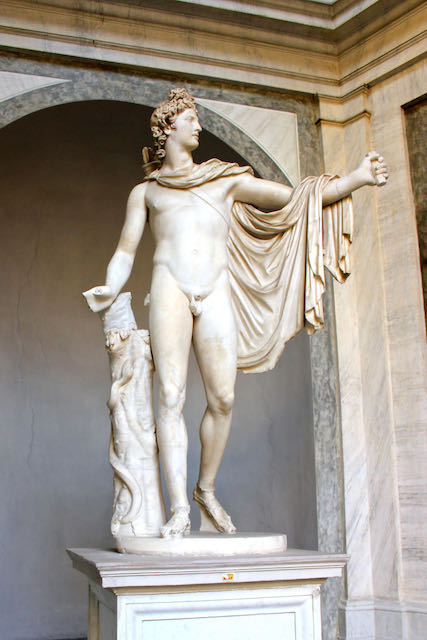
The Apollo Belvedere is a marble Greek sculpture from around the 1st century BCE (although it was probably a Roman copy of an earlier bronze statue made by the Greek sculptor Leochares.)
It was once considered one of the greatest ancient sculptures ever made.
The statue was found in the 15th century, and belonged to Cardinal Giuliano della Rovere.
Once he was elected as Pope Julius II , he had the statue moved to the Vatican, into the Belvedere Courtyard (hence its nickname.)
It was the first piece in the art collection of the Vatican , before there were Vatican Museums.
The sculpture portrays the god Apollo, (who existed in both Greek and Roman mythology), as an archer who just shot an arrow.
His face is serene, and even the relaxed body portrays a god who is at ease, and unchallenged by the effort of shooting his arrow.
The sculpture shows the "ideal" male body, without a single flaw.
In the 18th century, the height of neo-classicism, the German art historian Johann Joachim Winckelmann said, "of all the works of antiquity that have escaped destruction, the statue of Apollo represents the highest ideal of art."
During the Romantic movement, around the late 1800's, the Apollo Belvedere started to lose its appeal and today is no longer considered the height of artistic beauty.
So why is the Apollo Belvedere in my list of Vatican Museum Must Sees ?
First, because it was once considered to be the ideal of classical male beauty.
Second, because this is the piece that began the entire collection in the Vatican Museums.
Third, it was said to be Napolean's favorite piece of art that he took from the Vatican to the Louvre (of course after Napolean's fall, this statue and most of the rest of the art he took was returned to Rome and in this case, to the Vatican.)
If you do take the time to visit the Pio-Clementine museum, and want to see some more special exhibits, you can add in the Gregorian Egyptian museum , with its superb collection of papyri , mummies and ancient statues .
One floor up from this is the Gregorian Etruscan museum , with extraordinary examples of Etruscan relics, including a life-sized Etruscan tomb that you can walk into and enjoy a well-done video and light-show presentation.
And these museums are almost always empty so it's a moment of respite and calm from the otherwise frenetic and crowded Vatican Museums.
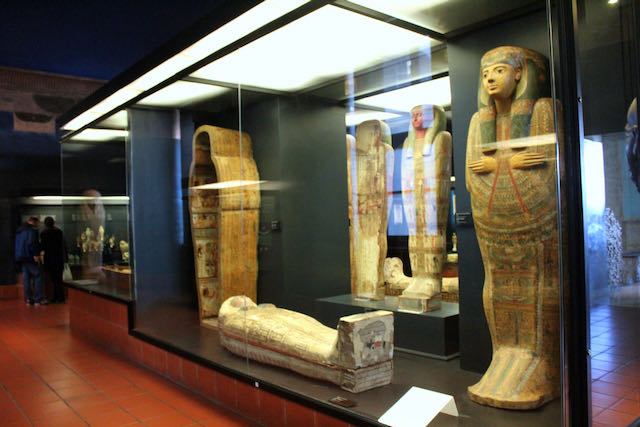
Vatican Museum Must Sees - Rotunda Room and Porphyry Basin
The Sala Rotonda , or Rotunda Room , of the Vatican Museums has a lot going for it.
First of all, it is modelled after the Pantheon , right down to oculus in the ceiling, and to the decorative rosettes in each of the little niches in the dome.
It is smaller in scale than the pantheon but still impressive.
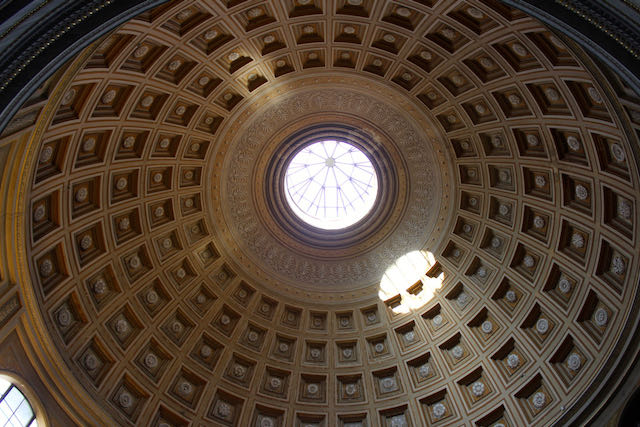
Second, the floor is also not to be missed.
It is made up of tiny, intricately designed mosaics from around the 2nd century and is simply stunning.
These mosaics used to decorate an ancient Roman villa and are incredibly intact and colorful.
There are other ancient black and white mosaics in the room that you can even walk on ... something I find shocking, but you can!

Third, but definitely not least, is the giant (about 40-feet in diameter) porphyry basin in the center of the room.
What is porphyry?
There are two answers to this: The first answer is that it is a type of igneous rock (which means it was created from cooled lava), that is full of large pieces of crystal.
The rock is extremely hard, and difficult to cut.
And unbelievable heavy.
So imagine about 2000 years ago, the emperor Nero ordering a bath for his Domus Aurea (Golden House), and having someone get this giant rock out of Egypt (there is one quarry in Ancient Egypt where all the porphyry rock came from) ... and then carve it into a single piece like this and get it to Rome?
The second answer as to what is porphyry is that it is a color.
The word comes from the Greek word for purple , and in ancient Rome, purple was for royalty.
This particular basin is a reddish purple.
Basically, when you see porphyry marble around Rome, just know it was hauled over here from Egypt, and it must have been for a pretty special person.
So do I need to tell you why this room and the basin are in my Top 10 List of Vatican Museum Must Sees ?
The shape of the room, the exquisite, detailed mosaics on the floor, and this giant, amazing porphyry bathtub.
It's truly awesome in every sense of the word.
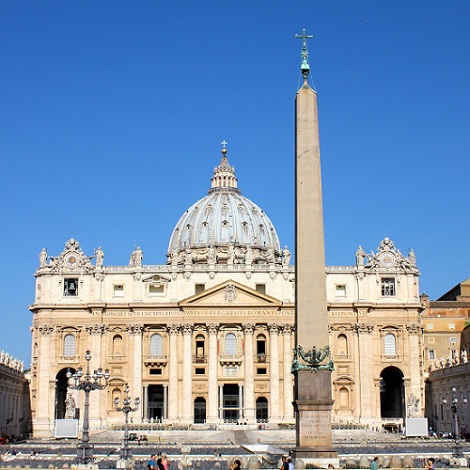
NEW FOR 2024!
The archeological area of the Vatican Necropolis of Via Triumphalis is now open for visitors.
This is an ancient Roman burial site that is within the Vatican walls and before now was very difficult to get access to.
You can only enter as part of an official Vatican tour group, and tickets need to be purchased through the official website .
This is an entirely separate visit, so you will not have access to either St Peter's Basilica or the Vatican Museums.
Click here to watch my YouTube video about it and see what it's like!
Vatican Museum Must Sees - The Tapestries Hall
It's impossible to miss a visit to the Galleria degli Arazzi , or the Tapestry Hall, as you literally have to walk through it to get to the Sistine Chapel.
But it could be easy to breeze past these special works of art, and not really know what exactly you should look at.
Most tours cover at least some of the tapestries room, but in case you are on your own, take some time to notice these things:
First of all, look up.
The ceiling looks like a plaster 3-dimensional design.
It's actually painted!
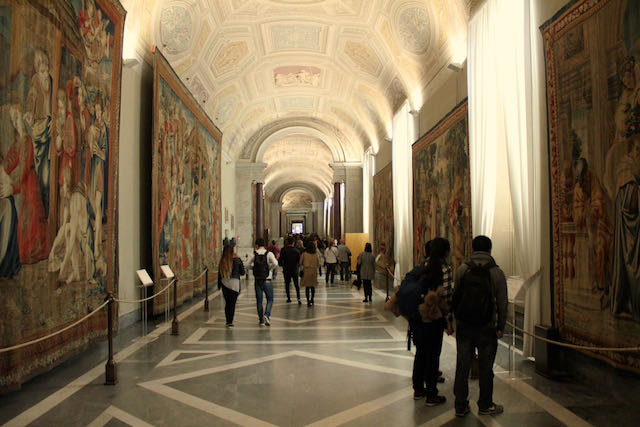
As for the tapestries, they are from two different periods and regions.
The ones on the right were made in the 17th century in Rome for Pope Urban VIII (Barberini), depicting scenes from his life.
These are nice but the most amazing tapestries are along the left wall.
Here you have tapestries woven in Brussels by Pieter van Aelst’s School, from the 1500's .
They made the tapestries based on drawings by Raphael’s pupils , during the pontificate of Clement VII.
These tapestries depict the life of Jesus.
Each tapestry took years to make .
They were finely woven by the best weavers of the day (who were in Flanders, or Belgium), out of wool but also silk, and gold and silver thread .
Notice in particular the tapestry of The Resurrection of Christ (below).
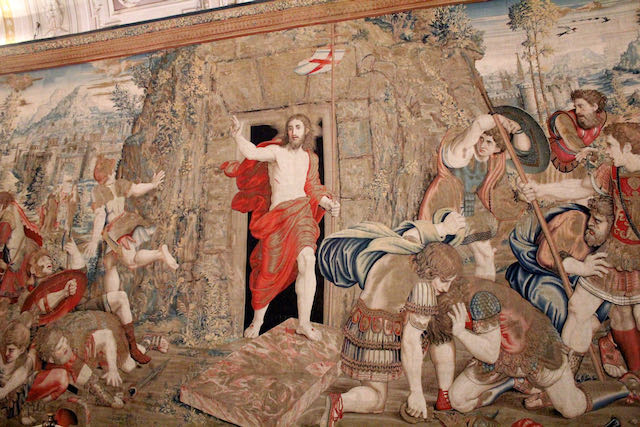
My photo cannot do this tapestry justice.
You have to really look closely to see how amazing this weaving is.
Notice all the shading and even how the weavers were able to depict human emotion...using thread!
But the most amazing part of this particular tapestry ?
As you approach it from the left, keep your eyes on Jesus's eyes ... keep walking and watch his eyes.
By the time you pass the tapestry, the eyes are still with you!
It's a wonderful example of " moving perspective ", a technique you find sometimes in paintings (like the Mona Lisa.)
But to do this with a tapestry takes a lot more mastery and talent, and requires some very fancy stitching indeed!
Why is the Tapestry Gallery in my Top Ten list of Vatican Museum Must Sees ?
Because even though you will visit it anyway, you should pay attention to some of the detail in here, on the ceiling and on these amazing tapestries, in particular the Resurrection tapestry .
Besides the fact that I always love seeing people's faces when they realize the eyes have followed them, I think this level of work and craftsmanship deserves some attention.
Skip the long lines for the Vatican Museums, including the Tapestry Hall
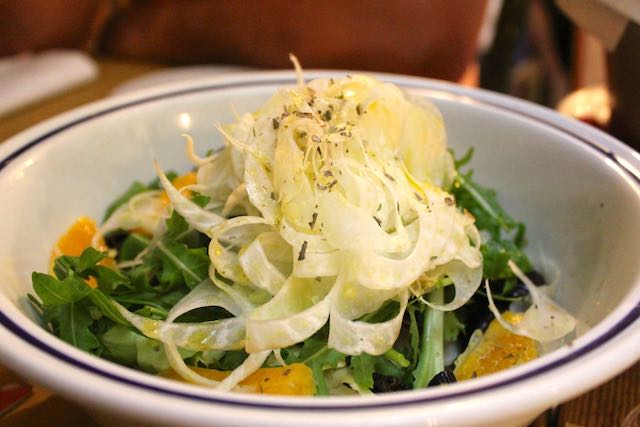
Vatican Museum Must Sees - The Maps Hall
After you go through the Tapestries Gallery, you will inevitably pass through the Galleria delle Carte Geografiche (Maps Gallery).
As with the Tapestries Hall, it would be easy to just coast through here, beelining for the Sistine Chapel.
In the case of the Maps Gallery , it's pretty hard not to notice the ceiling, a must-see all by itself (and one of the most photographed ceilings in the museums besides Michelangelo's Sistine Chapel !)
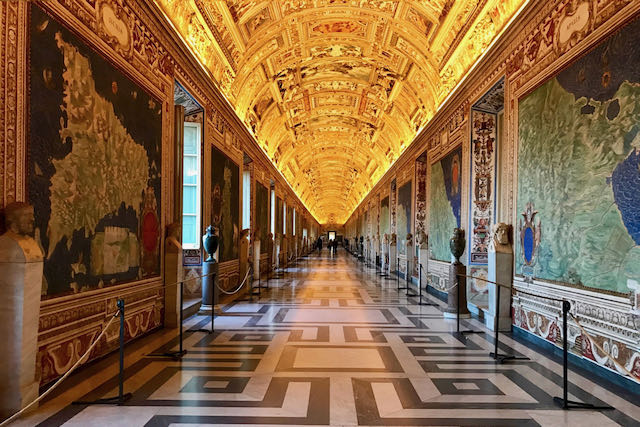
The Gallery of Maps contains the largest collection of geographical paintings ever created .
These wall-sized maps depict Italy and Italian provinces, and were commissioned by Pope Gregory XIII in the 16th century.
These maps, based on drawings by the Dominican Monk Ignazio Danti, are amazingly accurate for being made in the 1500's !
The maps are really well-detailed, showing mountain ranges and even boats in the water, but they are also somewhat whimsical, containing fantastic sea creatures and even Neptune, the Roman god of the sea.
Why is the Maps Room on my Top Ten List of Vatican Museum Must Sees ?
As with the Tapestries Gallery, it's too easy to walk through here without really looking at the art.
But the maps are really genius, and even fun to look at.
See if you can find the depictions of Neptune in some of the maps!
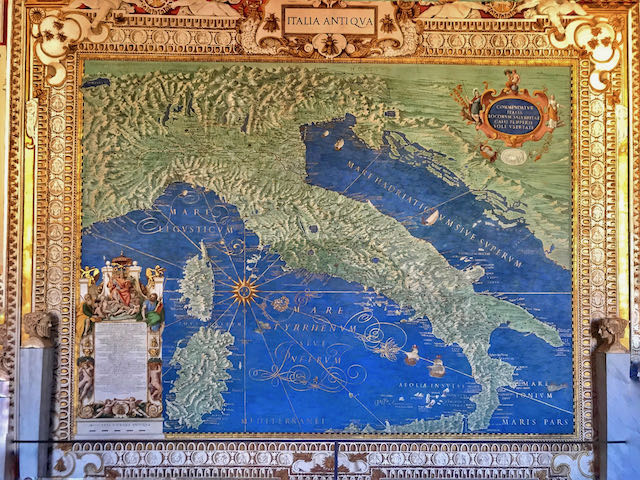
So, exactly what is the Vatican?
Find out here!
Vatican Museum Must Sees - The Papal Apartments
At one time, popes lived inside what is now the Vatican Museums.
This collection of residences is generally called "The Papal Apartments" (and does not have anything to do with where the current pope resides!)
The two most spectacular of these are the Borgia apartments and the Raphael rooms .
These are easily missed/skipped if you want to shortcut to the Sistine Chapel.
But as this page is about what I consider Vatican Museum Must Sees, I am telling you not to miss them!

The Borgia apartments , frescoed by Pinturicchio , a contemporary of Raphael, actually come after the Raphael rooms.
I just wanted to show you what else you would get to see if you include the Raphael Rooms.
It's all wonderful and a feast for the eyes!
Vatican Museum Must Sees - Raphael Rooms and Raphael's School of Athens
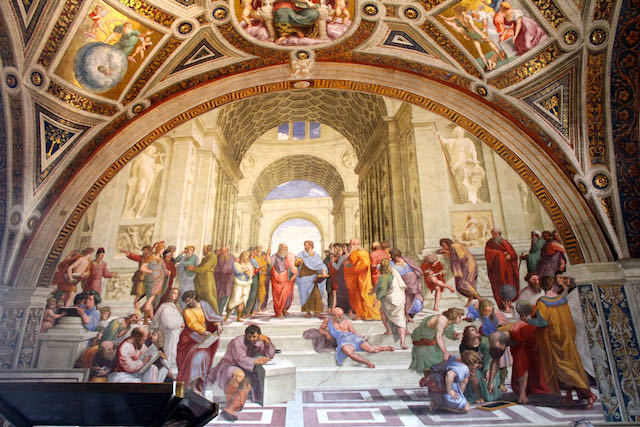
While there is a lot to see in the Papal Apartments, we are focusing this page on Vatican Museum Must Sees.
So let's talk about The School of Athens by Raphael .
I think this painting actually makes the top ten list for a lot of people!
It's one of the most famous paintings in the Vatican Museums besides Michelangelo's paintings in the Sistine Chapel .
Renaissance Popes Julius II and Leo X had the best artists of the day decorate their sumptuous homes.
And that meant hiring Raphael.
In 1508 Pope Julius II hired Raphael to paint a room called the Stanza della Segnatura.
This was right after he commissioned Michelangelo to paint the ceiling of the Sistine Chapel!
Can you imagine living in the time and just being able to hire these guys?
In the Stanza della Segnatura, there are actually four paintings by Raphael, one on each wall.
They represent the themes: Theology, Poetry, Philosophy, and Justice.
So enjoy all the Raphael paintings in these rooms but in particular, stop and take note of the School of Athens (philosophy.)
The painting is a fantasy gathering of the greatest philosophers , mathematicians and thinkers from classical antiquity.
They are all together in this one painting even though they came from different places and different moments in time.
That's already whimsical in itself.
But what Raphael did was even more fun.
He put the faces of his contemporaries in there.
Plato , in the center talking to Aristotle , has Leonardo Da Vinci 's face.
Another Renaissance master, Donato Bramante (who designed the Belvedere Courtyard we talked about above, and was the first one to design the dome for St. Peter's Basilica ), appears on Euclid's body (he's the one drawing on a chalkboard.)
Raphael himself is also in there, on the bottom right corner, looking out at us.
And, while Raphael was painting this extraordinary masterpiece, he popped into the Sistine Chapel and saw what Michelangelo was doing ... and put Michelangelo front and center of The School of Athens, in the form of the Greek philosopher Heracleitus (he is the one resting his head on his arm, and with boots on, sitting on the steps.)
What is so special about Raphael's School of Athens and why is it in my Top Ten List of Vatican Museum Must Sees ?
Many art historians and experts consider Raphael's School of Athens one of the greatest paintings of the High Renaissance.
His use of the Renaissance color palette, and mix of ancient and contemporary Roman architectural elements to create unity in the painting, and the theme itself (a coming together of earthly and godly elements), all turn this painting into one of the greatest masterpieces of the Renaissance .
Ready to plan your trip?
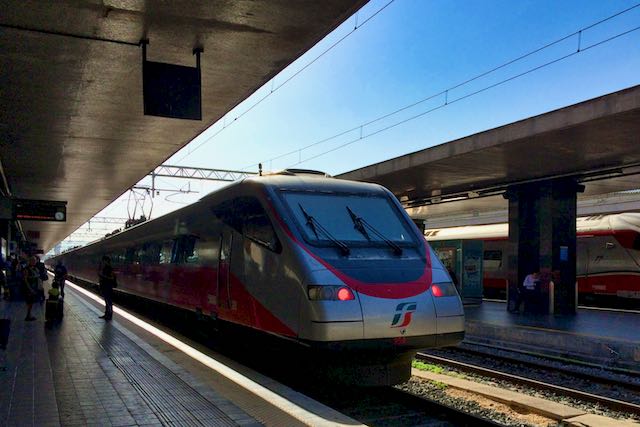
Vatican Museum Must Sees - The Sistine Chapel
VESPERS INSIDE THE SISTINE CHAPEL
I once had the amazing privilege of attending Vespers inside the Sistine Chapel.
Take a look:

And of course, no visit to the Vatican Museums would be complete without the Sistine Chapel .
In fact, it's usually the only reason people come to the Vatican Museums.
And since it is at the very end of the museums, you won't miss it.
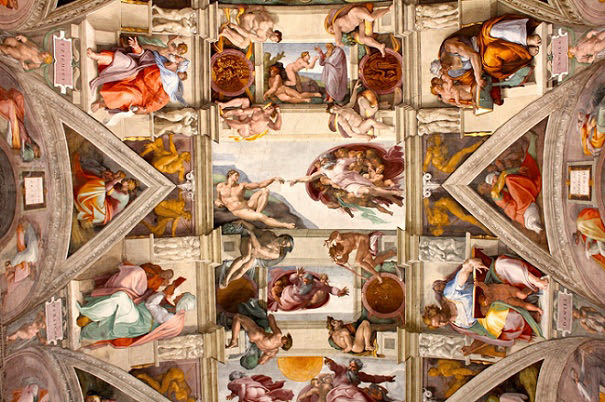
When you have a tour of the Vatican Museums , they will give you an explanation of the chapel before you go in, since you are supposed to be quiet in there.
If you go in on your own, here is what to look for once you are inside the Sistine Chapel:
Vatican Museum Must Sees - The Creation of Adam by Michelangelo
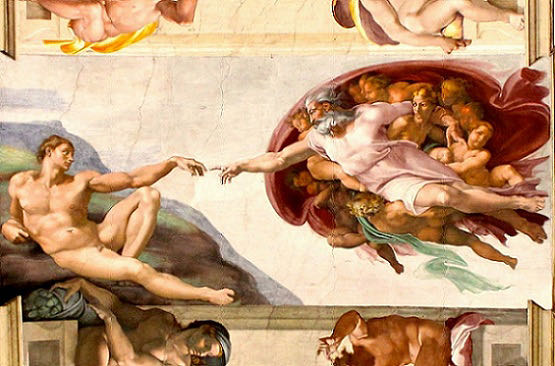
I think the most famous part of the Sistine Chapel is the series of paintings by Michelangelo on the ceiling .
These are 9 scenes from the book of Genesis.
And the most famous painting in this series, perhaps one of the most iconic paintings in the world , is the Creation of Adam .
But take the time to look at the rest of the panels on the ceiling too.
Michelangelo and the Pope's Ceiling
by Ross King
I LOVE this book, and cannot recommend it highly enough.
If you want to know all about Michelangelo and how he came to paint the ceiling of the Sistine Chapel, I suggest you get this book.
I found myself surprised to find it was a page-turner that I could not put down!
Vatican Museum Must Sees - Michelangelo's Last Judgement
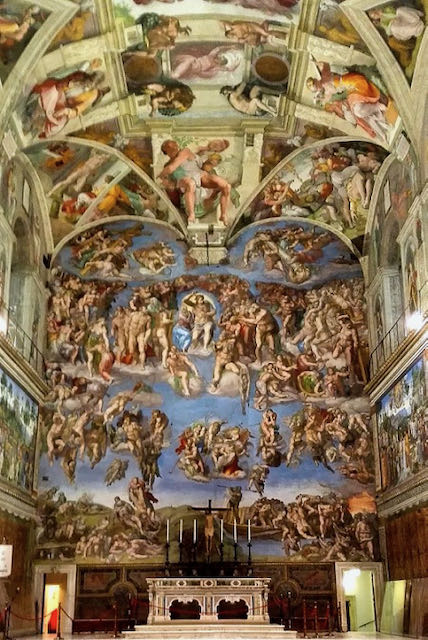
Every time I visit the Sistine Chapel, I notice everyone looking straight up.
Yes, the star attraction is Michelangelo's ceiling , in particular, the Creation of Adam.
And with good reason.
It's spectacular.
And one of the world's most famous pieces of art.
So get a good look and enjoy.
But also, take the time to enjoy some other things in here as well, especially Michelangelo's other great masterpiece in this room: The Last Judgement .
This painting was done later, between 1535 and 1541.
And by this time, Michelangelo was in his sixties.
He'd thought he was done with painting ... he'd thought of himself primarily as a sculptor.
But the new Pope Paul III (Farnese), convinced Michelangelo he had more in him, as a painter but also as an architect.
So he had Michelangelo finish St. Peter's Basilica . (And also redesign Capitoline Hill, but that is another story.)
And the Pope had Michelangelo paint Il Giudizio Universale , The Last Judgement.
The painting shows the second coming of Christ on the Day of Judgment (Revelation of John.)
Notice Jesus' position in the center, he is neither standing nor sitting, but almost in motion.
On the bottom left are the souls selected for passage to heaven, and on the bottom right, are the damned souls being transported to hell by Charon on the river Styx.
Michelangelo painted The Last Judgement after the Sack of Rome in 1527.
Also, he'd become much more devout as he'd gotten older, and had a lot of inner conflict about his younger, more pagan days.
So the painting has a considerably darker feeling about it than the ceiling panels.
And, if you look closely at the flayed skin of St. Bartholomew, just below Jesus and to our right, you can see that is Michelangelo's face.
It was his way of atoning.
This painting is for me one of THE Vatican Museum Must Sees , as it shows a transition for Michelangelo, and so much drama and raw human emotion than many of his previous paintings.

Disclosure: If you make a purchase through a link on this page, I may receive a small commission - at no extra cost to you. Thank you for supporting my site!
Vatican Museum Must Sees - The Cosmatesque Floor of the Sistine Chapel
And speaking of looking not only up and around, look down, too.
This beautiful floor has a pattern called " Cosmatesque ", so named for the Cosmati family that created this style and decorated churches around Italy, and particularly in Rome, in the 12th and 13th centuries.
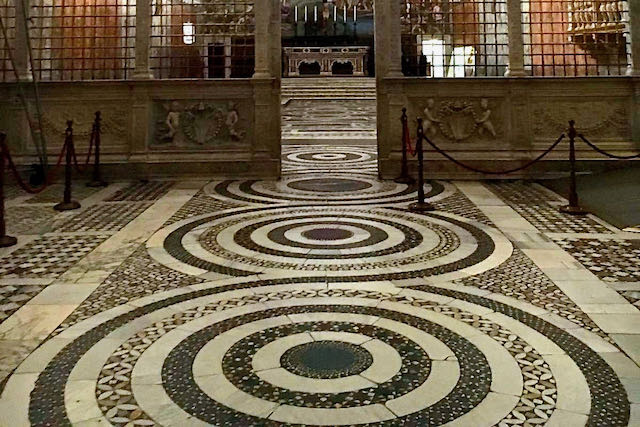
It's also included in some walking tours like this one.
Finally, in the last of my list of Vatican Museum Must Sees inside the Sistine Chapel, don't miss the wall panels underneath the ceiling.
Before Michelangelo came along and eclipsed their fame with his paintings, Pope Sixtus IV (for whom the Sistine Chapel is named), had the walls painted by Renaissance masters including: Sandro Botticelli , Pietro Perugino , Pinturicchio , and Domenico Ghirlandaio (one of Michelangelo's mentors.)
These frescos depict the Life of Moses and the Life of Christ, and truly are Vatican Museum Must Sees in their own right.
To conclude, there are many "Vatican Museum must sees", including works I've left off this list .
But I do hope this will give you some idea of things you might wish to include on your visit to the Vatican Museums, in particular, some things you might not have thought to see.
No matter what you see/don't see, a visit to the Vatican Museums is one of the most special, exciting, and beautiful things you can do in Rome !
Of course you already know by now that the Sistine Chapel is at the top of everyone's list of Vatican Museum must sees.
In fact, it may be the ONLY thing people want to see when they visit these museums.
But since it's not possible to see only the Sistine Chapel , I hope you will enjoy some of the other masterpieces there too.
Click here to visit the Vatican Museums website to view a map of the museums .
Did you know that if you book a visit to the Vatican Gardens , you automatically have a skip-the-line-ticket into the Vatican Museums?
Want to save this to Pinterest? Pin it here!
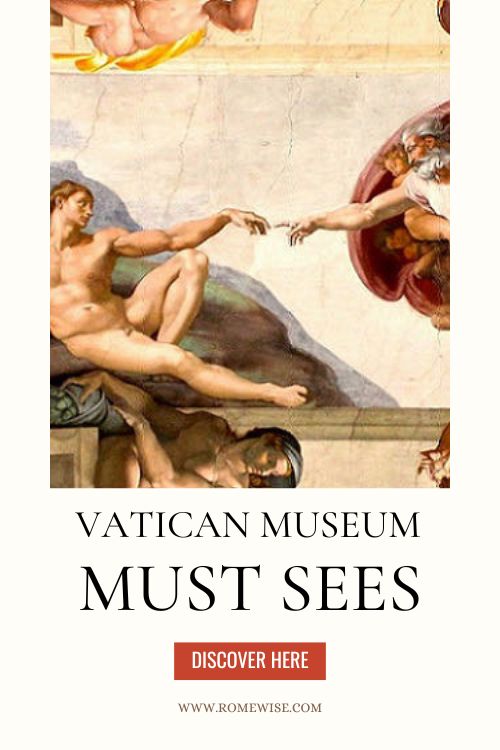
Get your 100% free Rome trip planner now!
Simply sign-up today for our free newsletter and get the Romewise Quick Start guide to Rome:
We are committed to respecting your data. Click for our Privacy Policy .
Comments? Questions? Suggestions?
Please come over to the private Romewise Facebook group and join in the conversation.
You will often find me there, happy to answer your questions / comments!
You will also meet other Rome lovers and experts, too.
What are you waiting for?
Come join in the fun !

Read here about our sponsorship policy
Top attractions and tours

- Colosseum - Don't miss visiting Rome's most iconic monument
- Vatican Museums - This is where the Sistine Chapel is
- Pantheon - Book ahead and skip the line
- Galleria Borghese - You'll need to book ahead for one of Rome's best museums
- Castel Sant'Angelo - See Rome's history through its architecture
- Rome City Pass - A great way to make your Rome visits easier
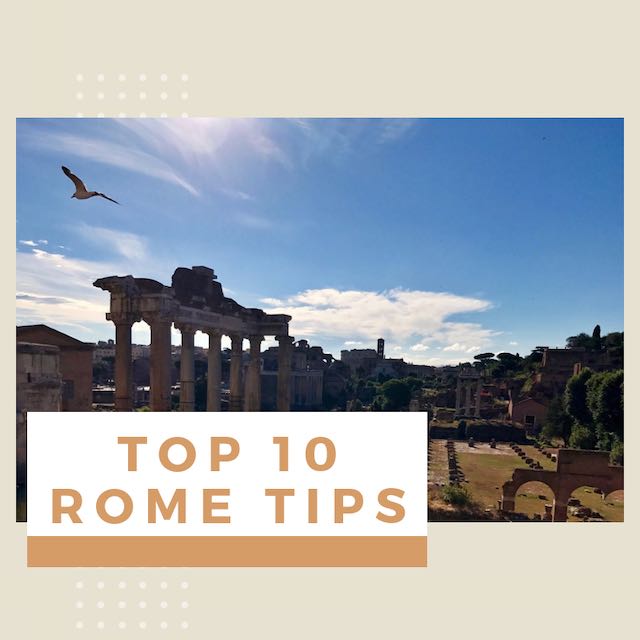
New to Romewise? Start Here
Get the most out of Romewise
Coming To Rome?
Weather in Rome
Accommodation
Already in Rome?
Things to Do
Home | About Me | Privacy Policy | Legal Disclaimer | Affiliate Disclosure | Contact Me
Copyright © 2009-2024 by Elyssa Bernard, Romewise.com | All Rights Reserved.
.png?w=auto&h=400)
Best Time to Visit Vatican Museums
Overview of best time to visit vatican museum.
The Vatican museums is one of the most visited attractions in Rome, drawing in millions of visitors from all over the world each year. To have the best experience, it is important to choose the best time to visit. The best time to visit the vatican museums is during the low season, which is from November to February, excluding the Christmas and New Year's holidays. During this period, the crowds are thinner, and you can explore the museums at your own pace without being jostled or squeezed in a crowded room. You can also book your tickets in advance, which is highly recommended to avoid waiting in long queues.
Another great time to visit the vatican museums is in the early morning, especially on weekdays. The museum opens at 9 am, and if you arrive at this time, you'll be among the first to enter. The early morning hours are quieter, with fewer visitors, giving you more time and space to appreciate the works of art. The Sistine Chapel is the most popular attraction in the museum and can get very crowded later in the day. If you want to visit the vatican museums during the high season, which is from March to October, the best time to do so is on Wednesday mornings. On this day, the Pope holds his weekly public audience at St. Peter's Square, and the museums don't open until noon. As a result, the crowd is thinner in the morning, allowing you to explore the museum before the mid-day rush.
It's important to note that the vatican museums are closed on Sundays, except for the last Sunday of the month when the entrance is free. However, visiting on this day is not recommended, as it is incredibly crowded, and the wait times can be several hours long. if you want to avoid crowds altogether, consider booking a private or small-group tour. These tours often provide exclusive access to parts of the museum that are closed to the general public, and you'll have an expert guide to show you around, explain the history and significance of the artworks, and answer any questions you may have.
Suggested Read : Inside Vatican Museums
Best Time of Year to Visit the Vatican Museums
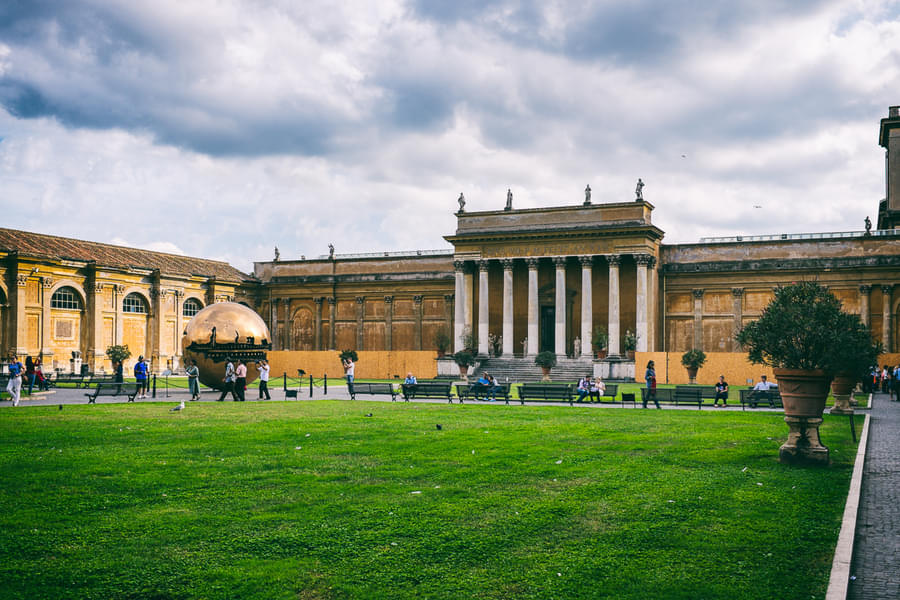
Regarded as an optimal period, spring emerges as a prime season for exploring the Vatican Museums. The climate typically offers mild conditions, while the visitor numbers remain comparatively modest compared to the bustling summer months. This affords a serene ambiance, allowing patrons to relish outdoor spaces like the Courtyard of the Pinecone and the Vatican Museums' Garden, adorned with vibrant blooms and verdant foliage.
Also Read : Vatican Dress Code
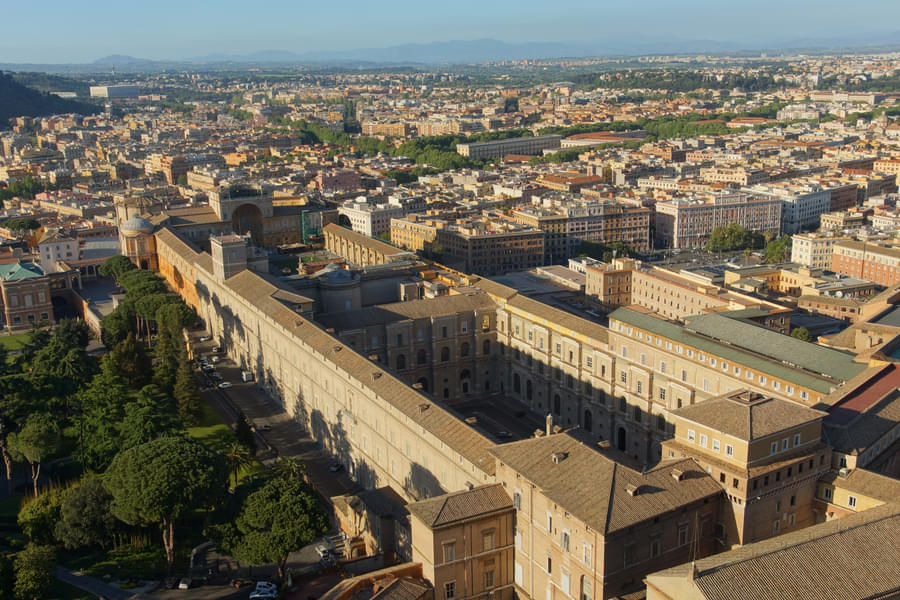
Summer marks the zenith of tourism in Rome, and the Vatican Museums duly reflect this trend. With sweltering heat and high humidity, the season sees a surge in visitor numbers, resulting in bustling crowds. Anticipate lengthy queues and delays when accessing the museum. Yet, a silver lining emerges in the form of extended evening hours (Fridays, April to October), affording an avenue to sidestep the daytime throngs. This strategic timing empowers visitors to savor the museum's offerings with a modicum of solitude amidst the city's vibrant summer energy.
Also Read: Vatican Museum Entrance
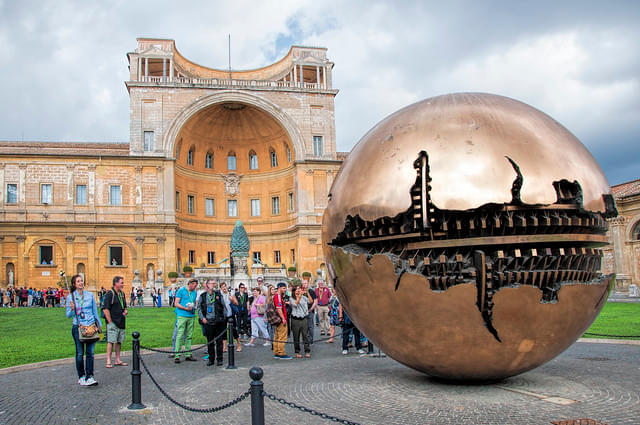
Autumn presents yet another opportune window to explore the Vatican Museums. The climate remains temperate, while visitor numbers subside from the summer peak. Amid this tranquil backdrop, the fall foliage graces outdoor spaces like the Courtyard of the Pinecone and the Vatican Museums' Garden, enhancing their allure. With fewer patrons, visitors can luxuriate in the exhibits without the sensation of haste or congestion, basking in an unhurried and more intimate encounter with the museum's treasures.
Suggested Read : Vatican Museums Rules
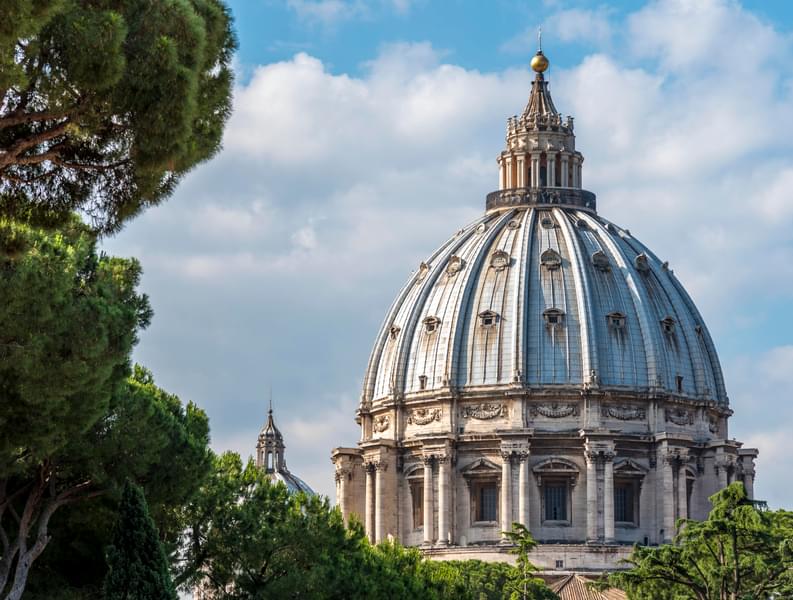
Winter emerges as the off-peak period for tourism in Rome, affording a quieter experience within the Vatican Museums. Despite the chilly and occasionally rainy weather, the galleries and showcases offer a cozy respite for visitors seeking refuge from the elements. Notably, extended hours on Friday evenings (November to March) unveil a unique chance to explore the museums when crowds are more sparse. This strategic timing grants a more intimate encounter with the exhibits, allowing patrons to immerse themselves in the treasures of the Vatican Museums without the usual hustle and bustle.
Suggested Read : Vatican Museums Facts
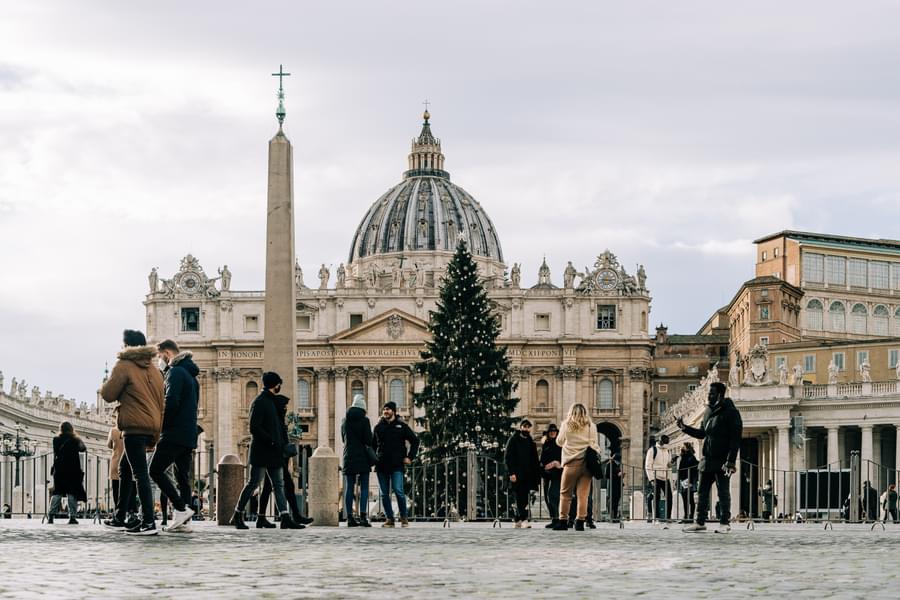
During the Christmas and Easter holidays, the Vatican Museums become sought-after havens for travelers. Yuletide brings the captivating Nativity scene and Christmas tree to St. Peter's Square, while the profound Holy Week observances mark Easter. These occasions draw crowds, contributing to heightened museum footfall. Prospective visitors are advised to strategize their plans conscientiously, bearing in mind the potential for larger gatherings during these cherished holiday seasons.
Also Read : Best Time to Visit Vatican Museums
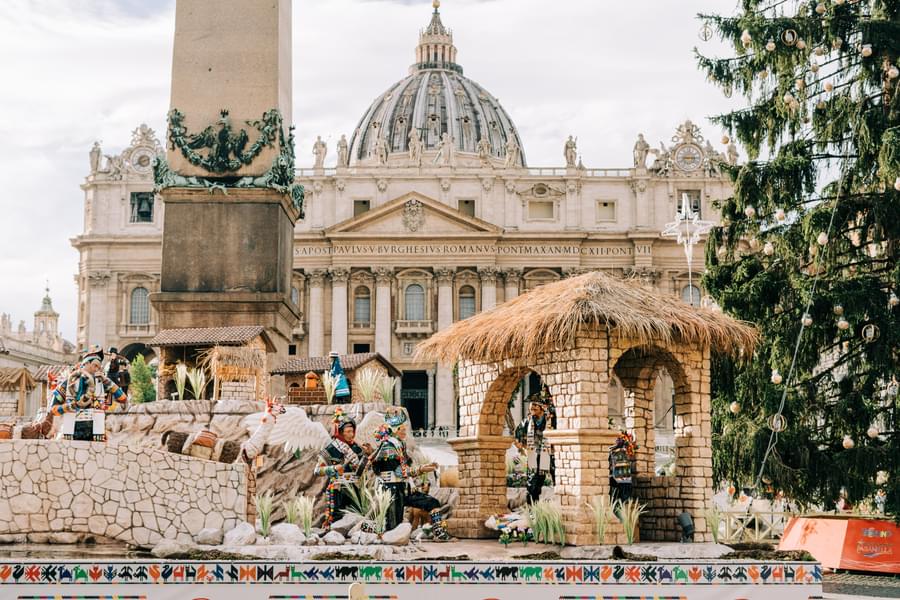
Throughout the year, the Vatican Museums curate a diverse array of special exhibitions and events, encompassing musical performances, artistic showcases, and cultural celebrations. To seize these distinctive occasions, visitors are encouraged to consult the museum's website or seek information regarding forthcoming events while organizing their visit, guaranteeing an enriched experience and the chance to partake in these exceptional opportunities.
Suggested Read : Vatican Museums Collections
Book Your Vatican Museums Tickets
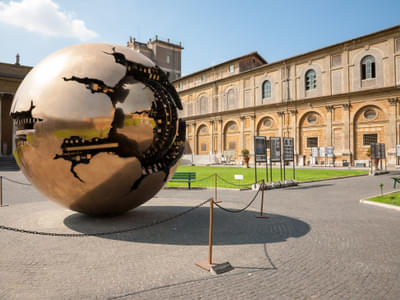
FAQs For Best Time To Visit Vatican Museum
What is the best time of year to visit the vatican museums.
The best time of year to visit the Vatican Museums is during the shoulder seasons of spring (April-May) and autumn (September-October). During these months, the crowds are smaller, and the weather is mild, making for a more enjoyable visit. Additionally, many seasonal events take place in the Vatican, such as Christmas and Easter, which can also be great times to visit.
What is the best time of day to visit the Vatican Museums?
The best time of day to visit the Vatican Museums is early in the morning or late in the afternoon, as these times tend to have fewer crowds. The museum opens at 9 am, so getting there early can help you beat the crowds and enjoy the museum more peacefully. Alternatively, visiting during the evening hours when the museum stays open until 6 pm can be another good option.
How can I avoid the crowds at the Vatican Museums?
To avoid the crowds at the Vatican Museums, you can visit during the shoulder seasons of spring and autumn, as mentioned earlier. You can also purchase a skip-the-line ticket or book a guided tour in advance to avoid waiting in long lines. Another option is to visit during the museum's extended evening hours, which are typically less crowded than during the day.
What should I wear when visiting the Vatican Museums?
It is recommended that visitors dress appropriately when visiting the Vatican Museums. This means wearing clothing that covers your shoulders, knees, and ankles. Sleeveless tops, shorts, and mini-skirts are not allowed. Comfortable shoes are also recommended, as the museum is quite large and involves a lot of walking.
Can I take photos in the Vatican Museums?
Photography is generally allowed in most parts of the Vatican Museums, but there are a few areas where it is not allowed, such as the Sistine Chapel. Flash photography is also not permitted. It is always best to check with the museum staff or your tour guide to make sure you are not breaking any rules.
Can I bring food or drinks to the Vatican Museums?
Food and drinks are not allowed inside the Vatican Museums, except for water. There are no restaurants or cafes inside the museum, so it is recommended that you eat before or after your visit. If you need to take a break, there are outdoor seating areas where you can enjoy a snack or drink.
Know More About Vatican
- Explore Vatican City
- Vatican Museums
- Inside Vatican Museums
- Visitor Guide
Explore Rome
- Attraction Tickets
- Travel Guide
.png?w=auto&h=400)
About Us | Contact Us | Email Us: [email protected] | Privacy Policy | Copyright Policies | Terms and Conditions
The content and images used on this site are copyright protected and copyrights vests with the respective owners.
When is the best time to visit the Vatican?
If you’re planning a visit to the Vatican Museums and Sistine Chapel and you have few days available, here is short “guide” for the best day to organize your Vatican City tour.
Whether you are going to join one of the so-called “ Vatican tour skip the line ” or you decide to go on your own, it is always useful to know a little bit more about the crowds at the Vatican.
St. Peter’s line
The time of the year :
The low season in Rome starts every year at the beginning of November until around 20 th December, when the Christmas period starts, and it finishes on the 6 th January. The high season every year starts around Easter and finishes at the end of October.
However, during the high season, the crowd flow can vary and it could be helpful to know when you could encounter more or less people accessing the Vatican Museums.
- Monday is one of the busiest days for the Vatican Museums as they are closed on Sundays. A lot of people don’t know about the closure day of the Vatican Museums and they leave the Vatican City tour as (the best and) the last on the check-list. Therefore, since early morning you will find people queuing at the entrance. If you have no choice you can join one of our “beat the crowds” solutions like the Early Vatican Tour with privileged access
- Tuesday can be a quiet day for the Vatican Museums and it can be a good choice for a visit. However, always check the Vatican calendar to see if there is any special ceremonies or Vatican City holidays when they close the Museums.
- Wednesday is the day of the Pope’s Audience . So if you are not planning to attend the Audience at the St Peters Square, this is the perfect time to visit the Vatican Museums . You should go in the morning and you will probably have a chance to see what is like when the Vatican Museums are almost empty.
- Thursday is not a particularly busy day for the Vatican except for the days when there is a holiday or some special ceremony in the Vatican.
- Friday can be considered one of the busiest days for the Vatican City . At any time you go, you will find crowds accessing the Museums. This is also because of the “long-weekend” holiday travelers.
- Saturday , together with Monday, is the busiest day at the Vatican . On Sundays the Vatican is closed and on Saturdays, at any time during the high season, you will always find a long line at the entrance.
In case you’ve already purchased or you’re planning to arrange a Vatican City tour , please keep in mind that all the guided tours organized by City Lights Tours are skip-the-line-tours . This means that you will skip the line at any time. The above-mentioned list can help you to organize your Vatican City tour better and to choose the day when there are less visitors inside the Museums.
Also in order to avoid the “big crowd” entering the Museums, you can always choose to join the Early morning Vatican tour that will allow you to enter one hour earlier than the general public.
In case you would like to have an unforgettable experience you can check this article about the Good Morning Vatican tour option and learn about the best tour option available for the Vatican Museums.
Essential Collection
COVID19 Rescheduling Policy: Book With Confidence! No Penalty For Rescheduling As Many Times As Necessary

- The Best Time to Visit the Vatican
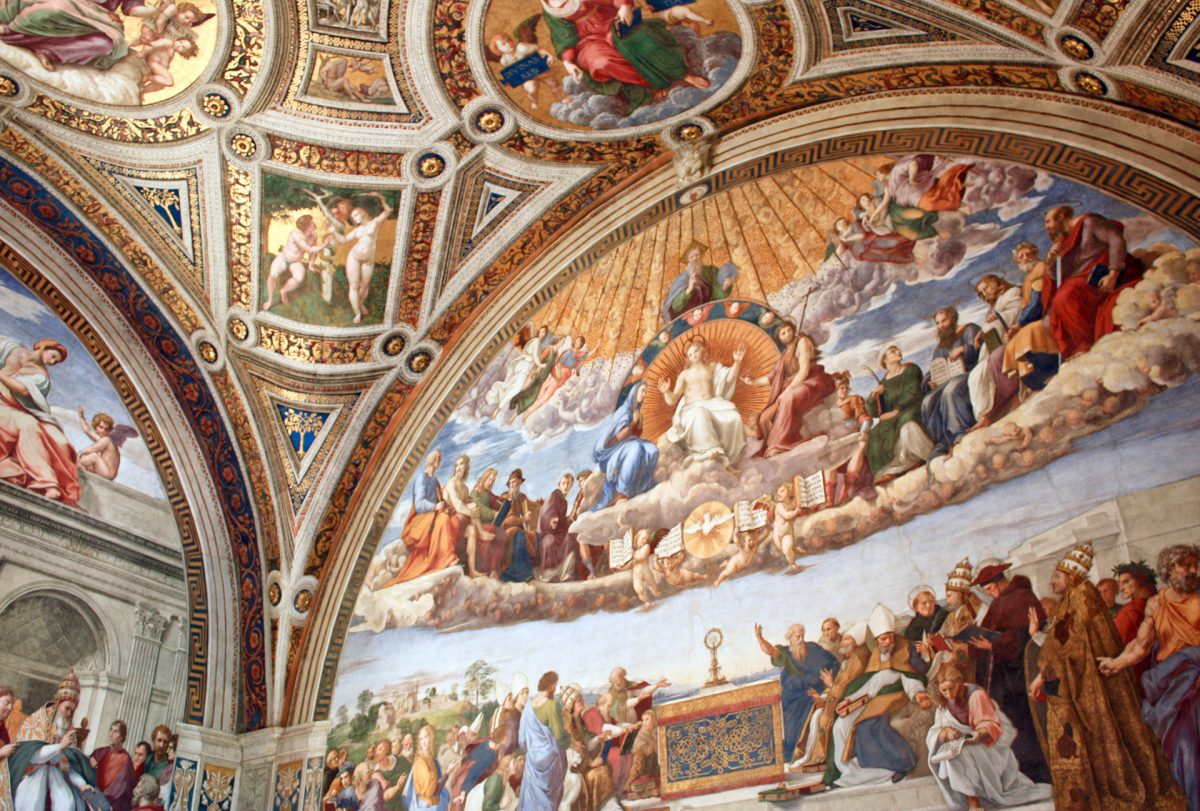
The Vatican is the most popular tourist destination in Rome. It attracts people from all over the globe during all times of the year, meaning that if you were looking forward to going visiting when there are fewer people then you’re out of luck. However, Tuesdays and Thursdays usually see fewer tourists around most of the attractions in the Vatican. It is better to avoid Wednesdays and weekends if you’re on a tight schedule because the city has a tendency to be a bit busier on those days.
On that note, April to October can be one of the best times to visit the Vatican Museums , especially on Friday nights, when it is much less crowded. Most tourist groups show up in the morning in hopes to beat the crowds, but it usually works against them. In fact, you can find the Vatican Museums a bit less crowded during the afternoon hours.
No matter what, never plan your visit to the St. Peter’s Basilica or the Vatican Museums on a Saturday because Rome gets its maximum number of visitors from different parts of Italy and Europe during the weekends. Note that the Vatican Museums stay closed on Sundays, with the exception of the last Sunday of each month. With that being said, the Vatican Museums are free on the last Sunday of every month so you can expect a huge crowd there if you go for a visit.
The Pope holds an audience at St. Peter’s Basilica every Wednesday of the month except for the month of July. During the summertime, the gathering is in the St. Peter’s Square, while it is held in the auditorium-type hall near to the St. Peter’s Basilica during the winter season. As thousands of people attend the Papal Audience, the entire area tends to be heavily crowded on every Wednesday of the month. Keeping that in mind, many of the visitors attending the gathering in the courts of St. Peter’s Basilica also visit the Vatican Museums after the mass.
In general, the winter months see smaller crowds in the Vatican. Therefore, you can plan a visit to the Roman city from December to February to have a more relaxed experience and explore the Vatican at your own pace. To avoid crowds, you should take care to avoid going around Christmas and New Year’s unless absolutely necessary. You can always consult with your Rome and Vatican City guide for help with the bookings.

Visit The 10 Largest Museums In The World
- Museums offer a glimpse into humanity's past and culture through their art, artifacts, and photographs. Discover the largest museums around the world to visit!
- From London's Tate Modern to Tokyo's National Museum, these museums house thousands of incredible works of art that highlight history and culture.
- The Metropolitan Museum of Art in NYC and the Louvre in Paris are among the world's largest museums, enticing millions of visitors with their vast collections.
Museums are an insight into humanity's past and culture through their collections of art, archeological artifacts, photographs, and more. Wherever travelers go, they are likely to cross paths with a museum and its unique collections.
Destinations like New York City and London are home to the world's largest museums, attracting hundreds of thousands (if not millions) of visitors annually! Still, there are plenty more to discover across the globe; these are some of the largest museums around the world to visit.
Related: The 11 Best Museums In Florida You Need To Visit
Tate Modern
London is a treasure trove of incredible museums and cultural wonders, including the captivating exhibits at Tate Modern. Since 1897 , Tate Modern has displayed British art from the 16th century to the modern age, set inside the former Bankside Power Station along the River Thames.
Come and peruse nearly 70,000 works of art, especially from legendary artists like Pablo Picasso, Henri Matisse, and Barbara Hepworth.
- Address: Bankside, London SE1 9TG, United Kingdom
- Size: 371,350 square feet sq ft
The Bankside Power Station was built with about 4.2 million bricks!
Tokyo National Museum
Tokyo offers so much to do and see and is particularly renowned for its blend of high-tech urban exploration with deep dives of history and nature. Explore history at the Tokyo Metro National Museum in Ueno Park, which highlights artifacts, art, and other archeological finds primarily from Japan and other parts of Asia.
The TNM houses around 120,000 objects —89 of them are national treasures, while 649 of these objects are vital cultural properties!
- Address: 13-9 Uenokoen, Taito City, Tokyo 110-8712, Japan
- Size: 410,000 sq ft
RELATED: 10 Landmarks In Japan That Have Us Booking Our Tokyo Flights Right Now
Vatican Museums
The Vatican Museums are Vatican City's public museums , exhibiting artworks collected by the Catholic Church and popes since the 15th century . This complex includes 54 galleries and has welcomed guests for 500 years.
Every year, visitors visit the Vatican Museums to view timeless masterpieces and archeological exhibits, especially the frescoes at the Sistine Chapel. There are about 70,000 works at the Vatican Museums, and only 20,000 are on public display!
- Address: 00120 Vatican City
- Size: 460,000 sq ft
Museo Nacional Del Prado
Madrid's Museo Nacional del Prado—or the Prado Museum—has the world's most extensive collection of Spanish artworks (though it also houses Italian and Flemish art) from the 12th to the early 20th centuries. Spain's museum is one of the planet's greatest (and most visited) art museums!
The museum's historic building is also impressive, built by architect Juan de Villanueva in 1785 . Visitors can see some of the world's most notable paintings, including Hieronymus Bosch's The Garden of Earthy Delights and Francisco Goya's The Third of May .
- Address: C. de Ruiz de Alarcón, 23, 28014 Madrid, Spain
- Size: 513,000 sq ft
RELATED: Just A Short Day Trip From Madrid, This Spanish Castle Is Worth Visiting
Metropolitan Museum Of Art
New York City is one of the numerous American cities with the best museums in the US, including The Metropolitan Museum of Art or "The Met." Incorporated in 1870 , The Met represents over 5,000 years of art worldwide!
Travelers can explore the museum's extensive collection of historic artifacts and timeless art, including its 26,000 objects in the Egyptian Art collection or 50,000 works inside the European Sculpture and Decorative Arts wing.
- Address: 1000 5th Ave, New York, NY 10028, United States
- Size: 633,100 sq ft (though building size is reportedly 2 million sq ft )
Consider venturing from The Big Apple to visit the many incredible museums outside New York City !
Known as the Musée du Louvre or the Grand Louvre, the Louvre is one of the world's largest museums. This attraction houses close to 35,000 artworks ! A Parisian icon since its opening on August 1793, the museum is built inside the Palais du Louvre, dating back to the 12th century as a fortress.
The Louvre offers a wealth of exhibits and remains one of the most famous museums in the world; not only that, but it's also consistently ranked among the most popular museums worldwide, featuring displays from ancient civilizations to the mid-19th century.
- Address: 75001 Paris, France
- Size: 652,300 sq ft
National Museum Of Anthropology
Mexico City's Museo Nacional de Antropología houses the world's most extensive collection of art and exhibits from Ancient Mexico and the country's indigenous community, with 23 permanent exhibit halls .
Discover nearly 600,000 artworks and objects at this extensive museum, featuring exhibits like the Aztec Sun Stone and Olmec's "Group of Figures."
- Address: Av. P.º de la Reforma s/n, Polanco, Bosque de Chapultepec I Secc, Miguel Hidalgo, 11560 Ciudad de México, CDMX, Mexico
- Size: 857,890 sq ft
RELATED: From Adventure To Relaxation: 10 Best Islands In China To Experience
National Museum Of China
Located on the east flank of Tiananmen Square, this Beijing landmark is the largest in the country and one of the world's largest museums. The National Museum of China highlights the country's history and heritage, with over 1.4 million objects and works .
Works like The Founding Ceremony , Oil Painting Climbing Over the Snow Mountain , and Nanchang Uprising can be found at the museum, as well as other displays, including the replica bones of the Peking Man and more.
- Address: 16 E Chang'an St, 前门 Dongcheng, China, 100051
- Size: Floor space measures about 2,153,000 sq ft
State Hermitage Museum
St. Petersburg's State Hermitage Museum is one of the world's largest museums, housing antiquities and works from the Stone Age to the modern age. The State Hermitage Museum inventory has 3,150,428 items , from archeological artifacts to rare books.
Most of the museum's collection sits inside the elegance of The Winter Palace, a Baroque-style architecture from the 18th century.
- Address: Palace Square, 2, St Petersburg, Russia, 190000
- Size: 719,480 sq ft
British Museum
Over 8 million objects make up the British Museum collection , with about 80,000 items on public display (only 1% of its collection!). This London museum was founded in 1753 and features an array of human history and culture, from its ancient past to the modern age.
The British Museum is one of the world's most-visited museums, with millions of visitors drawn to its collection, especially the Rosetta Stone (known as the " Cracker of the Hieroglyhs ") and the Greek Elgin Marbles.
- Address: Great Russell St, London WC1B 3DG, United Kingdom
- Size: 990,000 sq ft
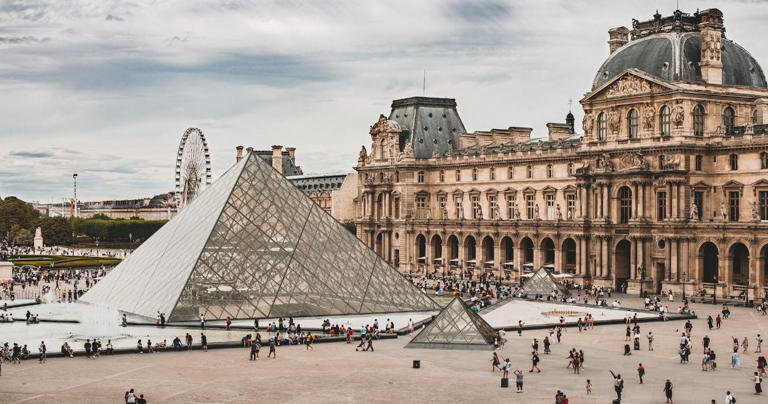

IMAGES
VIDEO
COMMENTS
It has always been said that the busiest day of the year to visit the Vatican is the 16th of August. This is due to the fact that the Vatican closes on the 14th and 15th of August every year for the feast of St Peter and St Paul. The 27th of December is not too far behind in terms of crowds due to the Vatican being closed on Christmas Day and ...
Vatican City is a separate state from Italy, with just over 500 residents. The two main places to visit are Saint Peter's Basilica and the Vatican Museums (where the Sistine Chapel is.) The pope is head of Vatican City. The pope's church is not Saint Peter's Basilica. It is Saint John in Lateran.
The best day to visit the Vatican Museums is Tuesday or Thursday. These are both unsuspecting days where you can count on the least amount of crowds and tour buses to spoil your visit. Although Friday daylight hours are busy, Friday evening at the Vatican Museums is one of the most underrated times to visit. Many tourists choose alternative ...
It's best to visit the Vatican during the week because weekends are generally very busy. A good day to visit the Vatican is Friday. If you come to Rome in the summer you should use this day as the museums are open late from 7 to 11 pm. But keep in mind to register beforehand, regardless of the season! Wednesday is a rather bad day to visit ...
Opening hours. Monday - Saturday: 9 am - 6 pm (last entrance at 4 pm) Sunday: closed (except the last Sunday of every month when the museums are free) Museum closed on the following days In addition to most Sundays, 1 January, 11 February 19 March, 22 April, 1 May, 29 June, 14 and 15 August, 1 November, 25 and 26 December See the best time ...
Address. 00120, Vatican City. Phone +39 06 6988 4676. Web Visit website. The Vatican Museums ( Musei Vaticani), located in the Vatican City, are one of the attractions you must see on a visit to Rome. Here you will find priceless artworks, from Egyptian and Roman antiquities to paintings by the most important artists of the Renaissance.
Tuesday February 07 2023, 2.34am, The Times. E nveloped by the Eternal City of Rome, the Vatican is the world's smallest state. Measuring just 0.17 square miles, it bursts with cultural ...
Important Tips for Visiting the Vatican Museums. The Vatican Museums house the largest private art collection in the world-and despite the enormous amount of art and historical artifacts displayed, only the tiniest sliver of the complete collection is on display to the public! Beautiful, overwhelming, and one of the most highly sought-after ...
Rome in a Day Tour with Colosseum and Vatican Museums. Our "in a day" tour is best way to get your bearings all in one day. Visit the Sistine Chapel, Colosseum, Trevi Fountain, and more with a licensed, fun English-speaking tour guide. They'll add tons of insights and make the entire experience so much more memorable.
What is the Best Day of the Week to Visit Vatican Museums? Starting January 1st, 2024, the Vatican Museums are open Monday - Saturday, 8am - 7pm. For the high tourist season in spring and summer, beginning March 2024, the museums will also extend their opening hours on Fridays and Saturdays to 8pm.
The two months that are best are March and April, which usually has warm weather and a few crowds but nothing like the high levels you see in high season. What Day to Visit the Vatican? Vatican Museums are open six days a week, with the exception of Sunday. Which is only open on the last Sunday of every month, when from 9 am - 12:30 pm, the ...
Plan ahead. First and foremost, you need to accept the idea that you can't just show up at the entrance of the Vatican Museums and get in straight away. There will be a long queue or it might even be closed, so if you haven't done a minimum of planning, you might end up wasting time and missing one of the best places to visit in Rome.
Opening days and times 2024. From Monday to Saturday 08.00 a.m. - 07.00 p.m. (final entry 05.00 p.m.) From 1 March On Fridays and Saturdays extended opening hours until 08.00 p.m. (final entry 06.00 p.m.)Every last Sunday of the month
Everything you need to know before visiting Rome. Vatican Museums on the cheap. The absolute cheapest route is booking admission tickets directly (do it well in advance, up to 60 days), which nets you an unprecedented laundry list of world-class art for less than the price of a gourmet pizza back home (adult/reduced €17/€8 plus a €4 reservation fee and optional audio guide €7).
Here is a list of the top attractions to look for when you visit the Vatican Museums including key works of art, archeological areas, architecture and more. For a complete list, visit the Vatican Museums website. ... The 14 Best Day Trips from Rome The 25 Top Attractions in Rome, Italy 10 Unique Guided Tours in Rome 3 Days in Rome: What to See ...
From Monday through Thursday, the museums are open from 9:00 am to 6:00 pm, with final entry at 4:00 pm. On Fridays and Saturdays, the museums close at 10:30 pm, with final entry at 8:30 pm. The Vatican Museums are closed on Sundays. However, every last Sunday of the month, you can visit between 9:00 am - 2:00 pm.
The Vatican Pinacoteca is essentially a small painting gallery within the Vatican museums. It opened in 1930 and contains the papal easel collection. The gallery gives you a historic and chronological overview of the development of Western painting. 18 rooms hold the Vatican's most precious paintings.
What time in the day is best to visit these 3 places and the order of visiting? ... You start very early, get into the Vatican Museums and Sistine Chapel at 8 am before the general public, and have some much more sane, quiet and cooler time there, before the crowds and heat begin to fill the facilities after 9 am. ...
In my 3-day itinerary, you'll see all the major must-see Rome attractions like the Vatican, Colosseum, Trevi Fountain, Pantheon, Piazza Navona, Spanish Steps, Castel Sant'Angelo, and much more. And if you have more time, or want suggestions for extra/other things to do, you'll find that there too.
The best time of day to visit the Vatican Museums is early in the morning or late in the afternoon, as these times tend to have fewer crowds. The museum opens at 9 am, so getting there early can help you beat the crowds and enjoy the museum more peacefully. Alternatively, visiting during the evening hours when the museum stays open until 6 pm ...
Friday can be considered one of the busiest days for the Vatican City. At any time you go, you will find crowds accessing the Museums. This is also because of the "long-weekend" holiday travelers. Saturday, together with Monday, is the busiest day at the Vatican. On Sundays the Vatican is closed and on Saturdays, at any time during the high ...
On that note, April to October can be one of the best times to visit the Vatican Museums, especially on Friday nights, when it is much less crowded. Most tourist groups show up in the morning in hopes to beat the crowds, but it usually works against them. In fact, you can find the Vatican Museums a bit less crowded during the afternoon hours.
The State Hermitage Museum inventory has 3,150,428 items. Address: Palace Square, 2, St Petersburg, Russia, 190000. Size: 719,480 sq ft. Over 8 million objects make up the British Museum ...